The Zoo is free to visit, but entry passes are required for all guests, including infants.
Today's hours: 8 a.m. to 6 p.m. (last entry 5 p.m.)
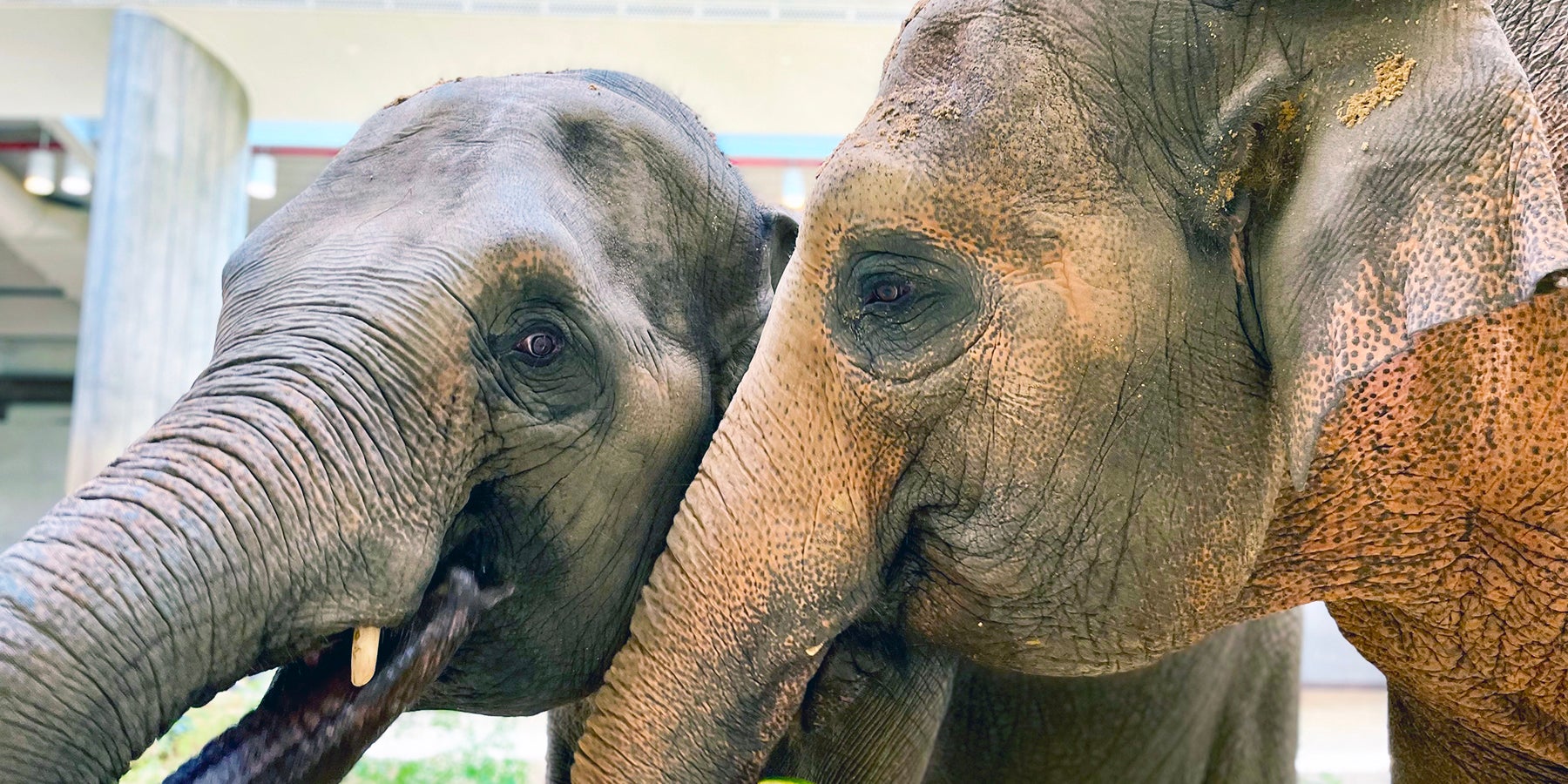
Elephant Cam
See the Smithsonian's National Zoo's Asian elephants — Spike, Bozie, Kamala, Swarna and Maharani — both inside the Elephant Community Center and outside in their yards.
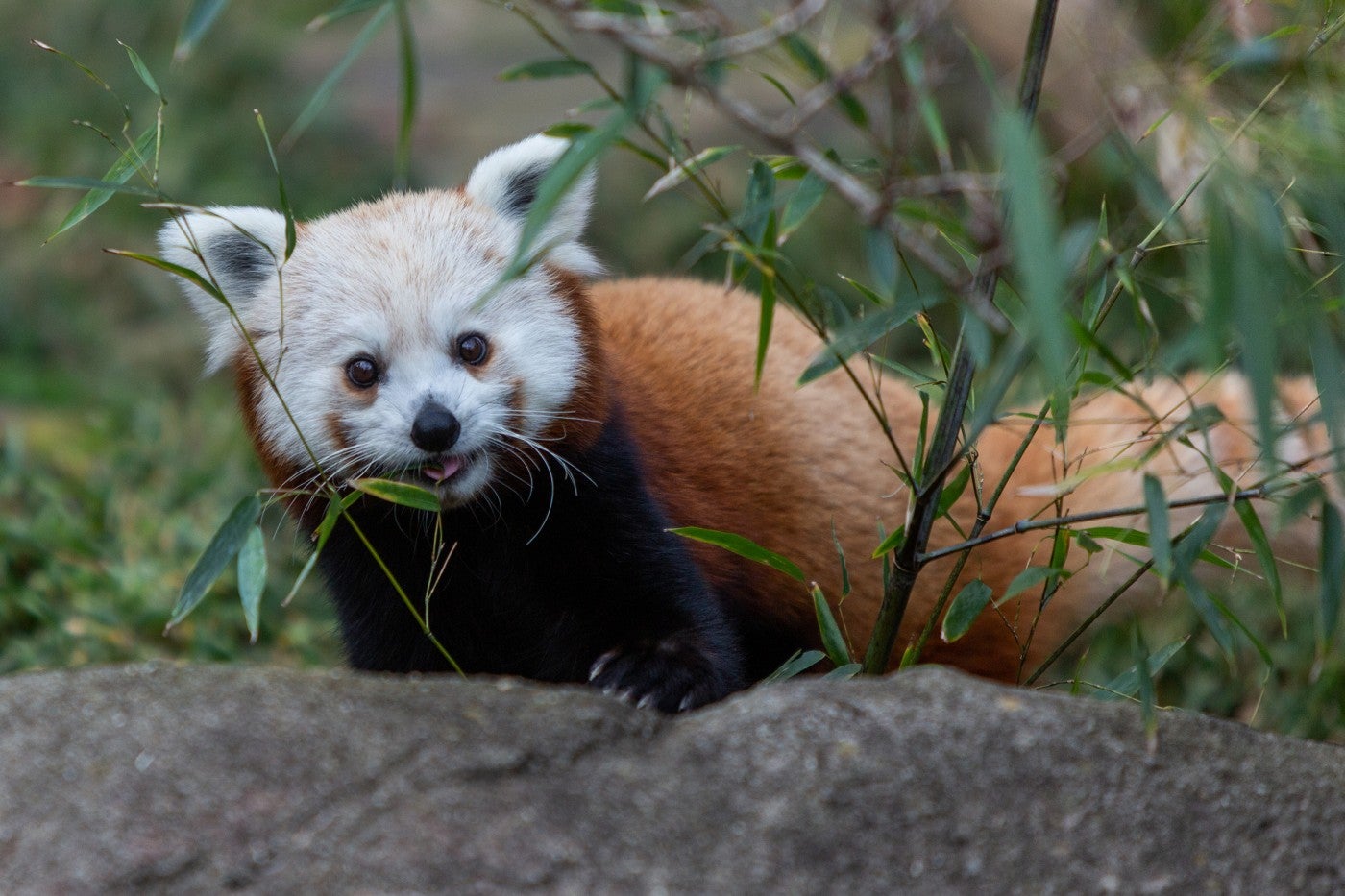
Now more than ever, we need your support. Make a donation to the Smithsonian's National Zoo and Conservation Biology Institute today!

Become a Member
Members are our strongest champions of animal conservation and wildlife research. When you become a member, you also receive exclusive benefits, like special opportunities to meet animals, discounts at Zoo stores and more.
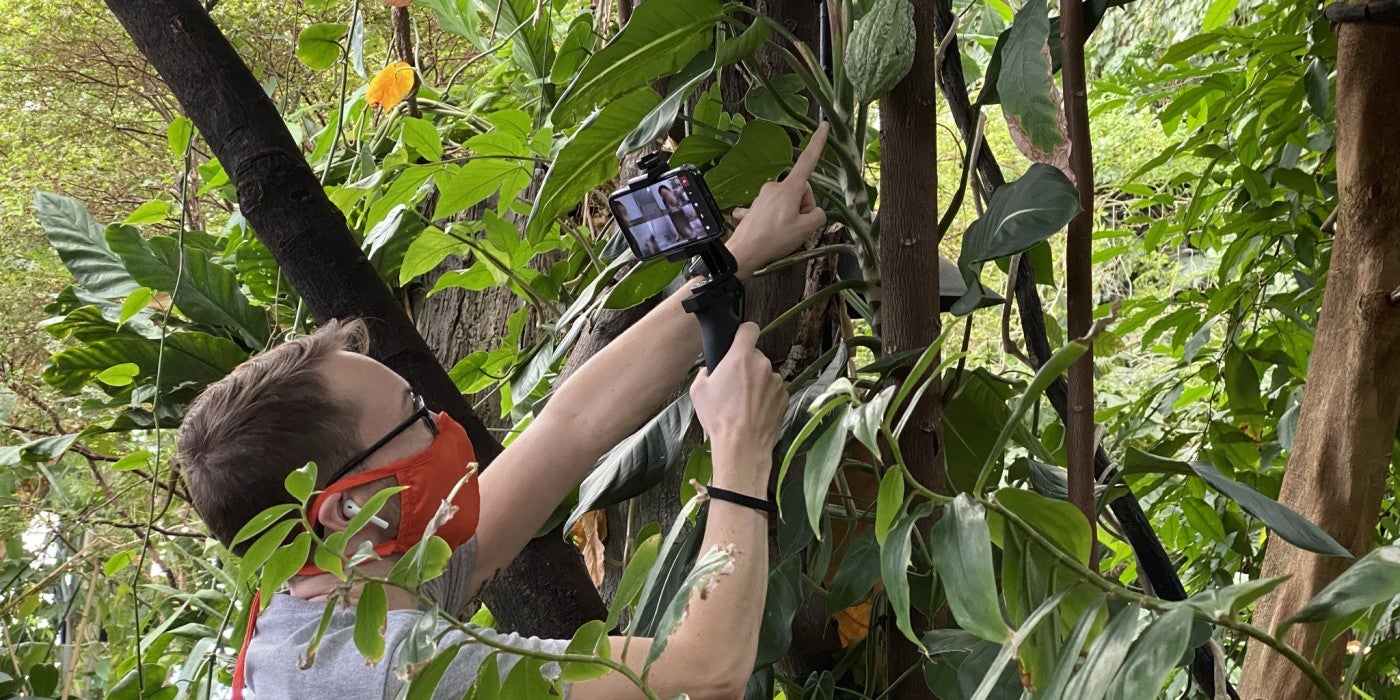
Education Calendar
Find and register for free programs and webinars.
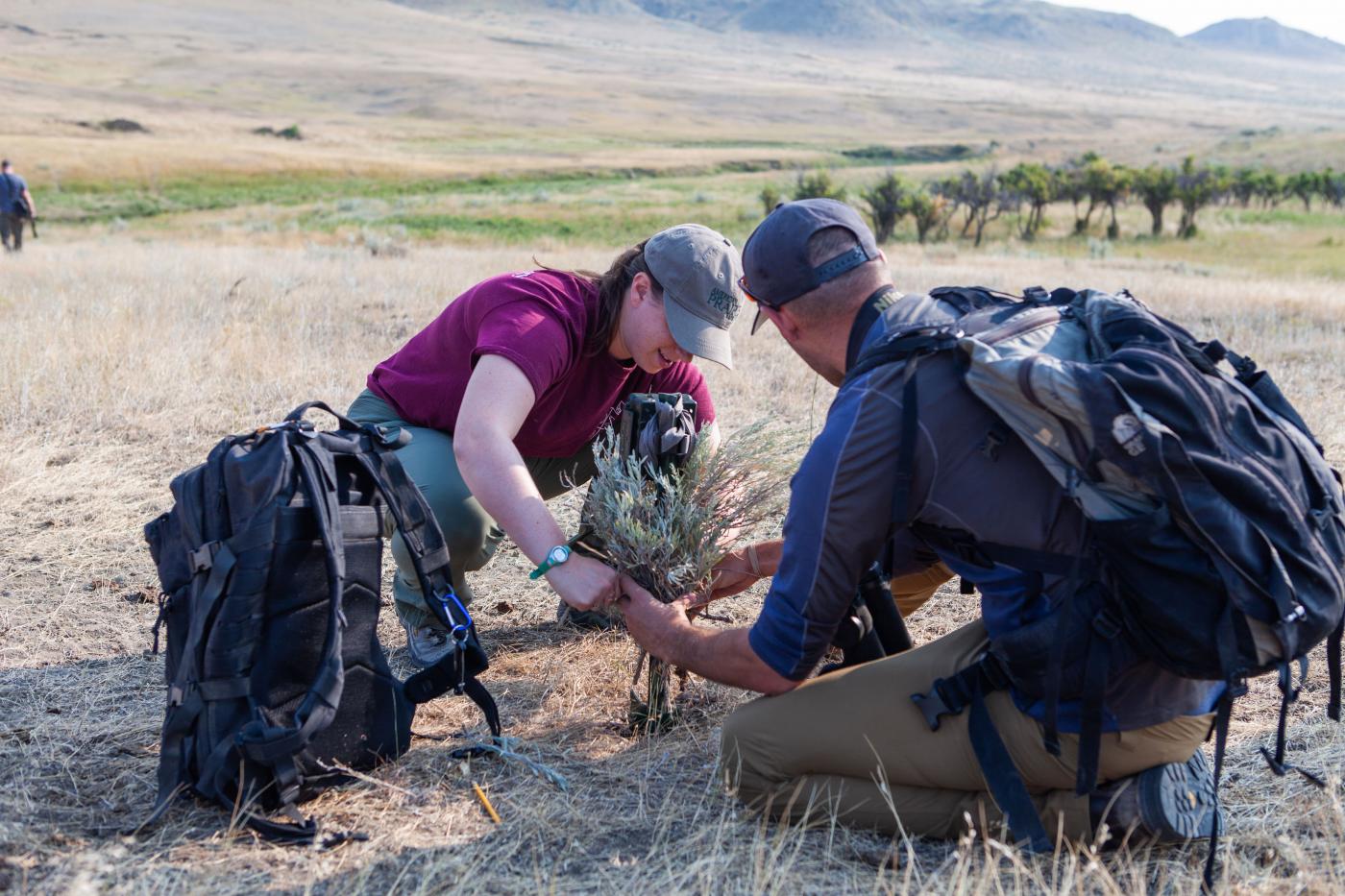
About the Smithsonian Conservation Biology Institute
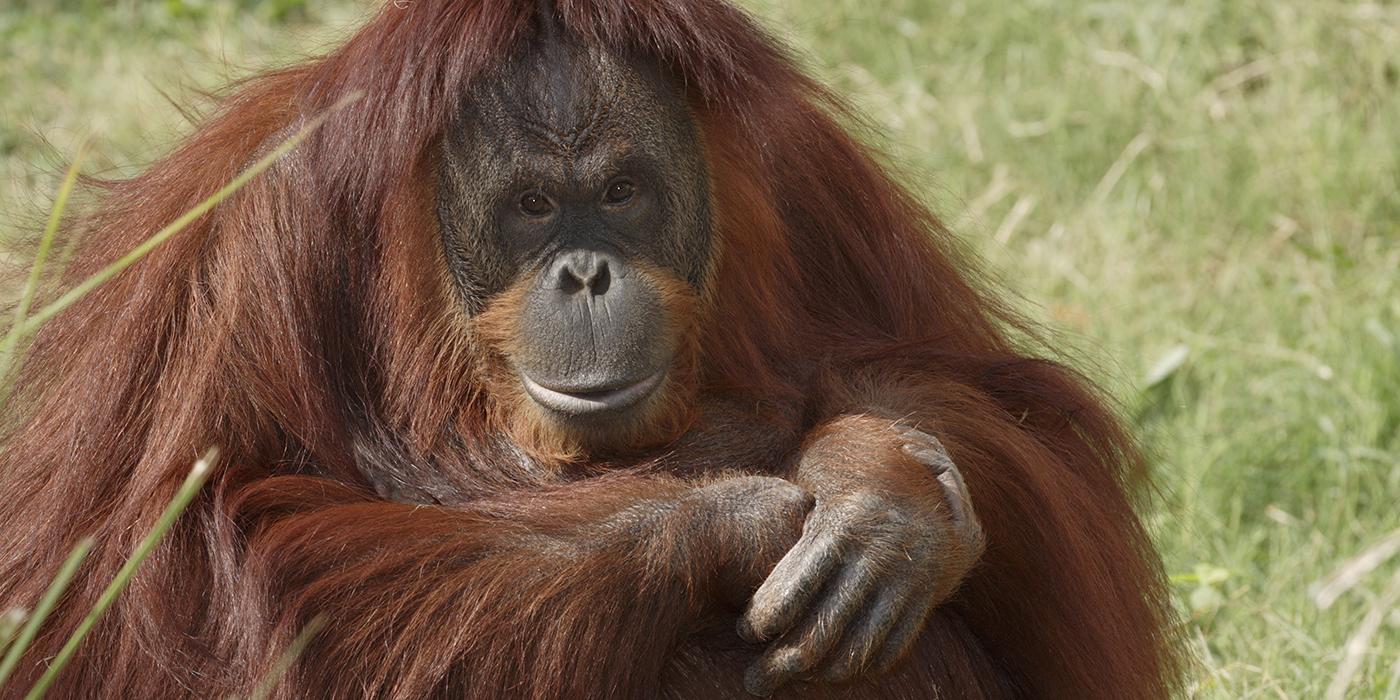

Pongo abelii
Pongo pygmaeus.
- Conservation
Physical Description
Orangutans have long, sparse orange or reddish hair unequally distributed over their bodies. They have large jaws and flattened noses in concave faces.
Orangutans are the largest arboreal mammals and are very well adapted to life in the trees, with arms much longer than their legs. They have grasping hands and feet with long curved fingers and toes. They have distinctive fingerprints and no visible external tails.
You can typically tell male and female orangutans apart by looking at them. Males and females have flabby throat sacs, which become very large in adult males. Adult males have deep chests and much longer body hair than females do. Males also typically develop large cheek pads, which demonstrate genetic fitness and amplify their long calls.
Orangutans can brachiate — swing hand over hand — but they normally move cautiously through large trees by climbing and walking. This allows them to distribute their weight among the branches. Orangutans' hands make them graceful and swift while swinging, but it makes walking on the ground very slow and awkward.
Orangutans sometimes travel on the ground when going long distances because appropriate sized branches may not always be available. When on the ground, they use all four limbs, supporting themselves on the sides of clenched fists, or occasionally walk on upright on two legs. Orangutans also come down if there is a need to find food and water elsewhere, for example, if there is a drought or fire.
It can be difficult to tell Sumatran and Bornean orangutans apart. Generally, Sumatran orangutans are lighter in color, have longer body hair and less pendulous throat sacs than Bornean orangutans, but the only reliable way to tell the difference between Sumatran and Bornean orangutans is by looking at their chromosomes.
Wild adult females weigh between 80 and 120 pounds (36 and 54 kilograms), while wild adult males weigh 170 and 220 pounds (77 and 100 kilograms). Animals in zoos tend to be 50 to 100 pounds (23 to 45 kilograms) heavier due to a consistent supply of high quality food.
Native Habitat
Orangutans live on the Indonesian island of Sumatra and in both the Malaysian and Indonesian portions of the island of Borneo. They are highly arboreal and live in all levels of the forest, from floor to canopy. Habitats range from peat swamp forests near sea level to mountainous forests almost a mile (1.6 kilometers) above sea level. As humans have moved into the lower elevations — the orangutan's original habitat — orangutans have moved up the mountainsides.
The median life expectancy for male Bornean orangutans is about 27 years and for male Sumatran orangutans is about 25 years. The median life expectancy for female Sumatran orangutans is about 32 years. There is not enough available data on the life expectancy of female Bornean orangutans.
Communication
Orangutans are more solitary than other great apes and do not have as complicated a vocal repertoire as some of the more gregarious primates. Orangutans rely more on facial expressions and body language to communicate. Among the vocalizations they use are kiss-squeak and belching vocalizations when they are upset, and a loud, deep long call used typically by males for long-distance communication.
This long call resonates in the male's enlarged throat sac and echoes through the forest. It is used to locate and advertise the male's presence to females or warn other males away. It can be heard a kilometer or more away (more than half a mile). Certain vocalizations such as nest smacks and throat scrapes are considered cultural and are found in some populations of wild orangutans but not in others.
Food/Eating Habits
Orangutans eat primarily fruit and play an important role dispersing seeds through defecation. Although they spend a majority of their total foraging time feeding on fruits whenever they are available, orangutans also eat insects and flowers, and during times of fruit scarcity, fall back on a variety of other types of food, including inner bark, leaves, and other vegetation. Orangutans have also been observed eating mineral-rich soil, bird eggs and, occasionally, small mammals such as rats and slow lorises. Orangutans get water from a variety of sources, including tree holes and leaves that fill with water during the rainy season.
When water is difficult to reach, orangutans chew leaves to make a pulpy sponge to soak up the water. Orangutans in some wild populations modify small sticks, which they hold in their lips while probing in tree trunks for food such as honey. Orangutans exhibit a variety of geographically variable innovative behaviors, some of which are considered cultural. Among these behaviors are certain forms of tool-use, including the modification of sticks by a population of Sumatran orangutans to open Neesia fruits and more efficiently harvest their seeds.
Orangutans have a long period of infant dependency (weaning around age six or seven) with exceptionally long inter-birth intervals (at least eight years in Sumatran orangutans and a little bit shorter in Bornean orangutans). This may be at least partially due to diet. Mothers teach their infants what food to eat, where to find that food, in which trees and during which seasons. Young orangutans must learn about hundreds of varieties of fruit, where to find them seasonally and how to open them.
In the morning, the orangutans at the Zoo are often fed together. Food items are cut up and spread over a wide area. In the afternoon, individuals are separated so each animal gets its share of preferred food items. In the morning, the animals are given greens, green beans, carrots, broccoli and primate chow. In the evening, they are given bananas, apples, primate chow, greens and a selection of other fruits and vegetables. Forage items placed in hay for the orangutans include air-popped popcorn, diced fruits and veggies, beans and sunflower seeds. Browse (fresh tree trimmings) is given daily.
Sleep Habits
Orangutans typically build sleeping nests above the ground in various positions of one or more trees. They usually build and sleep in a fresh nest each night, but they will sometimes re-enter or rebuild an older nest. They will also sometimes nap in a less carefully constructed day nest.
Social Structure
Orangutans live semi-solitary lives in the wild. While they are the most solitary of the great apes, it should be noted that orangutans are highly social and exhibit social tolerance during times of high fruit abundance when they come together in aggregations known as parties.
Adult females travel through the forest with their dependent offspring. Females do not live in tight social groups, but they are familiar with and have relationships with other females in the area. Adult males have large home ranges that overlap those of multiple females. Males typically range alone except when they mate with females, forming consortships that last up to several weeks. Males may also join other orangutans of various sexes and ages in feeding aggregations. Individuals within a certain range appear to know others and interact comfortably when they encounter each other.
Flanged males (males with flanges, also known as cheek pads) use long calls to attract females and to discourage the approach of other males. Throat sacs add resonance to long calls, which are specific to individual males. Orangutans of all ages and sexes give kiss squeak vocalizations, engage in branch-shaking displays and sometimes even uproot dead trees when confronted by unknown individuals or when they are not habituated to the presence of human observers. In zoos, displays consist of throwing around tubs and other objects.
Orangutans' social structure is connected to the distribution of food resources, primarily fruit. Orangutans spread out to get enough to eat throughout the year. Because they exhibit high social tolerance, orangutans are quite adaptable to living together when food is plentiful and when there is adequate housing space, such as at the Smithsonian's National Zoo. Animals will segregate themselves as needed, and as males mature, they may become more territorial and often must be housed separately.
Reproduction and Development
Orangutans usually have a single baby, and twins are rare. Gestation is seven-and-a-half to eight-and-a-half months. From birth, orangutan infants cling to their mothers as they maneuver through the trees. The orangutan has the longest period of dependence on the mother of any other land-dwelling animal, including humans. Infant orangutans can nurse until they are six to seven years old. However, weaning is highly variable, depending on the mother. It is thought that weaning occurs sooner if food is abundant and the infant can switch to solids.
A female will only have a baby about every seven to nine years, resulting in only four to five babies in her lifetime. The inter-birth interval is somewhat longer in Sumatran orangutans than it is in Bornean orangutans; researchers are still trying to determine why this is the case.
After reaching adolescence at four or five years, these animals become increasingly independent of their mothers. Sexual maturity for males and females in zoos is around six years, although it can take up to 10 years or more for a wild female to mature and longer than that for males. Females may stay with their mothers until they are well into their teens, allowing them to observe mothering skills as they watch their younger siblings being raised. Physical maturity, especially in males, may not be reached for several years after sexual maturity.
The presence of a fully mature dominant male may suppress secondary sexual characteristics (long hair, face pads, beards and enlarged throat sacs) in other less dominant males, and, in some cases, a wild male orangutan may never develop cheek pads. This suppression of secondary sexual characteristic does not, however, suppress his fertility, and it has been shown that unflanged male orangutans are as successful in siring offspring as fully flanged males.
Most animals copulate only when the female is ovulating, but orangutans may copulate daily during several-day long consortships in the wild or when housed together socially in zoos. Research indicates that ovulating females seek out adult males for copulation. Females and males usually mate willingly, but sometimes a male will pursue a female and forcibly copulate with her. Both are natural behaviors for wild and zoo orangutans.
Conservation Efforts
Bornean, Sumatran and Tapanuli orangutans are critically endangered.
The risk of extinction for the critically endangered Bornean orangutan is very high. Their population levels have dropped more than 50 percent over the past 60 years, and their habitat has declined by over 80 percent in the past 20 years. The total population of wild Bornean orangutans is estimated to be approximately 70,000-100,000 individuals. On Sumatra, the orangutan population is approximately 13,800 individuals. The Tapanuli orangutan populations is approximately 800 individuals.
The inaccessibility of much of their range, poor visibility in dense forests and the nature of the animals makes it difficult to survey with precision. Sumatran orangutans are listed among the 25 most endangered primates in the world and Bornean, Sumatran and Tapanuli orangutans are in imminent danger of going extinct. Population numbers of Sumatran orangutans have declined over 80 percent in the past 75 years, and it is projected that this decline will continue. Loss of habitat is a major threat to orangutans, with many living outside of protected areas and, as a result, at greater risk of losing their habitat to logging and land clearings.
One of the most serious threats to orangutan viability is the unsustainable practice of timber extraction in Indonesia and Malaysia. Habitat destruction and the subsequent degradation, either from commercial timber harvesting or conversion of land to agriculture (particularly palm oil), poses a very serious threat to these arboreal apes. Moreover, the illegal pet trade is booming in Southeast Asia and infant orangutans are very popular pets. The low density, small population size and increasing pressure on their habitat, coupled with certain factors of orangutan behavioral ecology including diet, low reproductive rates, slow maturation and the longest inter-birth interval of any land-based mammal, make the orangutan extremely vulnerable to extinction in the near future if threats are not minimized.
Another significant threat to orangutan survival is hunting for meat and capture of wild orangutans for sale into the pet trade. This practice is closely tied to what is called swidden agriculture: as locals burn fires to clear forested areas, orangutans within those areas flee from the conflagration and are captured for meat or sale.
International guidelines and laws protect orangutans. Notably, the World Conservation Union has developed criteria to identify threatened species and published the Convention on International Trade in Endangered Species of Wild Fauna and Flora (CITES), under which trade in orangutans or orangutan parts is illegal. There are also national laws and programs to protect orangutans. Unfortunately, compliance and enforcement remain problematic.
The Association of Zoos and Aquariums' Ape Taxon Advisory Group (AZA Ape TAG) has supported conservation initiatives such as anti-poaching patrols and law enforcement, additional research and support from zoos, improved management of protected areas and support of sanctuaries, and increased community involvement to help protect apes.
Recognizing the growing threat of unsustainably grown palm oil, in early 2014, the Association of Zoos and Aquariums (AZA) assembled a multi-institutional task force to examine issues related to palm oil production and to develop an AZA position statement. In September 2014, the board of the AZA adopted an official position on palm oil. After adopting this position, the AZA then joined the Round Table on Sustainable Palm Oil (RSPO) in order to represent the views of its member institutions with key stakeholder in the palm oil industry and to advocate for environmentally sustainable production.
Help this Species
- Be a smart consumer, and check the ingredients label. More than 50 percent of packaged foods, as well as many soaps, cosmetics and household products, contain palm oil. Always choose certified palm oil products that support sustainable production and prevent deforestation.
- Share the story of this animal with others. Simply raising awareness about this species can contribute to its overall protection.
Animal News
Jumping for Joy: Meet the Zoo’s New Baby Wallaby
Experienced mom Victoria and first-time dad Winton welcomed a new joey, who is now starting to explore.
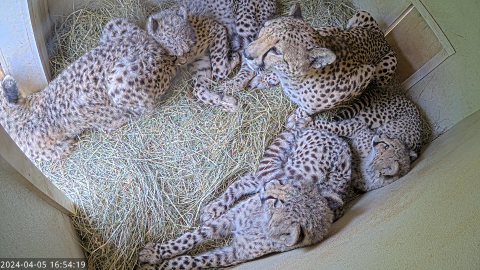
#CheetahCubdate: Farewell to Echo and Her Feisty Cubs!
Our Cheetah Cub Cam is winding down for the season. Read the latest update on the future of the cheetah breeding program... and say hello to some old friends!
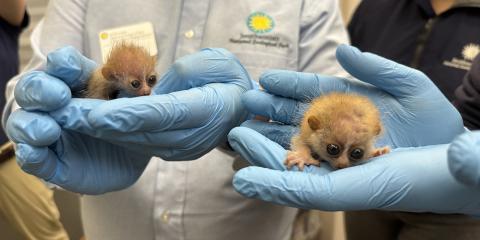
Pygmy Slow Lorises Are Born at Smithsonian’s National Zoo and Conservation Biology Institute
For the first time, the Small Mammal House is celebrating the birth of two pygmy slow lorises, an endangered species.

How to Book a Sumatra Orangutan Trek – The Ultimate Guide
Sumatra, the sixth largest island in the world, is home to some of the world’s most incredible wildlife, including the Sumatra orangutan.
Bukit Lawang, a small village in North Sumatra, is the starting point for trekking tours to see these magnificent apes in their natural habitat.
Hi, we’re Rach & Marty!
We’ve visited every country in the world and want to help you get the most out of your travels!
Whether you need an expertly planned itinerary , some experienced hints and tips , or just craving a delicious food adventure , we’ve got you covered!
We may earn affiliate commissions from websites we link to, at no cost to you. Click here for details.
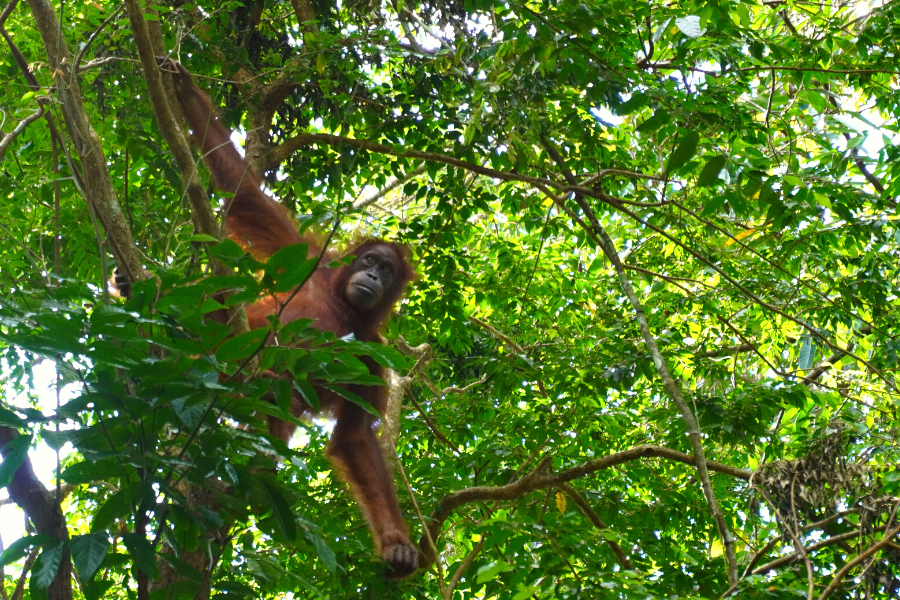
This article will explain how you can go trekking to see Sumatran Orangutans in the wild.
Our post covers everything you need to know to book a Sumatra orangutan trekking tour from Bukit Lawang.
Table of Contents
How to get to Bukit Lawang
Bukit Lawang is approximately 90 km northwest of Medan, the capital city of North Sumatra. Medan is the closest international airport to Bukit Lawang, with daily flights from Jakarta, Bangkok, Singapore, and Kuala Lumpur starting from USD 38 one way.
You can book the best flight deals to Medan on Skyscanner .
From Medan airport, Bukit Lawang is a 4-hour drive. From Medan city, it’s a 3-hour drive. The journey to Bukit Lawang may take an extra hour or so in heavy traffic.
The most common way to get to Bukit Lawang is by ‘tourist bus’, essentially a shared car with a maximum of six passengers at the cost of around 210,000 IDR or USD 14 per person.
Once you have chosen a Tour Operator to book your Sumatran Orangutan Trekking Tour, they usually offer to make these arrangements for you in advance.
You could also book a private car or Grab Taxi if you don’t wish to share it with anyone else. Book this private transfer from Medan airport to Bukit Lawang here .
Alternatively, you can take a public bus from Medan to Bukit Lawang. The bus journey takes about four to five hours and costs significantly less than a taxi or private car; however, public buses in Indonesia can be crowded and uncomfortable, and you may be charged more as a tourist and for your luggage.
How to Catch Public Bus from Medan to Bukit Lawang
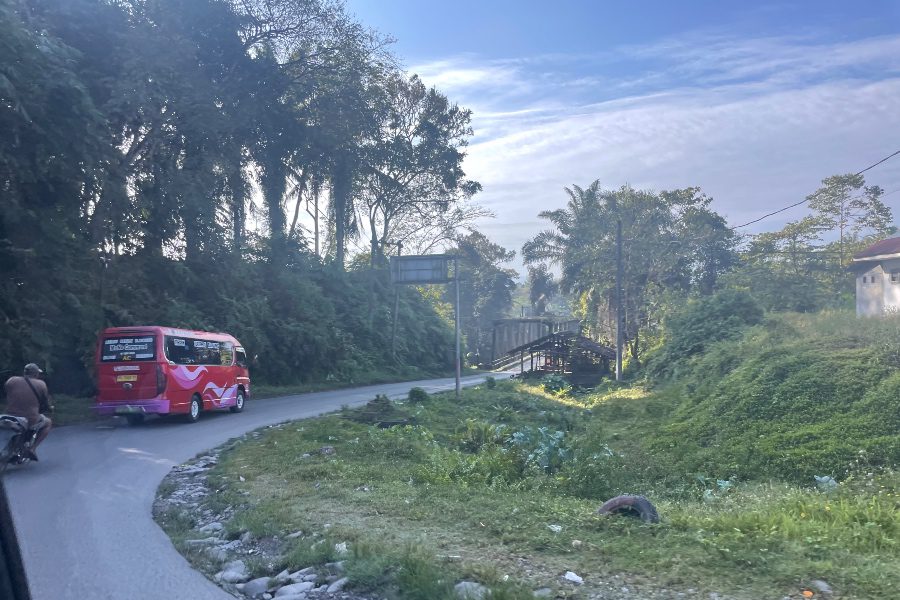
You need to take 2 different buses to reach Bukit Lawang:
– First, take the local ALS bus (Antar Lintas Sumatera/orange color) from Medan Airport to Binjai, the journey takes around 2 hours and the price is approx 50,000 IDR per person.
– Once you’ve arrived at Binjai bus station, you have to take a tuk-tuk (5,000 IDR) to Tanah Lapang Binjai terminal. Alternatively, you can also get dropped at Binjai Supermall.
NOTE: the last buses can be at 4:30 pm, 6:30 pm or 7:30 pm (no fixed times, it’s random) so ensure you leave enough time to reach Binjai before 4:30 pm.
- Then take the L300 or PS bus from Tanah Lapang Binjai terminal or from Binjai Supermall to go to Bukit Lawang. This bus journey takes around 3 hours and the price is 30,000 IDR per person.
From where they drop you, take a tuk-tuk for 10,000 IDR to Bukit Lawang.
Once you’ve arrived in Bukit Lawang, it’s about a 10-15 min walk to head down to the river where most guesthouses and hotels are located. The road is narrow, but it’s doable to walk with your bags or even roll a small suitcase along the path.
If you can afford it, we recommend you take the ‘tourist bus’, it’s a very comfortable car with air conditioning to Bukit Lawang as mentioned above.
We took this option and would likely choose it again if we returned to see Sumatran Orangutans in Bukit Lawang.
Which Sumatra Orangutan Trekking Tour Should You Choose
There are many trekking companies to choose from and they all offer a similar range of Sumatra orangutan trekking tours.
These range from short half-day walks to multi-day jungle treks. The type of tour you choose will depend on your fitness level and how much time you have available.
Half-Day Trek: If you’re short on time, a half-day trek is a perfect option. These treks typically last 3-4 hours and involve a gentle jungle walk to see the orangutans.
Full-Day Trek: The Full-day Trek is slightly more strenuous and involves a longer hike through the jungle. These treks typically last 6-7 hours and offer the opportunity to see orangutans and more wildlife, including gibbons, Thomas Leaf monkeys, and various bird species.
The 1-Day Trek is one of the most popular options for travellers hoping to spend some time viewing Sumatran orangutans in the wild. We chose the 1 Day tour option and were very happy with our Sumatra Orangutans Trekking Experience, and we saw eight orangutans in Sumatra jungle!
This tour had the right balance of viewing a range of Sumatran Orangutans, other wildlife, and great jungle views.
Multi-Day Treks: For the ultimate jungle experience, consider a multi-day trek. These treks can last anywhere from 2-7 days and involve camping in the rainforest. This 1 Night / 2 Day Trek is very popular .
Multi-day treks offer the chance to see a wide range of wildlife and explore more remote jungle areas.
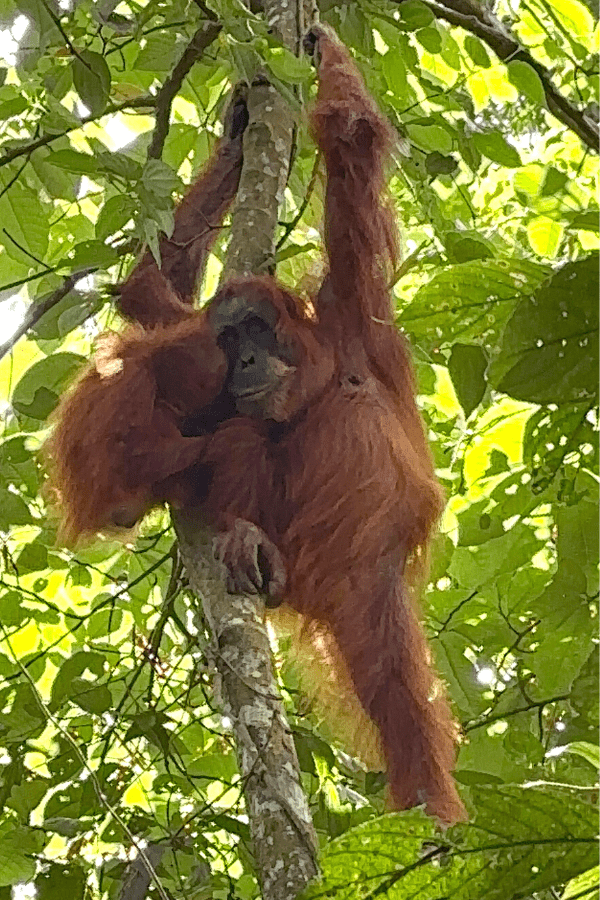
Camping Facilities – What to Expect on your Sumatra Orangutan Tour
If you book a multi-day Orangutan Trek, please remember that the facilities in the jungle are basic.
Campsites in the jungle are made with natural materials such as bamboo frames, covered by sizeable waterproof plastic sheets to protect from the rain.
Your guides will provide each trekker with a mattress, a mosquito net, and a blanket. There is a kitchen area at each campsite where your cook will prepare local dishes, and this is where you will enjoy dinner with your crew and group.
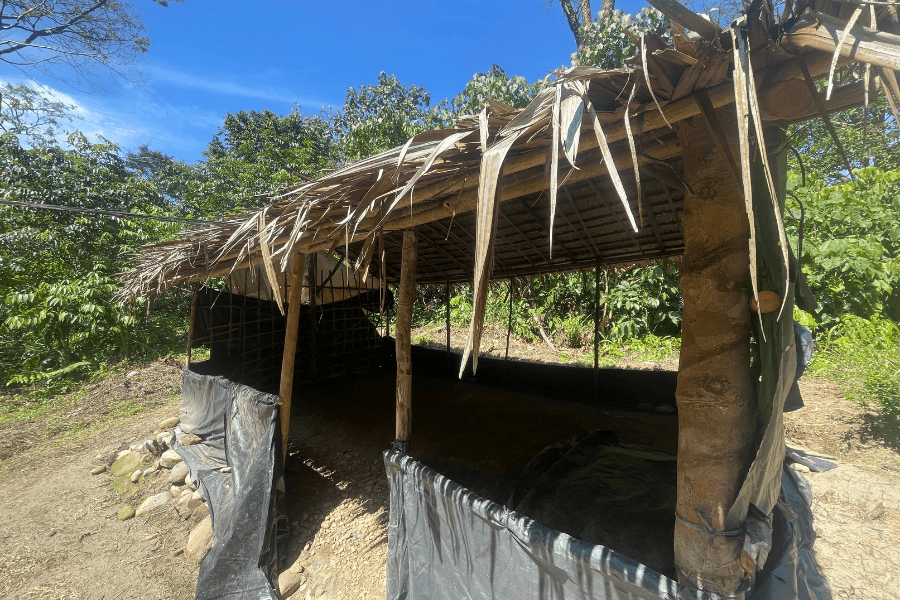
Usually, a toilet area is located a bit further away from the campsite, so it’s a good idea to bring your torch or headlamp.
Campsites are located near a river, a waterfall, or a small stream, so you can revitalise yourself and take a wilderness shower here.
All meals are provided on the Trek, including fresh fruit, tea/coffee, and biscuits at camp.
Food Included on your Sumatran Orangutan Trek
The food included in your Orangutan Trek is fantastic!
Lunches are typically fried rice, fried egg, prawn crackers, cucumber/tomato, and tropical fruit such as pineapple, mandarins, bananas, and watermelon.
Dinner at camp is classic Indonesian dishes such as chicken or tofu curry, fried fish/tempeh & rice, and vegetables.
Breakfast is a typical Indonesian breakfast of nasi goreng (fried rice) served with your choice of tea or coffee.
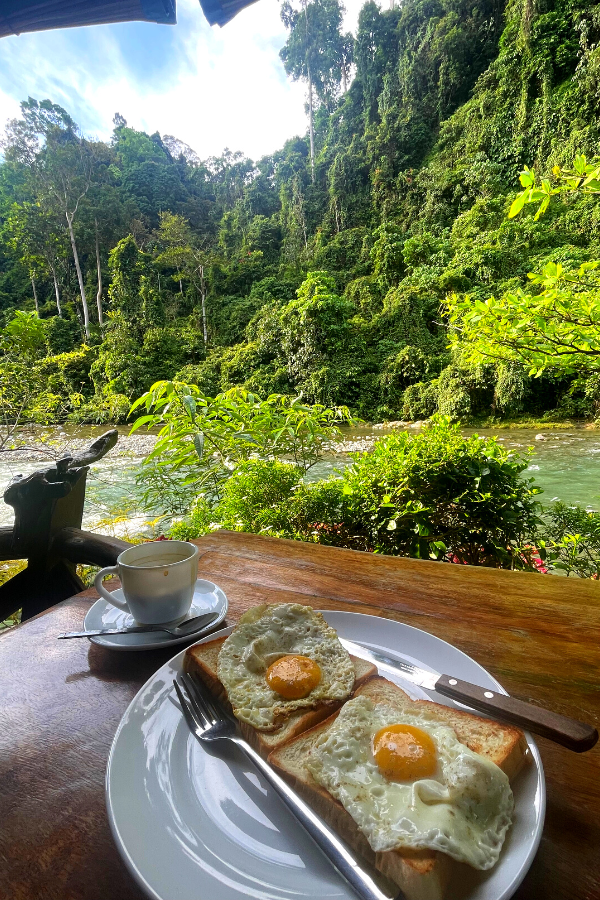
If you have any dietary requirements, your trekking company will do their best to accommodate your needs – just be sure to let them know before you depart on your Trek, although they will probably ask you beforehand.
How to Choose an Ethical Tour Operator
When booking a Sumatra orangutan trekking tour, choosing an ethical tour operator is essential. Unfortunately, some tour operators in Bukit Lawang have been known to feed orangutans or exploit them for tourist entertainment, which can harm the animals and their natural behaviour.
Choosing an ethical tour operator ensures that your experience is sustainable and responsible.
An ethical tour operator will prioritise the welfare of the orangutans, ensuring that they are not touched or fed by tourists. They will also follow strict guidelines to minimise the impact of tourism on the animals and their habitat.
By choosing an ethical tour operator, you can have a unique and unforgettable jungle experience while supporting conservation efforts in Sumatra. This is very important to us, which is why we chose to book with an ethical and reputable tour operator, Sumatra Orangutan Explore .
These guys have wonderful reviews from past travellers, which speaks volumes about them as a company that cares.
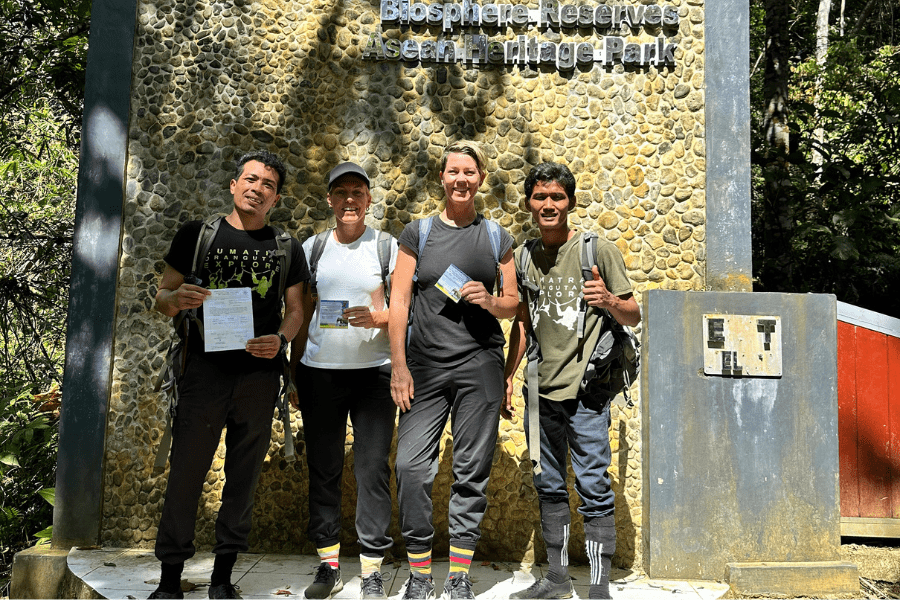
Why are Sumatran orangutans endangered?
The Sumatran orangutan is one of the most endangered great apes in the world. A common question is how many Sumatran orangutans are left? The answer is estimated to be approximately 17,000 individuals remaining in the wild.
Deforestation and habitat loss have been the primary drivers of the orangutan’s decline, as vast areas of Sumatra’s rainforest have been cleared for palm oil and other agricultural products.
In addition to orangutans, Sumatra is home to a diverse range of wildlife, including tigers, elephants, rhinos, and numerous bird and reptile species.
The jungle surrounding Bukit Lawang is a crucial conservation area, and tourism can play a vital role in supporting conservation efforts.
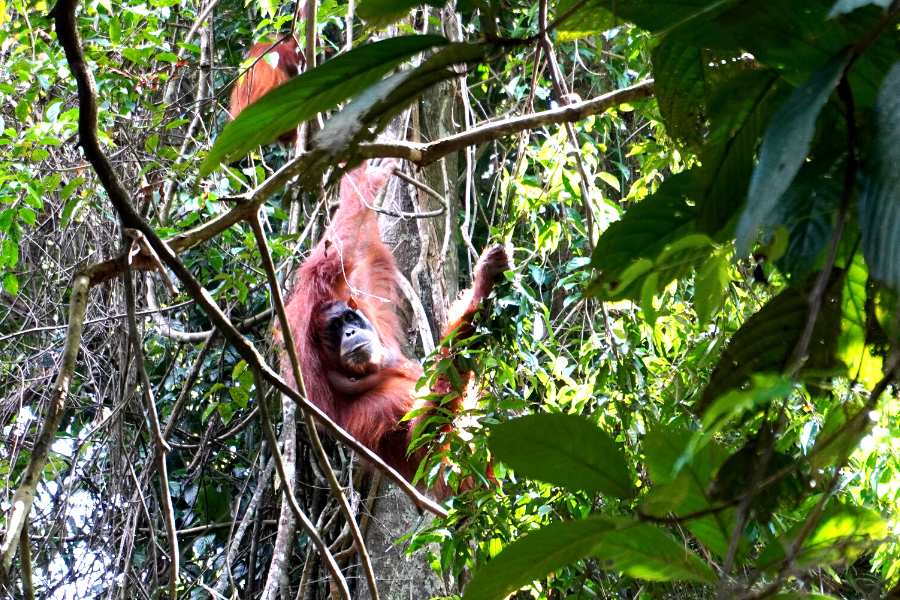
Is a Sumatra Orangutan Trek Considered Easy or Difficult?
Trekking to see Sumatran Orangutans could be considered quite challenging for some people. I hiked for Sumatran Orangutans on the 1 Day Trek and would admit that it was a little more challenging than I expected, and I consider myself with a solid level of fitness and agility.
Expect some very steep inclines and declines where your leg muscles will work hard.
Nearing the end of the 1 Day Trek, the decline from the top of the jungle heading straight down to the river is quite challenging. Furthermore, the ground can be mucky and slippery with spikey tree branches, roots, and leeches.
Add the intense humidity and shining sun; at times, you’ll certainly work for your views of Sumatran Orangutans.
If you don’t have a good level of fitness or have a fear of heights, I’d recommend you do the Half-Day 3 hr Trek to get a taste of the jungle and view some Orangutans.
Also, I’d recommend you speak with your Orangutan Trekking Company to discuss the best Trek to suit you. They’ll consider individual needs and requirements for your special jungle Sumatra experience.
If you book a private 1 Day Trek (incl transfer from Medan) , your guide can also lead you around on a more accessible circuit to avoid strenuous ups/downs on the trekking trail.
Jungle Rules to Go Trekking with Sumatran Orangutans
This jungle is part of the Gunung Leuser National Park, and it is home to some endangered animals, so there are a few rules that you are expected to follow:
- Only Enter the National Park with a Guide. Your Sumatran Orangutan Trekking Tour should include two guides, they are required to accompany you whilst inside the park. They are responsible to keep you safe and provide information about the Sumatran Orangutan and other wildlife you will encounter.
- You must have a permit to enter the park. Your guide will take care of this for you and provide you with your permit upon entry.
- Don’t touch or feed Sumatran orangutans or wildlife. You should never feed or touch wildlife because they may become dependent on humans for food or could contract disease or virus from us.
- Stay at least 10 metres distance from wildlife. These are animals in the wild, and to ensure your safety, please keep your distance.
- Take all of your garbage with you. Whatever you take with you, please wrap it in a plastic bag (used toilet paper, food scraps, cigarette butts) and take it with you out of the National Park once you leave.
- 🔥 Hot Tip: Book accommodation in advance on Booking.com
- 🎟 Book your attractions and tickets online: We recommend Viator and GetYourGuide
- 🔋 Stay charged: This Belkin Power Bank is essential!
- 📸 Join a Group Tour: Find some amazing Group Tours here
- ✅ Get Connected with an eSIM: Fast, easy and affordable! View easy eSIM options here
Prices to go Orangutan Trekking in Bukit Lawang
The cost of Sumatra orangutan trekking tours in Bukit Lawang can vary depending on the length of the trek.
On average, this is what trekking tours to see Sumatra Orangutans cost:
- A half-day (3 hrs) trek can cost around 700,000 IDR / 45 USD
- 1 Day Trek (6-7 hrs trekking) can cost 900,000 IDR / 59 USD
- 2 Days Trek 1,500,000 IDR / 99 USD
- 3 Days Trek 2,000,000 IDR / 132 USD
- 4 Days Trek 2,800,000 IDR / 185 USD
- 5 Days Trek 3,300,000 IDR / 218 USD
Where To Stay In Bukit Lawang
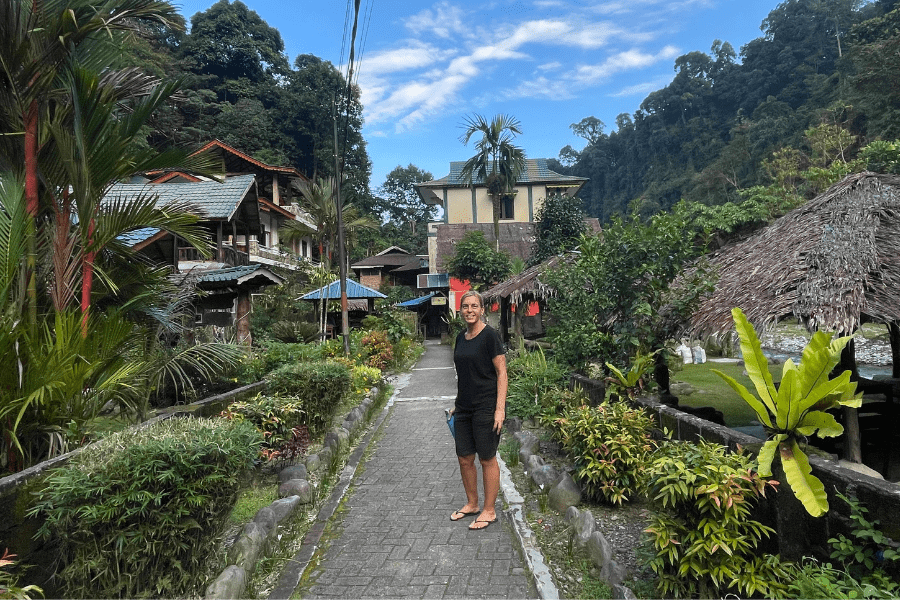
Regarding accommodation, Bukit Lawang has a range of options to suit different budgets and preferences. The village has several guesthouses, homestays, and a few mid-range and luxury hotels/lodges.
Budget options in Bukit Lawang can cost as little as 100,000 IDR (approximately 7 USD) per night for a basic room with shared facilities.
Mid-range options can cost between 300,000 IDR to 600,000 IDR (approximately 21 USD to 42 USD) per night for a private room with air conditioning and an en-suite bathroom.
For a spacious room with high-end amenities, luxury options can range from 1,000,000 IDR to 2,000,000 IDR (approximately 70 USD to 140 USD) per night.
We recommend booking accommodation in advance, especially during peak tourist season, as availability can be limited.
Many of the tour operators in Bukit Lawang also offer accommodations, so it’s worth considering booking a tour and accommodations together for convenience and saving some money.
Here are some of our top picks for accommodation in Bukit Lawang:
- Green Travelodge – Top-rated hotel in town, with rave reviews – 425,000 IDR ($28 USD)
- Garden Inn – Standard rooms with a garden view – 270,000 IDR ($18 USD)
- Hotel Orangutan – Double Room – 300,000 IDR ($20 USD) Family room (sleeps 6) with balcony – 1.2 Mil IDR ($79 USD)
- Ida Guesthouse & Restaurant – Budget option with great reviews– Double Room with Patio 120,000 IDR ($8 USD)
Tips to Prepare for your Sumatra Orangutan Trek from Bukit Lawang
- ATM: There isn’t an ATM in Bukit Lawang – and the nearest ATM is about 10 km away. Ensure you bring enough cash or you may also pay for your tour package by bank transfer or via Wise.com . There is no currency exchange and credit cards are not accepted anywhere in Bukit Lawang.
- WiFi: Many small restaurants and guesthouses have WiFi. It won’t be super fast, but it’s enough to do most things.
- Hotels: Expect cold showers and fans only, air conditioning is limited here. Electricity may go out sometimes but is usually stable. Bring a good power bank to ensure your camera and phone are fully charged for trekking each day.
- Phone Service: We used Airalo eSIM to stay connected as we travelled in Indonesia, it’s awesome! The connection to the local carrier in Bukit Lawang was fantastic, we highly recommend purchasing an eSIM for Indonesia .
- Restaurants: Many guesthouses have in-house restaurants for their in-house guests, but there are many places to eat along the river. We recommend My Resto Restaurant – they’ve got awesome reviews for great home-cooked food. We ate both pumpkin curry and eggplant curry with rice and it was wonderful – very fair prices too.
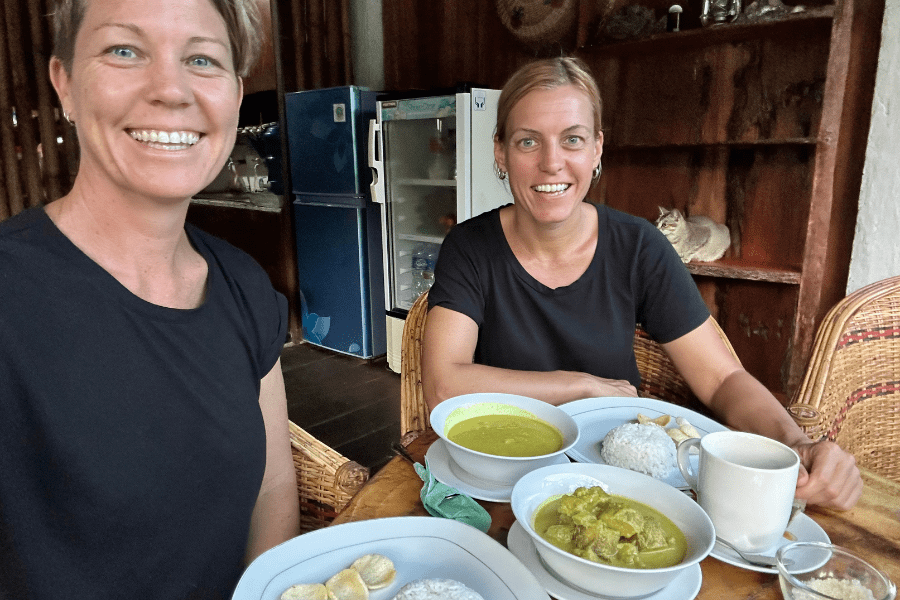
- Safety: We felt very safe in Sumatra. Solo travellers – we recommend asking your preferred tour operator to group you with other tourists who are doing the same trek on the same day as you. This way, you can share the experience and perhaps feel a little safer in the jungle, especially if you’re hoping to do a multi-day trek.
- Monkeys: There are lots of mischievous monkeys jumping around town, usually they’re trying to find food or cause chaos. Remember to lock your hotel windows at night and keep your things out of their reach!
- Mosquitoes: Although malaria or dengue isn’t a threat here, the mosquitoes are fierce, and they’re huge. Bring some good repellent with you – and if you forget, then the little shops here in town sell some too.
- Bring a waterproof rain jacket: You’re heading into a rainforest, and it could rain at any time. And believe me, when it rains, it pours here. Take a good waterproof rain jacket or poncho with you.
- Take hiking shoes/or invest in local rubber-made shoes: We’d recommend wearing a good pair of hiking shoes as the terrain is quite slippery and very muddy. We didn’t have our hiking shoes with us (just Nike Running Shoes ), which were fine for our 1 Day Trek, but for grip on rocks and declining down the steep side of the jungle cliff, we really missed our hiking shoes. Another alternative is to buy these local rubber shoes that all of the local hiking guides wear. They’re around 20,000 IDR to buy a pair in town and the biggest size they make them is size 42. They’re great shoes for gripping onto rocks, and they’re waterproof too, as they’re made entirely of rubber.
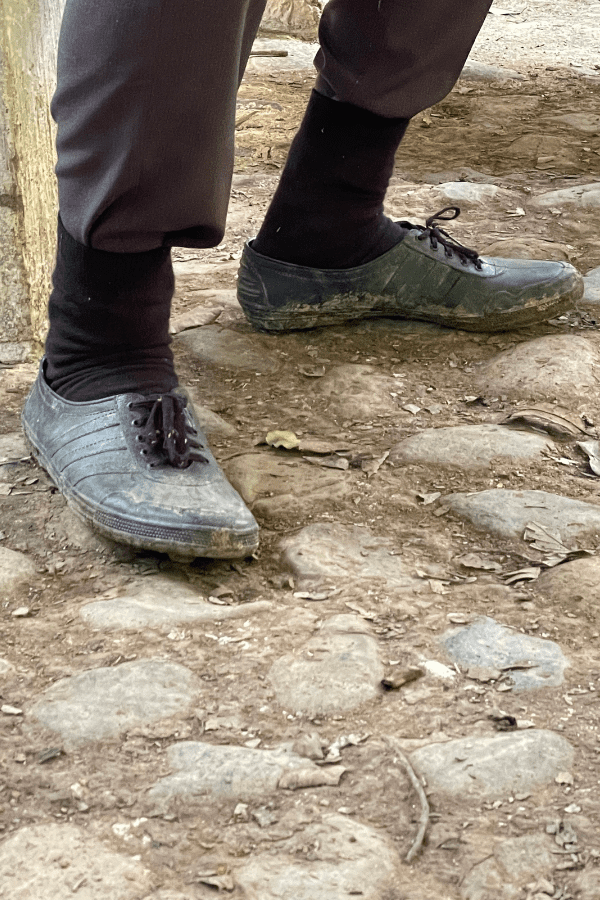
When To Visit Bukit Lawang
Here are some things to consider when planning your trip:
- Weather: The weather in Bukit Lawang is tropical and humid year-round, but there are distinct wet and dry seasons. The dry season runs from May to September, with August being the driest month. The wet season runs from October to April, with the heaviest rains typically occurring in November and December. If you want to avoid the rain and enjoy the best weather for outdoor activities, the dry season is the best time to visit.
- Orangutan sightings: The best time to do so is during the dry season. During this time, the orangutans tend to come down from the trees in search of food, making them easier to spot.
- Trekking: The best time to go trekking is during the dry season when the trails are drier and easier to navigate.
- Crowds: Bukit Lawang can get crowded during peak tourist season, which runs from June to August. If you prefer to avoid the crowds, consider visiting during the shoulder seasons of April-May or September-October.
Overall, the best time to visit Bukit Lawang is during the dry season (May-September) if you want to enjoy good weather, orangutan sightings, and trekking. However, if you prefer fewer crowds and don’t mind the occasional rain, the shoulder seasons of April-May are a good choice too.
Let’s do the right thing and look after our Special Forest People
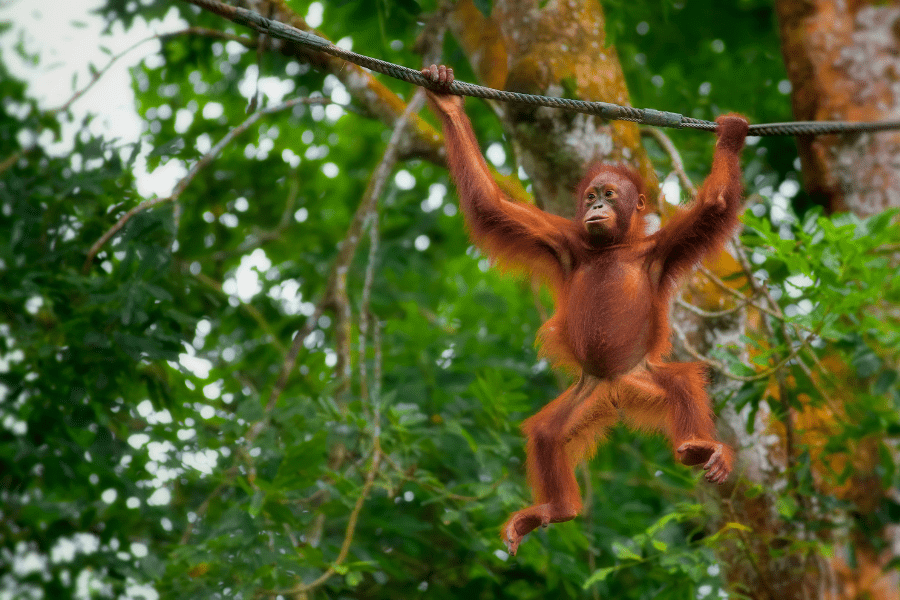
A Sumatra orangutan trekking tour is an unforgettable experience that offers the opportunity to see some of the world’s most incredible wildlife in its natural habitat.
Did you know that the word orangutan comes from the Malay words “Orang,” meaning person, and “Hutan,” meaning of the forest? So, therefore, “Orangutan” literally translates to “person of the forest”.
Let’s take care of these endangered people of the forest and consider booking your Sumatran Orangutan Trek with Sumatra Orangutan Explore or other ethical Sumatran Orangutan Trekking Companies.
Our knowledgeable and professional guide, Yahya, and our assistant guide, Jaka, were fantastic. They both spoke very clear English, knew their way around the jungle, and gave clear directions about what was happening as the day progressed.
We rate our Sumatran Orangutan Trekking Tour Experience with 5/5 Stars!
Get Connected with eSIM

Get connected easily on your travels—buy an eSIM! An eSIM works like an app: buy it, download it, and get connected in minutes! It’s easy, affordable, and convenient. Keep your original phone number, too!
Click below and view which eSIM data plan you need for your next adventure. Use our referral code: RACHEL5045 , to get $3 off your first purchase !
Practical Tips for Travel in Southeast Asia
If you’re planning to travel further in Southeast Asia after you’ve explored Indonesia, you’re in for a great time! We highly recommend you visit the gorgeous island of Flores. Our Perfect 7 Days Itinerary for Flores, Indonesia has got you covered for visiting the best spots!
And, you must visit the stunning Komodo Islands. Read our Guide to Planning the Perfect Komodo Island Tour to have the most memorable experience here.
And if you’re stopping by the popular island of Bali, you need to eat local food at these 5 Best Warungs in Canggu, Bali .
And, don’t miss reading our ULTIMATE Packing List for Southeast Asia for some useful tips about what you’ll need and what you can leave at home.
Consider joining a Group Tour in Indonesia with GAdventures . Share the experience, meet new people, and see some AMAZING places as you explore!
Subscribe to our newsletter!
Expert travel tips, resources and exclusive discounts worldwide
Southeast Asia is an AMAZING region to explore
Southeast Asia is one of our favourite regions of the world to discover. There are many great countries here to visit, however, we’ve got a soft spot for Thailand .
We’ve got a list of useful tips for travel in Thailand to help you on arrival. Some of our top places include Kata Beach, on the island of Phuket (here are 10 awesome things to do in Kata Beach ).
Our other favourite place in Thailand is Chiang Mai. Learn more about where to stay in Chiang Mai, our accommodation guide includes which neighbourhoods will suit individual needs. And, our Complete Food Guide to Chiang Mai is unmissable!
For more of our best travel tips and useful advice, visit our Travel Resources Page .
Travel Planning Resources
✈️ Flights : We use Skyscanner to book cheap flights worldwide.
🏨 Accommodation : Booking.com is our preferred platform for booking hotels and accommodation.
🏥 Travel Insurance : We recommend Heymondo ( Get 5% off Heymondo) & SafetyWing
🚌 Transportation : Trainline is the best website to reserve trains. We use Omio to book transport worldwide. For travel in Asia, we use 12Go.
🚘 Car Rental : We use DiscoverCars to book rental cars worldwide.
👫 Group Tours : G Adventures OR compare multi-day tours worldwide with Tourradar .
📸 Day Tours & Trips : GetYourGuide & Viator are the only two platforms you need.
📚 Lonely Planet: The Best Range of Travel Guides & Ebooks , and FREE Shipping! (use code RACHELDAVEY10 for a 10% discount)
🎒 Luggage : Osprey Farpoint 40L Backpack or Samsonite Luggage Range.
🛄 What to Pack: Don’t forget your Universal charger and a good power bank . To help you pack the essentials, here is our ULTIMATE Packing List for all Travellers .
🐶 Become a House Sitter: Join Trusted Housesitters and enjoy FREE accommodation worldwide. Use our invite to receive 25% off your new membership.
💰 Send Money Anywhere: WISE & Revolut are the best online accounts that let you send money, get paid, and spend money internationally. Both are so easy to use and way cheaper than any bank transfer.
📶 Stay Connected: Airalo eSIM allows you to get connected the moment you land at your destination, and you can avoid those expensive data roaming charges. We LOVE this product! Use promo code NOMAD15 for 15% off ALL eSIMs (new Airalo users only) OR use NOMAD10 for 10% off ALL eSIMs (for existing Airalo users)
✅ Check out our Travel Gear and Travel Resources for more valuable tips to save you money!
Tasty Food Adventures

10 Popular Foods From Mongolia – A Mongolian Food Guide

12 Best Cheap Eats in Cairns

5 Delicious Food from Greece Recipes to Cook at Home

What is Central Asian Food? 7 Popular Foods
See all Food Adventure blogs
Expert Travel Guides
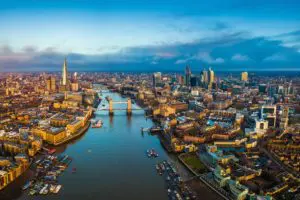
London In One Day – The Perfect Itinerary For Just One Day In London

Florence in 2 Days Itinerary – The Perfect Guide
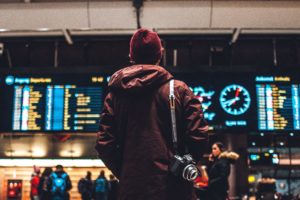
Travel After Coronavirus? 8 Odd Ways Travel Will Change

Antarctica vs Arctic – What Is The Difference?
See all our Travel Guides
Trusted Hints & Tips

The Best Debit Card for Australian Travellers – Save Loads of Money

How Many Countries In The World Are There? Best Answer: 193!

How to Send the Cheapest International Money Transfers

RV for Rent USA – UNBELIEVABLE 1 Dollar per day!
See all our expert Hints & Tips
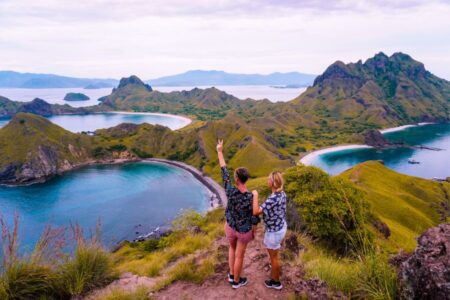
A Guide to Planning the Perfect Komodo Island Tour
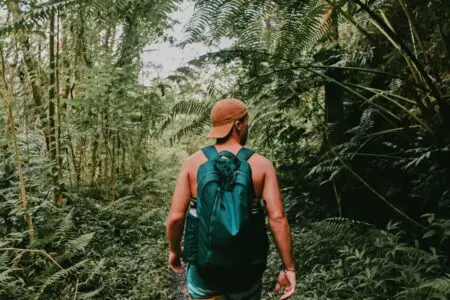
Southeast Asia Packing List – ULTIMATE Guide for 2024

Top 5 Best Street Foods in Asia
Leave a reply cancel reply.
Your email address will not be published. Required fields are marked *
Post Comment
Where to see orangutans in Borneo
Book your individual trip , stress-free with local travel experts
- roughguides.com
- where-to-see-borneo-orangutan
Plan your tailor-made trip with a local expert
Book securely with money-back guarantee
Travel stress-free with local assistance and 24/7 support
written by Joanne Owen
updated 26.05.2023
Love nature and wildlife? Borneo deserves to be shifted to the top of your travel wish-list. Located in Southeast Asia’s Malay Archipelago, the island is blessed with a bounty of unique plants, birds and animals, among them orangutans. Given that these endangered great apes are only found in two parts of the world, wildlife watchers will want to optimise opportunities to encounter them. With that in mind, read on to find out where to see orangutans in Borneo.
- The ideal destination for orangutan sightings
Best places to see orangutans in Borneo
- #1 Sepilok Orangutan Rehabilitation Centre
#2 Tanjung Puting National Park
#3 borneo orangutan survival foundation (bosf).
- Other destinations for orangutan encounters
Practical tips for seeing orangutans in Borneo
The ideal destination for orangutan sightings .
Politically divided between the Malaysian states of Sabah and Sarawak , Indonesia , and Brunei, Borneo is the third largest island in the world.
It’s also home to one of the world’s oldest rainforests, which is the ideal habitat for orangutans.
Asia’s only great apes, and the world’s largest arboreal mammal, orangutans spend pretty much their entire lives in the trees. This is reflected in their name — in Malay, orangutan means "man of the forest".
Overview of orangutans in Borneo
Orangutans, the island’s most famous forest residents are only found in two areas of the world — Borneo and the Indonesian island of Sumatra .
Orangutans live largely solitary lives in Borneo’s lowland forests. They make nests in trees to sleep and rest up in, between feasting on wild fruits.
Around a century ago, it’s thought there were over 230,000 orangutans in the world. These days, estimates put Bornean orangutan numbers around 104,700, making it an endangered species. The number of Sumatran orangutans is around 7500, which means they're critically endangered.
In more positive news after reading these sobering numbers, a number of foundations in Borneo are working to protect orangutans.

Orangutans in Borneo © Shutterstock
What other wildlife can I see in Borneo?
Borneo is home to 222 mammals (44 of which are endemic), 420 species of bird (37 endemics), 100 amphibians and 394 species of fish (19 endemics).
In addition to orangutans, Borneo's other primates include proboscis monkeys, macaques and gibbons.
Borneo is famed for its endangered pygmy elephants, and the elusive, endangered Sunda clouded leopard. Found in the mountainous interior, experts put their numbers between 5000 and 11,000.
Then there’s the Bornean sun bear. The world’s smallest, most arboreal bear, and the second rarest bear species (after the giant panda), sun bears have been given an “vulnerable” status.
Borneo’s birdlife is impressive, too. Notable species include hornbills, brahminy kites, crested serpent eagles, egrets, exquisite blue-banded and stork-billed kingfishers, and oriental darters.
Many of these wildlife wonders can be seen in the vicinity of the three best places to see orangutans in Borneo. Namely, Sepilok Orangutan Rehabilitation Centre, Tanjung Puting National Park, and Borneo Orangutan Survival Foundation.

Orangutan in Borneo ©Shutterstock
Borneo is one of the best places to see orangutans in the wild, bit it's also the world's third-largest island. So, where should you go? Three main locations in Borneo offer opportunities to see these amazing animals.
- Sepilok Orangutan Rehabilitation Centre
- Tanjung Puting National Park
- Borneo Orangutan Survival Foundation (BOSF)
#1 Sepilok Orangutan Rehabilitation Centre
Sepilok in the Malaysian state of Sabah is a rural, partly forested area that clings to some of Malaysia’s most celebrated wildlife, among them rhinoceros hornbills and, famously, orangutans.
A 3km turning south off the main road — 22km west up the main road from Sandakan — gives access to the Sepilok Orangutan Rehabilitation Centre.
Located at the end of the Sepilok road, the centre is open daily from 9am–noon and 2–4pm, with feeding times at 10am and 3pm.
Occupying a 43-square-kilometre patch of lowland rainforest, this is one of just a few such sanctuaries. Most of the orangutans here are victims of forest clearance. Many have been orphaned, injured or traumatized in the process.
While other orangutan residents have been illegally kept as pets, resulting in stunted survival instincts, the centre trains them to fend for themselves. This has led to many successful reintroductions to the wild.
The centre offers visitors a few different opportunities to observe orangutans. Firstly, a glass-fronted viewing gallery allows you to see them hone their climbing skills on a rope.
You can also walk trails through the trees, where guides will point out their nests.
Lastly, you can see them at a feeding station, where they’re offered only bananas to ensure they keep foraging. Don’t be alarmed if you see a poor turnout at the station – this can point to the health of the forest and its food sources.
Travel tip : our customisable Dazzling Kuching trip includes Sepilok Orangutan Rehabilitation Centre.
Other attractions near Sepilok Orangutan Rehabilitation Centre
The same turning off the main road also gives access to the Bornean Sun Bear Conservation Centre, and the Rainforest Discovery Centre.
Bornean Sun Bear Conservation Centre
Like orangutans, sun bears are vulnerable – either because their adorable, teddy-like appearance makes them attractive as pets, or because traditional medicine calls for their body parts.
Given that rescued bears need to relearn life skills, the Bornean Sun Bear Conservation Centre plays a vital role in protecting the species.
Opposite the Orangutan Rehabilitation Centre, the Bornean Sun Bear Conservation Centre is open daily from 9am–3.30pm and houses around forty bears in woodland enclosures. A small number of these can be viewed by the public.
Spotting scopes on the elevated boardwalks capture great close-up footage of the bears — ask staff to hold your camera against the eyepiece.

Sun bear © Shutterstock
Rainforest Discovery Centre
Located 2km down the Sepilok road and then 700m west along Jalan Fabia, the Rainforest Discovery Centre is open daily 8am–5pm.
At first sight, while the Rainforest Discovery Centre is a somewhat disappointingly landscaped version of the jungle, with an immaculate lake in the middle, its canopy walkway is impressive.
Here 347m of aerial bridges offer opportunities to see brightly coloured trogons and other birds.
If you sign up for the guided night walk (Mon–Fri only), you might just see flying squirrels, slow lorises and (more rarely) tarsiers.
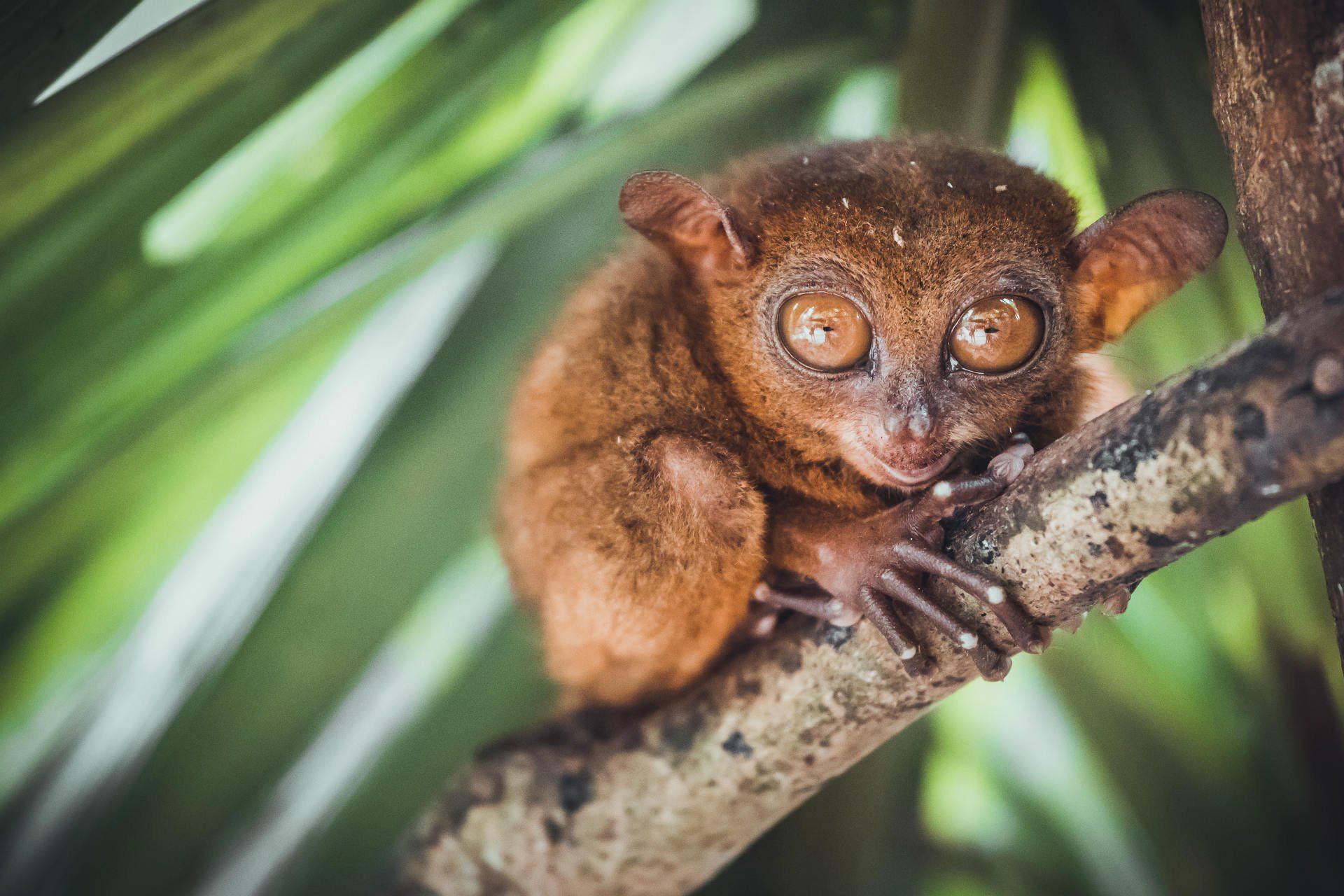
Get lucky, and you might see a tarsier in the Rainforest Discovery Centre, Borneo © Shutterstock
Located in Kalimantan , Indonesia’s name for its two-thirds share of Borneo, Tanjung Puting National Park’s orangutans are the region’s biggest tourist draw.
Your starting point is Pangkalanbun, which is accessible by air. Scheduled arrivals and departures ply routes to and from Pontianak, Ketapang, Banjarmasin, Jakarta, Semarang and Surabaya.
Once in Pangkalanbun, you need to obtain an entry permit at the park office. From there, hire a taxi for the 20-minute drive to Kumai. This riverside village serves as the entry point to the park, a UNESCO Biosphere Reserve.
At the harbour, either hire a klotok (local motorised boat) or a speedboat to go upriver.
A highlight of visiting Tanjung Putting National Park is the orangutan feeding sessions at one of three park outposts.
The first, Tanjung Harapan – directly opposite the Sekonyer River Ecolodge – cares for orphaned infants and new arrivals and has a visitor information centre.
Be aware that the most famous of the three, Camp Leakey, can be something of a circus during high season (June–August), with visitors who are less conservation-oriented clamouring to walk down jungle paths to see the red apes in action.
Older orangutans, sometimes with their offspring, can be found at Pondok Tanggui. During the feeding sessions at Camp Leakey and Pondok Tanggui, orangutans that hover near the stations are offered bananas and milk to supplement seasonal lack of food in the forest.
Allowing tourists the experience achieves an additional benefit — raising awareness of the plight of orangutans and the shrinking forests.
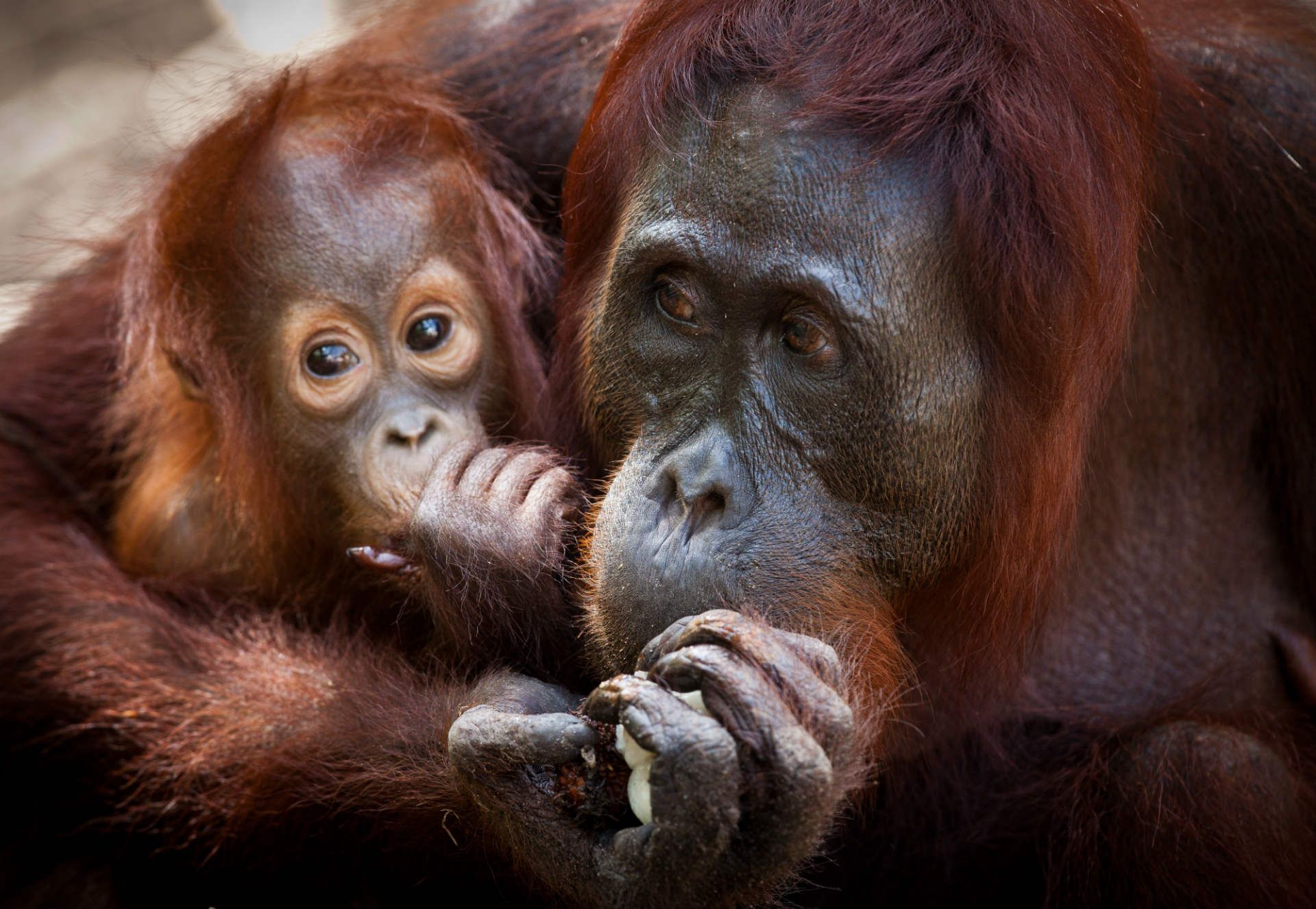
Orangutans in Kalimantan, Borneo © Shutterstock
Other activities in Tanjung Puting National Park
Unsurprisingly, Tanjung Puting National Park is all about the wildlife. Aside from orangutans, It’s home to the proboscis monkey and seven other species of primate, along with clouded leopards, civets, sun bears and several species of deer.
It also boasts over 230 species of bird (including hornbills, and many wetland species), two species of crocodiles, dozens of snakes and frogs, and the endangered Arwana (bony-tongue) fish.
The best viewpoints are from the river. At sunrise, proboscis monkeys begin their day’s foraging, occasionally belly-flopping into the water.
Dawn also sees birds especially active along the river.
Come late afternoon, groups of proboscis monkeys — one male and his female harem per tree — settle in for the night and are easy to spot.
Travel tip: for a sublime jungle river experience, ask your boatman to stop the engine for a while to allow the boat to drift quietly.
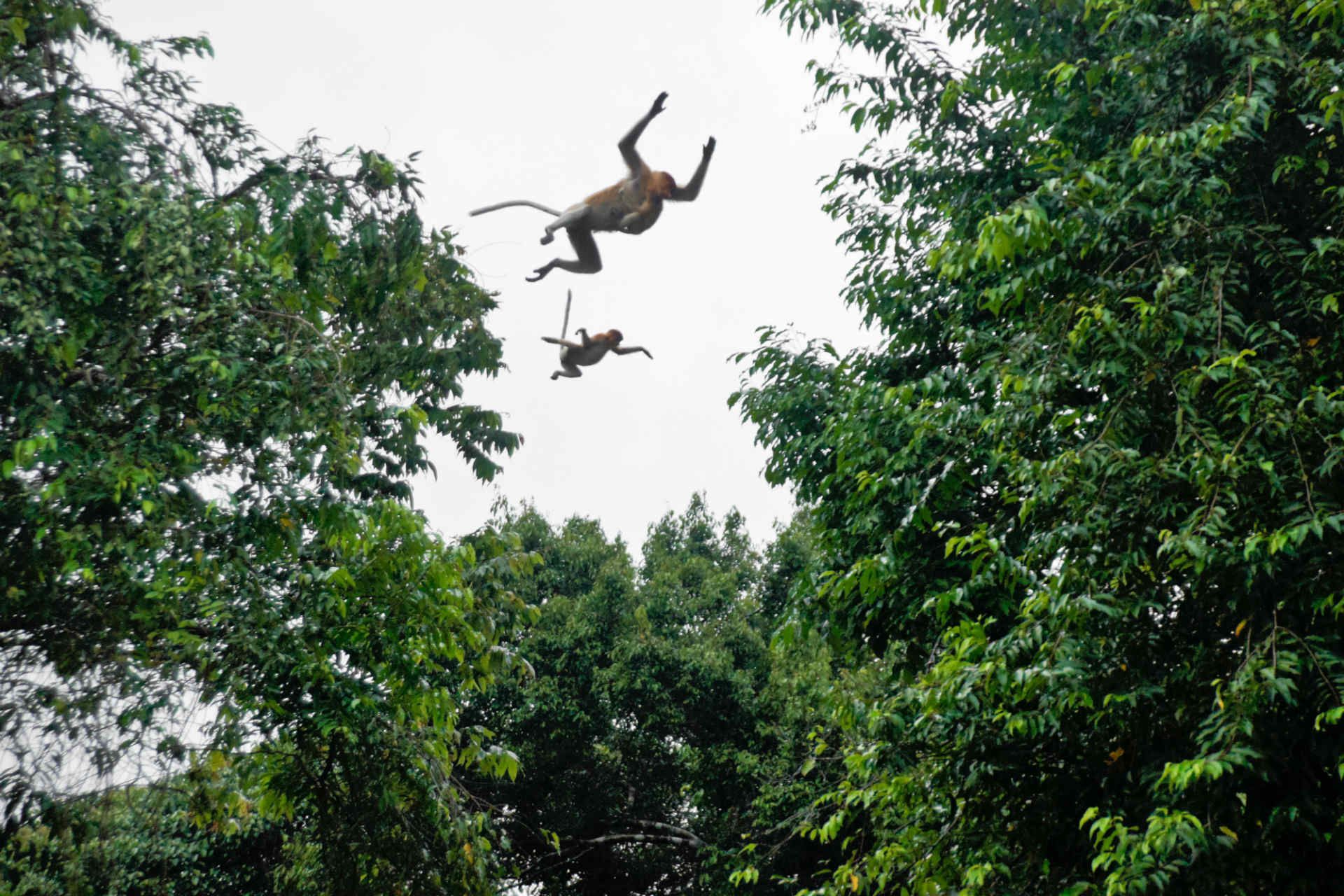
As well as orangutans, keep your eyes peeled for proboscis monkeys in Tanjung Puting National Park © Shutterstock
Related articles from the blog

The Borneo Orangutan Survival Foundation has a rehabilitation centre at Nyaru Menteng, 28km north of Palangkaraya, which can only be visited with a permit acquired in advance.
Home to over 300 orphaned and displaced orangutans, the visitor centre here is open on Saturdays and Sundays, from 9 am-5pm.
While visitors aren’t allowed to come into close contact with the orangutans at this site, you could opt to stay at Samboja Lodge to experience encounters while supporting BOSF’s work — all revenue goes to BOSF conservation projects.
A highlight of staying here is visiting the orangutan sanctuary islands — man-made islands where un-releasable orangutans live in a semi-wild environment.
The lodge also offers opportunities to enjoy thrilling canopy walks and jungle treks, boat trips up the wildlife-rich Black River, and visits to a sun bear sanctuary.
This is travel at its most rewarding, and responsible.

Orangutan © jaiman taip/Shutterstock
Other destinations for orangutan encounters
Danum valley.
About 90min from Lahad Datu by 4WD, the Danum Valley is “perhaps the last area of primary lowland forest in SoutheastAsia which remains truly pristine”.
That glowing description isn’t from a tour operator brochure, but from the South East Asia Rainforest Research Partnership, an international scientific collaboration that’s been based here since the 1980s.
Wildlife here includes bearded pigs, proboscis monkeys, elephants, over 320 species of bird and (you’ve guessed it) orangutans.
Although orangutan sightings are not guaranteed, there are several walking trails and a suspended walkway.
Batang Ai National Park
Located near Lubok Antu, an hour by boat from the dam, the little-visited Batang Ai National Park preserves an important area of rainforest that merges with the Lanjak Entimau Wildlife Sanctuary.
Only accessible with an official guide, who can be hired in Lubok Antu, orangutans are occasionally spotted on various trails.
Note that booking a boat to these trails will set you back a fair whack from the HQ, the park holds no residential or other facilities, and all visitors must be accompanied by a guide.
Matang Wildlife Centre, Kubah National Park
Some 20km west of Kuching, Kubah National Park is a rainforest reserve that’s considered to be one of the world’s richest sites for palm species.
Crisscrossed by trails, waterfalls and streams, with three modest peaks emerging from the lush forest, the park is home to Matang Wildlife Centre.
Here injured, sick or orphaned wild animals such as orangutans, gibbons and hornbills are rehabilitated before being returned to the wild.
Bohorok Orangutan Centre, Gunung Leuser National Park
Northwest from Medan, some three hours by road, a narrow road winds up the Alas River Valley to Gunung Leuser National Park.
Covered in dense jungle, this 8,000-sq km park is a UNESCO Biosphere Site.
In Bukit Lawang , on the eastern edge of the Gunung Leuser reserve, the Bohorok Orangutan Centre welcomes visitors.
Although the centre no longer rehabilitates the red great apes, you’re welcome to take a one-hour hike through the jungle to platforms used for the early-morning and afternoon feeding of wild and semi-wild orangutans.

Orangutans doing their thing in Borneo © Shutterstock
- Do your research and book trips or tours well in advance.
- Travelling independently? Check if you need a permit before visiting national parks.
- Wondering when's the best time to visit Borneo to see orangutans? Anytime between March and October should deliver decent sightings.
- When the rain lets up in April and May, and fruiting season kicks off, you have an increased chance of seeing orangutans at their most active.
- Borneo is hot and humid, so keep well hydrated when you’re out in the jungle.
- It’s advisable to wear long sleeves, trousers, and insect repellent.
- Leeches live in the lowland jungles, so you might want to tuck trousers into socks.

Borneo © Shutterstock
Inspired to see orangutans in Borneo for yourself? Get yourself The Rough Guide to Malaysia, Singapore and Brunei to help plan your trip.
Alternatively, if you’d prefer to forgo the hassle of planning, browse our customisable itineraries to Malaysia and Indonesia . For example, our Nature in Borneo trip includes incredible orangutan experiences.
Header image: orangutan in the jungle of Sabah, Borneo, Malaysia © jaiman taip/Shutterstock

Joanne is a Pembrokeshire-born writer with a passion for the nature, cultures and histories of the Caribbean region, especially Dominica. Also passionate about inspiring a love of adventure in young people, she’s the author of several books for children and young adults, hosts international writing workshops, and has written articles on the Caribbean and inspirational community initiatives for Rough Guides. Follow her @JoanneOwen on Twitter and @joanneowenwrites on Instagram.
- Nature & Wildlife
- Coasts & Islands
- National Parks & Reserves
- Off the Beaten Track
- Where to Stay
- Inspiration
- See & Do
- Travel Tips
- Where to stay
Planning your own trip? Prepare for your trip
Use Rough Guides' trusted partners for great rates
Find even more inspiration here
Ready to travel and discover malaysia, get support from our local experts for stress-free planning & worry-free travels.
Events & Festivals
Food to Try
Best Time to Visit
Weather & Climate
Airports in Borneo
Best Hotels in Borneo
Staying at an Iban Longhouse
Driving in Borneo
One Week in Borneo
Top Destinations in Malaysian Borneo
Sarawak vs. Sabah
Guide to Kuching
Visiting Kalimantan
Guide to the Derawan Islands
Brunei Travel Guide
Top Things to Do in Malaysian Borneo
Museums to Visit
Best Beaches
Where to Go Scuba Diving
Best Hiking in Borneo
National Parks
Where to See Orangutans
5 Places to See Orangutans in Borneo
With their ability to learn sign language and even to make tools, orangutans are considered one of the world's smartest primates. Orangutans in Borneo even begin to craft umbrellas from leaves when they know rain is coming!
Sadly, the orangutans in Borneo are struggling to survive in the wake of massive deforestation. Even an illegal pet trade threatens the species. Visiting rehabilitation centers not only offer a memorable encounter, but your visit also helps to support conservation efforts to protect one of Earth's smartest residents.
Learn more about the endangered orangutans, then read about where to find them in Borneo.
Semenggoh Wildlife Rehabilitation Centre
The Semenggoh Wildlife Rehabilitation Centre, just 12 miles from Kuching , is the best place to find orangutans in Sarawak. Unlike zoos which simply leverage orangutans as attractions, the primary mission of Semenggoh is to reintroduce orangutans back into the wild. The animals are not kept in cages; instead, they are allowed to roam freely within a large area.
Visitors to the Semenggoh Wildlife Rehabilitation Centre can join a group and hire a ranger for a forest tour in hope of finding wild orangutans in the trees. Alternatively, two daily feeding times nearly guarantee a spotting of the shy primates.
Kubah National Park
The Kubah National Park in Sarawak is located 13 miles west of Kuching. The Matang Wildlife Centre, nestled within the interior of the national park, is home to several resident orangutans. Visitors must hike three to four hours along the Ulu Raya trail through the national park to reach the wildlife center.
Sleeping in the Kubah National Park increases your chances of spotting orangutans; book the simple dorm-style accommodation through the Forestry Office in Kuching.
Sepilok Orangutan Rehabilitation Centre
Perhaps the most famous place to see orangutans in Borneo, the Sepilok Orangutan Rehabilitation Centre is a popular draw in East Sabah . Visitors can climb tall platforms to observe orangutans in the trees, although sightings are never guaranteed.
Fruit is placed on feeding platforms twice daily; shy orangutans brave a barrage of tourists' cameras to take the offering before retreating back into the forest.
Lok Kawi Wildlife Park
A great option for people without much time in Sabah, the Lok Kawi Wildlife Park is only 30 minutes away from the capital of Kota Kinabalu. The 280-acre wildlife center is home to several tigers, elephants, orangutans, and other protected animals.
While the animals are kept in large enclosures, every effort is given to make the setting as close to the natural habitats as possible.
To reach Lok Kawai Wildlife Park, take southbound bus #17 to the town of Lok Kawi, then hail a taxi to the park.
The Kinabatangan River
For a wilder approach to seeing orangutans in rehabilitation centers, make your way from Sandakan in East Sabah to the tiny village of Sukau . Boat cruises along the Kinabatangan River offer a chance to see a variety of wildlife including orangutans, proboscis monkeys, and even elephants.
Several small lodges along the Kinabatangan River offer accommodation and book boat tours. Boats are typically small speedboats run by knowledgeable guides who know where to look for orangutans. Lucky travelers get to see the primates along the riverbanks in a completely natural habitat!
How to Find Cheap Flights to Borneo
One Week in Borneo: The Ultimate Itinerary
The Top 12 National Parks in Malaysia
A Guide to Airports in Borneo
9 Top Destinations in Malaysian Borneo
Your Trip to Borneo: The Complete Guide
Where to Go in Malaysian Borneo: Sarawak or Sabah?
The Top 8 Things to Do in Malaysian Borneo
Guide to Sandakan, Malaysia's Gateway to Nature
Sukau in Sabah, Malaysia
The 12 Best National Parks in Borneo
The 10 Best Hikes in Borneo
10 Top Things to Do in Kuching, Sarawak
Eight Awesome Zoos in Southeast Asia
The Top 12 Things to Do in Malaysia
The 11 Best Hotels in Borneo

Orangutans in Sumatra Indonesia: Guide To Seeing Endangered Orangutans in The Wild
by Asdghik Ashley Melkonian

Table of Contents
Where to See Orangutans in the Wild In Sumatra, Indonesia
Public transport from medan airport to bukit lawang, travel tips to visit bukit lawang, weather in north sumatra and when to visit, the rooms at hotel orangutan, waking up with monkeys on my balcony, the food and staff at hotel orangutan, orangutan tour options, orangutan tour experience, was trekking in the rainforest difficult, essential things to pack, conservation efforts to save orangutans.
Orangutans in Sumatra are critically endangered mainly due to the expansion of palm oil plantations. There are only about 6,000 Orangutans left in the wild in Sumatra and these numbers are quickly declining due to deforestation.
My experience of seeing Orangutans in the wild was one of my favorite trips of all time. I’m an animal lover and having the chance to come up close and personal with these amazing animals was truly special.
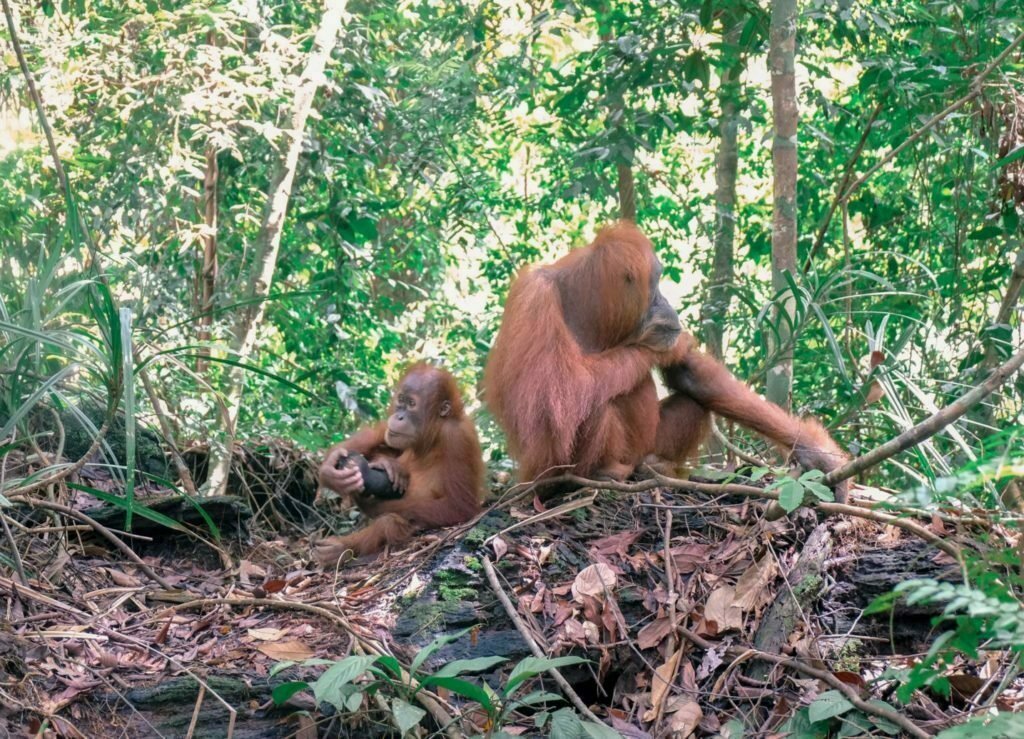
There are actually two places left in the world where you can see Orangutans in the wild: Sumatra and Borneo. The Sumatran Orangutans are more rare vs. the Bornean Orangutans. The best place to see them in their natural habitat is in Bukit Lawang in North Sumatra , Indonesia .
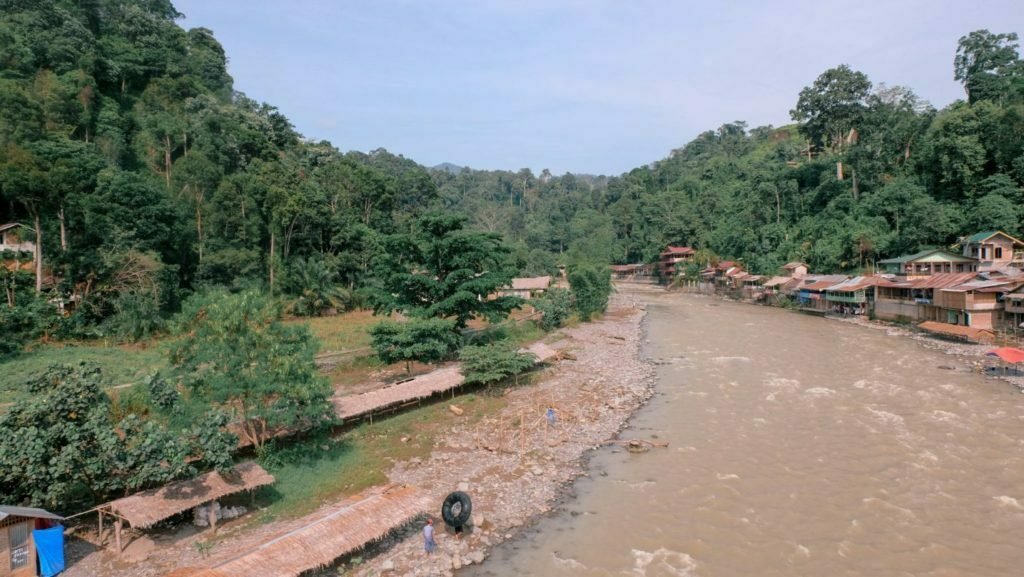
How to get to Bukit Lawang Indonesia
It’s best to fly into Medan Airport (KNO) and take a taxi to Bukit Lawang. The ride will take around 3 hours (2 hours if there’s no traffic). The road is fine in the first hour, but can get bumpy during the last hour.
You can arrange for your airport taxi through your guesthouse or negotiate a deal with one of the many taxi drivers in the arrival area of the airport. The ride should cost around $30 to $50, depending on your negotiation skills.
There are several extremely cheap flights to Medan from Kuala Lumpur or major cities in Indonesia. Some flights are as low as $30.
There are 2 public transportation options from Medan Airport, but both of them will drop you at Binjai, after which you will need to take a taxi (1.5 hours) to Bukit Lawang. This taxi ride will cost around $15 to $20.
1st option: Take the airport bus to Binjai. Cost: $3, duration: 1 hour.
2nd option: Take the train to Binjai. Cost: $3, duration: 1 hour. More info here .
My recommendation is to simply take a taxi from the airport, because you won’t be saving much if you use these public transport options. Especially given the fact that they get your halfway through your journey.
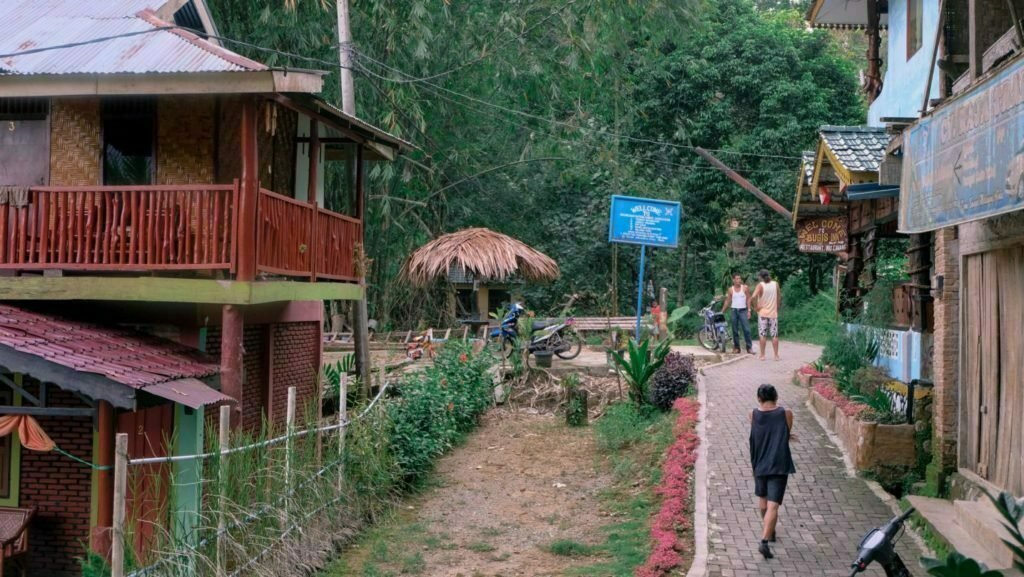
1. Bukit Lawang is a very tiny village on the outskirts of Gunung Leuser National Park. As soon as you start walking in, most of the locals will start waving hello with a big smile. It’s a place where everyone knows everyone . You can definitely enjoy the slow-paced life during your holiday.
2. There are only a handful of basic accommodation options in the village.
3. There isn’t much to do at night apart from hanging out in or around your guesthouse.
4. The cliche saying “When it rains, it pours” applies perfectly here. After all, you are right next to the rainforest. When it rains, it’s best to wait it out, because you will get soaking wet.
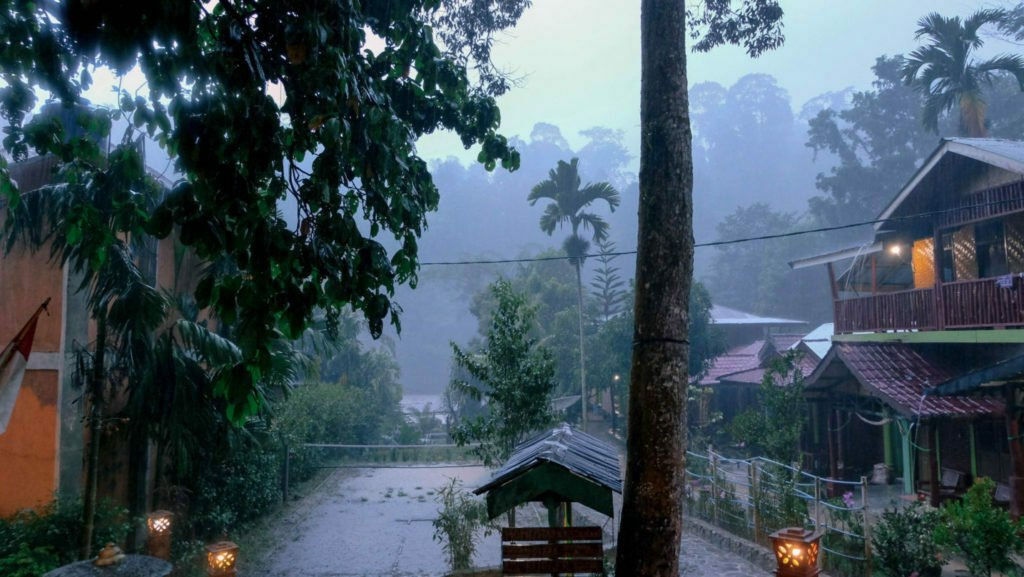
5. Bring cash to cover all your travel costs. There are no ATMs around and most places including guesthouses only take cash.
6. You will see lots of bugs! But you can survive them. As a person who is terrified of creepy crawlies, I was able to survive my trip without too many scary encounters. Being in the middle of the rainforest, there are mosquitos, spiders and some bigger bugs. Bring lots of mosquito spray and purchase a bug spray for your room and spray it twice a day.
7. The food is very basic. There aren’t many dining options, but thankfully Indonesian food is good. You will have a lot of fried noodles (Mie Goreng) and rice (Nasi Goreng).
8. North Sumatra (and most of Indonesia) has a majority Muslim population . You can still wear whatever you want as a tourist, but if you are passing through the heavily populated cities and want to make stops along the way, avoid very short dresses or shorts.
9. Indonesians are some of the friendliest people in the world. Most locals will greet you with the biggest smiles.
10. Forget about having good WIFI . The internet is the greatest and you might not have very good cell coverage either.
11. You will experience power cuts . There are some electricity cuts that happen daily, but thankfully most places have generators.
12. Keep your hotel doors and windows closed at all times, otherwise, you will find monkeys (not Orangutans don’t worry!) going through your stuff in your room.
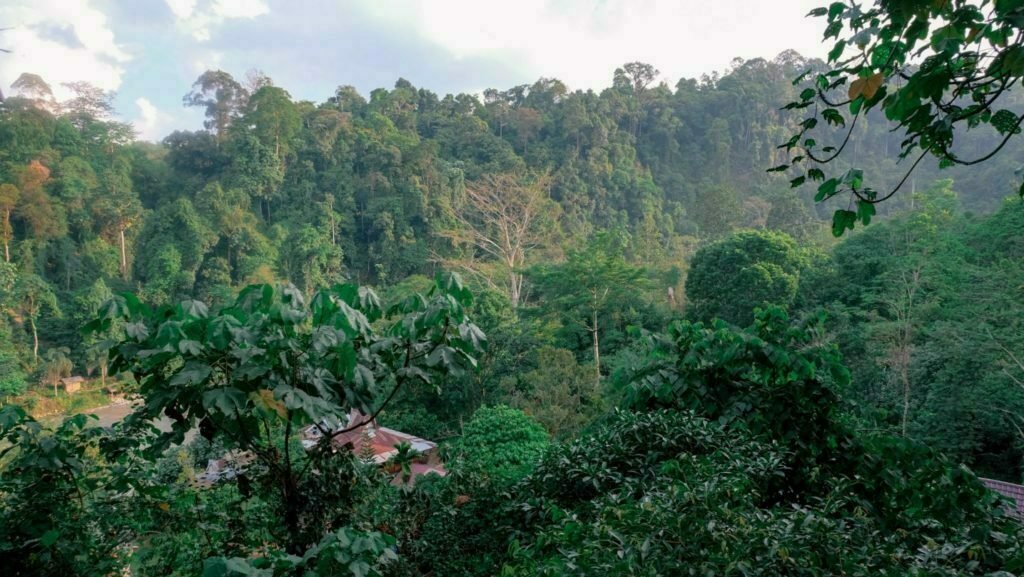
The weather in Indonesia has only two seasons: wet and dry. It’s best to avoid the wet season, especially if you’re going to do lots of outdoor activities.
In North Sumatra, the wet season is from October to January. It’s best to visit from April to August. More weather info here .
Where to Stay in Bukit Lawang Sumatra
After doing an extensive research to find the best guesthouse , I found Hotel Orangutan to be the best accommodation option. My stay was just perfect and I highly recommend it. Not only that, the hotel is super affordable too. The deluxe room price starts at $37/night.
It’s important to mention that your guesthouse will be arranging your tours to see the Orangutans, so it is essential to pick a good one.
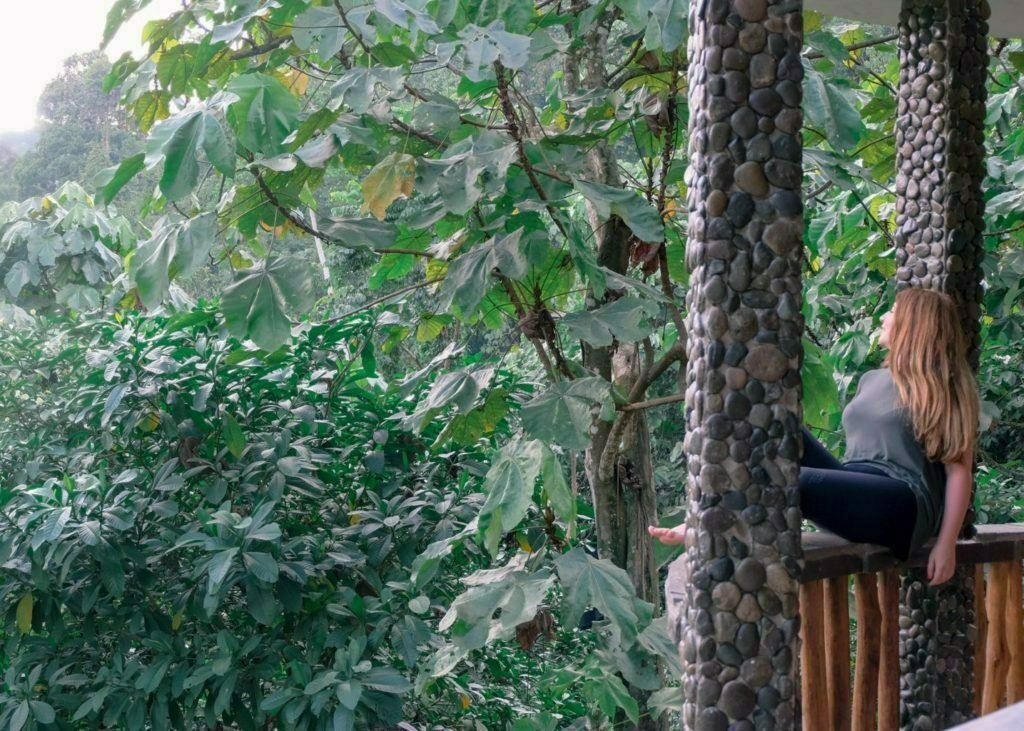
I stayed in the Deluxe Room all the way at the top of the hotel. My room was super spacious with a beautiful large balcony. The bed was very comfortable and covered with a mosquito net. There is no AC in the rooms, but there are large fans both inside the room and on the balcony, which make it perfectly cool.
The bathroom was my favorite part. The shower area is actually open (covered with a net) and overlooks the jungle! After experiencing several outdoor showers in Southeast Asia, this was still an interesting one because it feels like you’re literally taking a shower in the jungle.
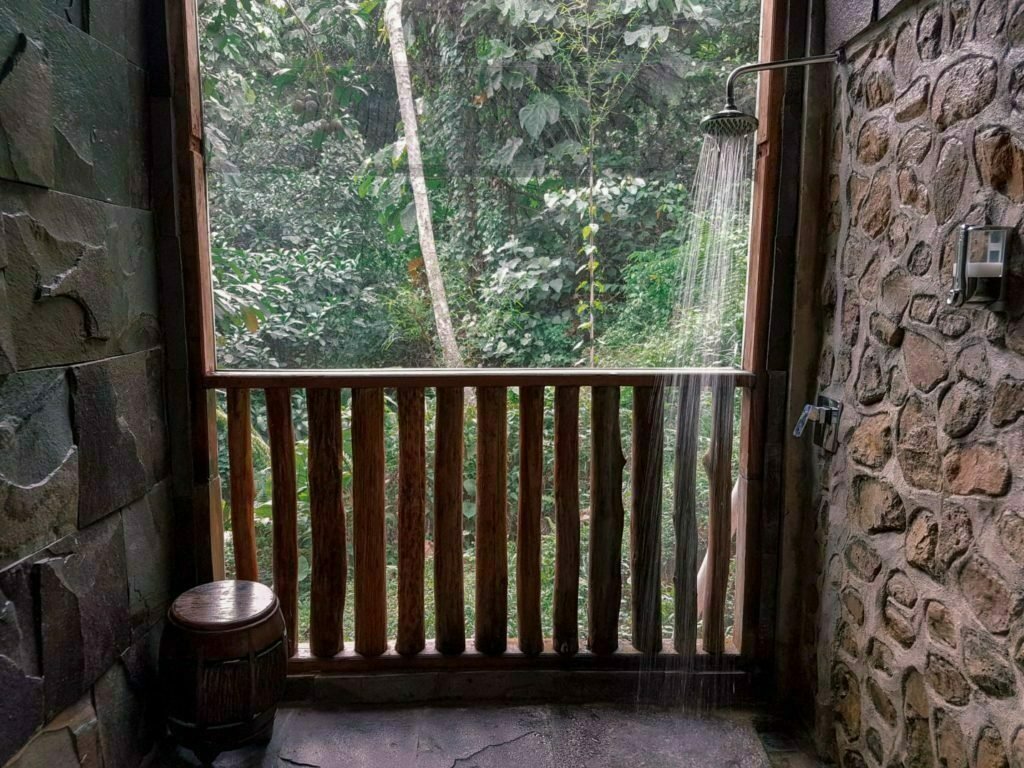
The first morning, I woke up to a few sounds on my balcony (apart from the amazing sounds of the rainforest). I was curious to know what was happening, so I opened the door to see over 30 to 40 little monkeys just hanging out! When I stepped outside, they all stopped what they were doing and stared at me for a bit. I decided to have a seat and enjoy watching them do their monkey business. Within 15 minutes they moved on to a different location.
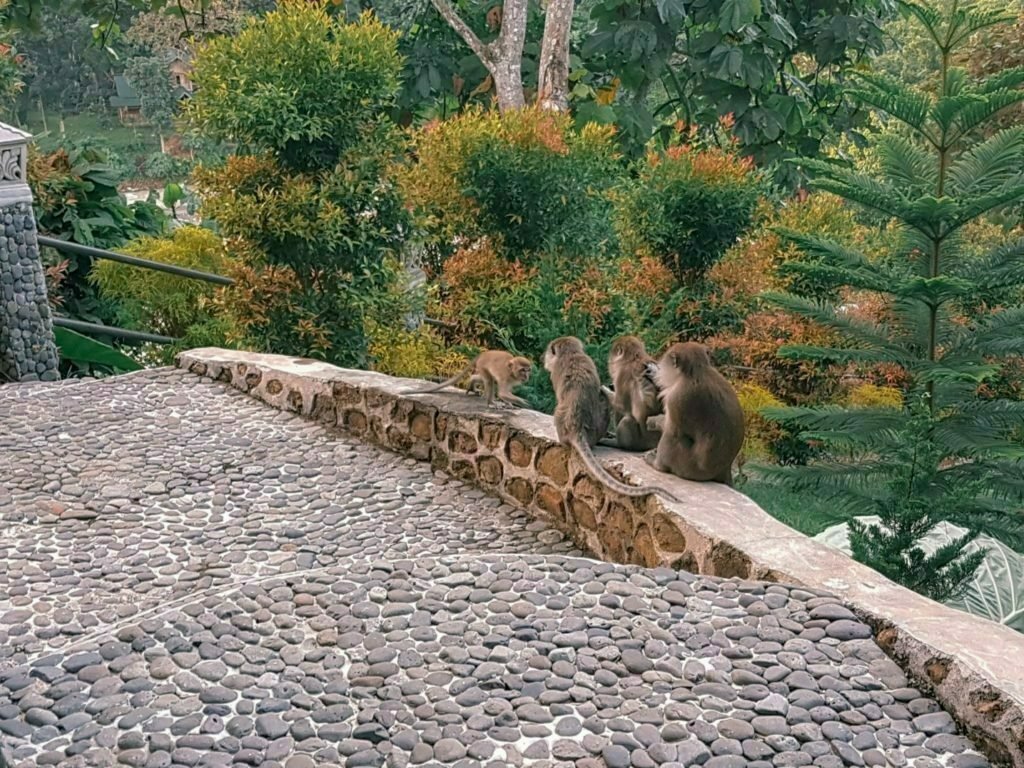
The highlight of my stay was definitely the staff. They are some of the friendliest and most helpful hotel staff I ever came across. The tour guides that took us on the trek were also excellent.
The food and drinks were really good at the hotel restaurant (which is right next to the reception) and also super affordable. The breakfast is great and the coffee is out of this world. Sumatran coffee is well known globally. I loved it so much that I asked the manager to tell me where they got their coffee. I ended up buying quite a few bags before I left.

Trekking with Orangutans Tour in Sumatra, Indonesia
There are several tour options you can book in Bukit Lawang. You can choose to do a day tour or book a 2 to 7 day tour which includes a camping in the rainforest. The longer you stay in the rainforest, the more chances you have of spotting different types of animals and wildlife. I booked my tour through Hotel Orangutan .
Although Gunung Leuser National Park is famous for Orangutan spotting, there are lots of other types of wildlife including: Sumatran elephants, Sumatran tigers, Sumatran rhinoceros, Siamang, Sumatran serows, Sambar deer and Leopard Cats. Of course, these animals are very rare to spot, especially the tigers, so there is nothing to worry about.
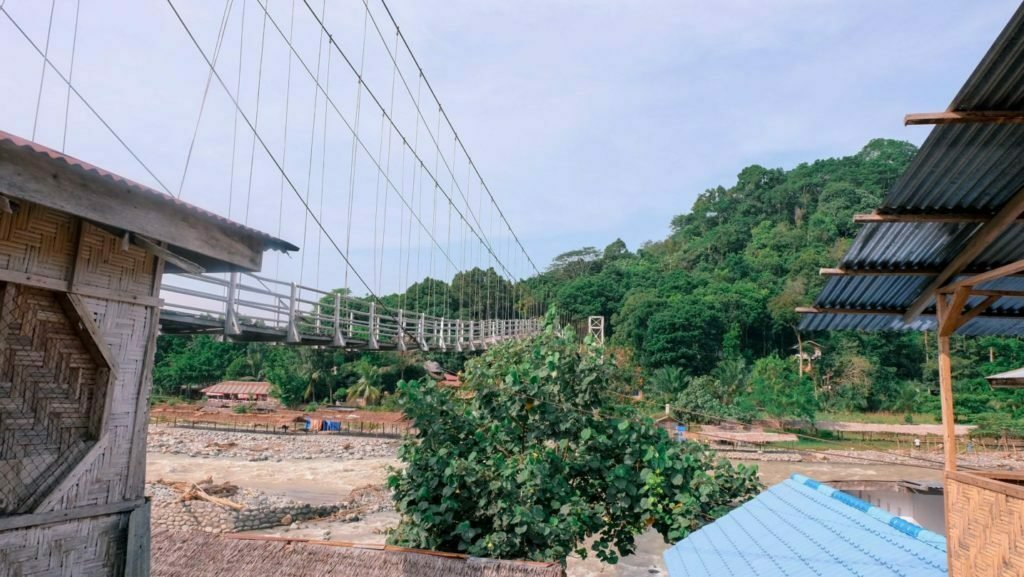
All of the tours can be booked through Hotel Orangutan . I highly recommend booking through them, because the guides are amazing and they really care about the animals and rainforest.
I did the day tour and chose to sleep in the hotel. I was able to see several Orangutans during my 1-day trip. If you are not a camping kind of person, the day tour is perfect for you. You will still get to experience the Orangutans up close.
Day tour cost: around 60 euros (the price depends on the number of people in the group)
Day tour duration: 8 hours
Inclusions: lunch, guides, entrance fee to national park, tubing (optional)
Other fun tours in Bukit Lawang: Bohorok River tubing, Village tour, Bat Cave tour, Tangkahan trip to bathe with elephants.
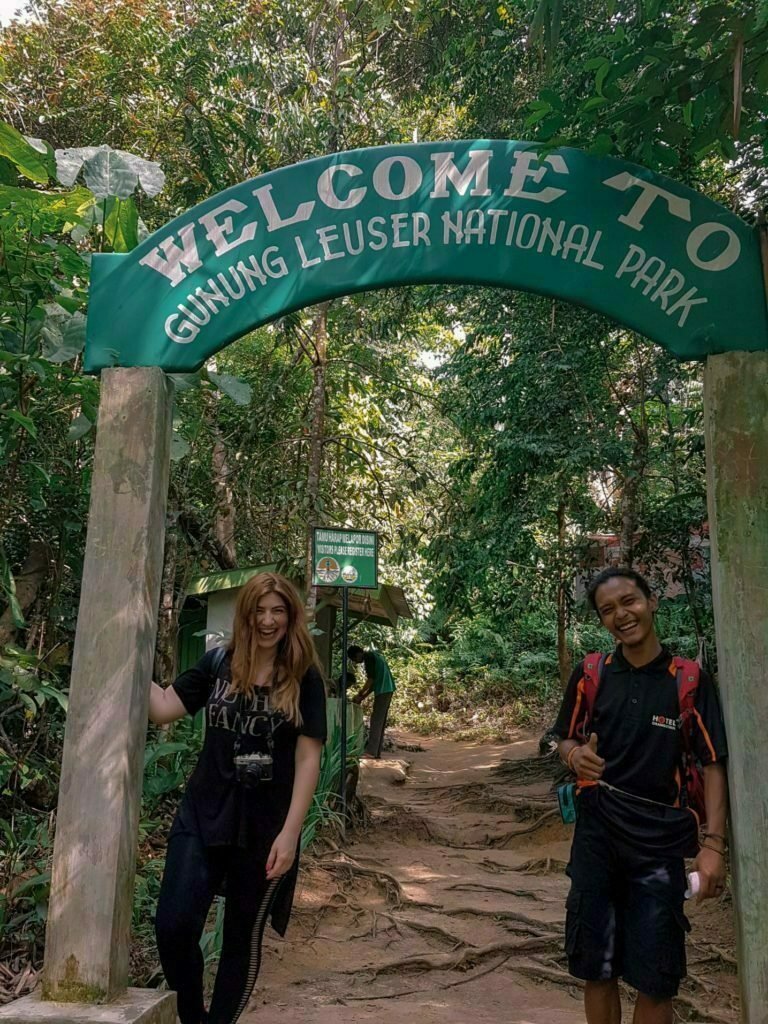
We started our trek from the hotel and walked through the village and onto the famous bridge to cross the Bahorok River. Given the proximity of the hotel to Gunung Leuser National Park, in under 30 minutes, we already found ourselves in the jungle.
As soon as we stepped foot into the rainforest, we came across several Thomas Leaf Monkeys. These monkeys were actually super friendly and are used to human encounters. Most of them approached us mainly hoping to get some food. They are not aggressive at all, so don’t be alarmed if they come close to you.
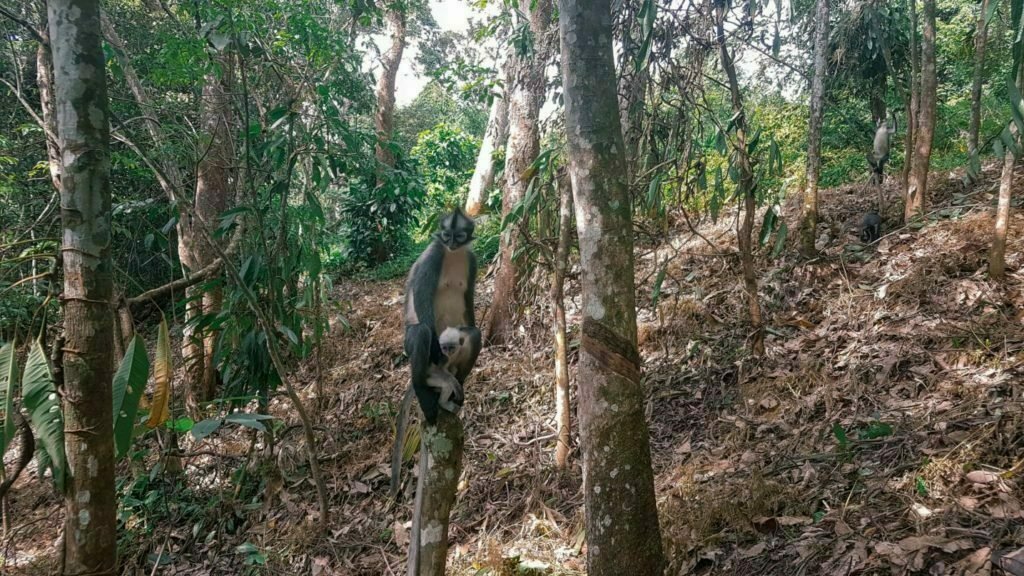
One thing you will immediately notice is the extreme heat and humidity. You will be drenched in sweat from the very first minute. The climate is quite rainy and humid all the time. It’s essential to bring lots of drinking water with you and possibly a change of clothes.
My tour was led by 2 guides and we were a total of 3 tourists. We started coming across other tour groups during our trek, who each had at least 10 to 15 people in their group.
After about 1 hour of trekking, we suddenly spotted our very first Orangutan! She was a medium-sized female mother with her baby. Both of them were high up on the tree and the baby was monkeying around from branch to branch. It looked like they were used to seeing other humans, because they acted as if we were not even there. The mom did give us a few looks just to make sure her baby was safe. It was amazing to just watch them go on with their lives in their natural habitat.
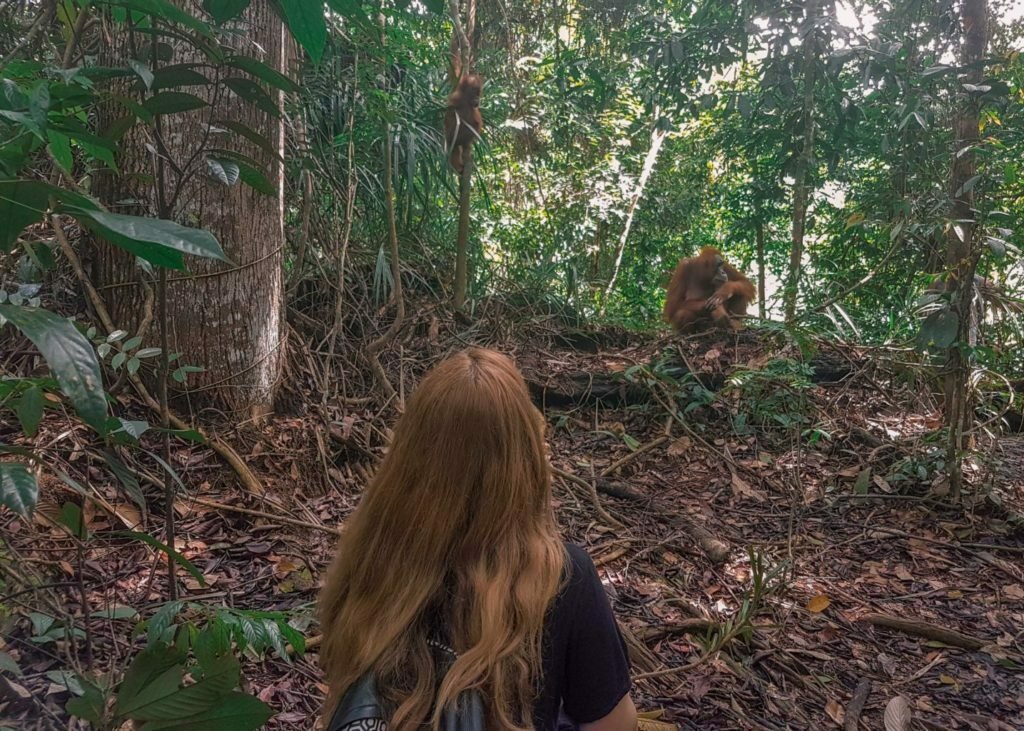
We continued trekking further into the forest and came across several female Orangutans. We were warned not to feed them, so that they don’t get used to relying on tourists to gather their food. We saw a few forest rangers during our trek that make sure tour groups are following the rules.
Warning: To ensure the conservation of Orangutans in the wild, please do not feed them or touch them. This is crucial for their survival and they can easily catch diseases from humans. We did see other tourists feeding them but stayed away.
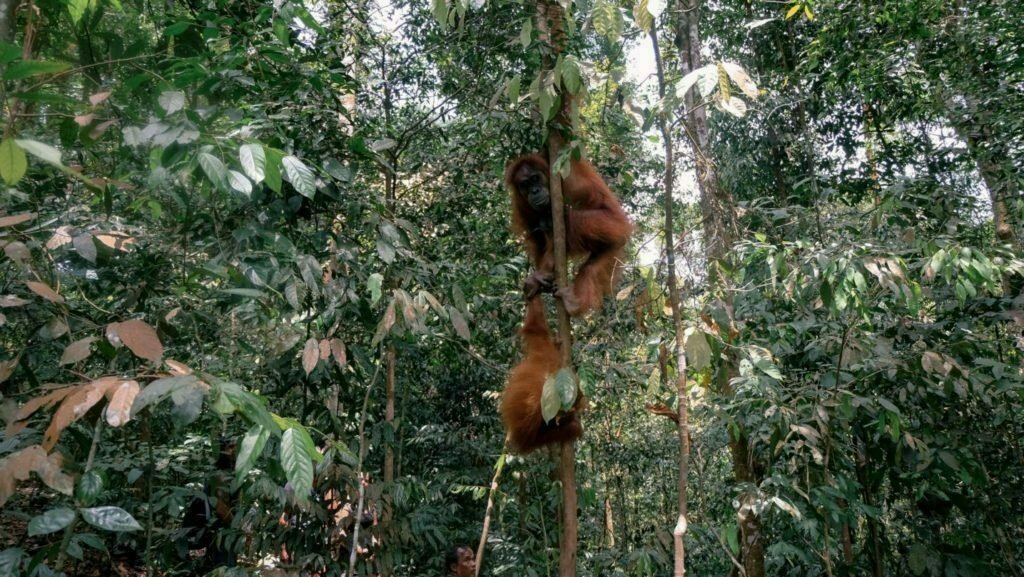
Around 3 or 4 hours into our trek, one of the guides told me to stop moving and stay quiet. I was quite alarmed and waited to see what was going on. He suddenly pointed behind me and I turned to see a massive male Orangutan just a few meters away! I can’t begin to explain the feeling of excitement and happiness I felt at that moment. This one was really huge and he wasn’t on a tree. He was walking around right next to us!
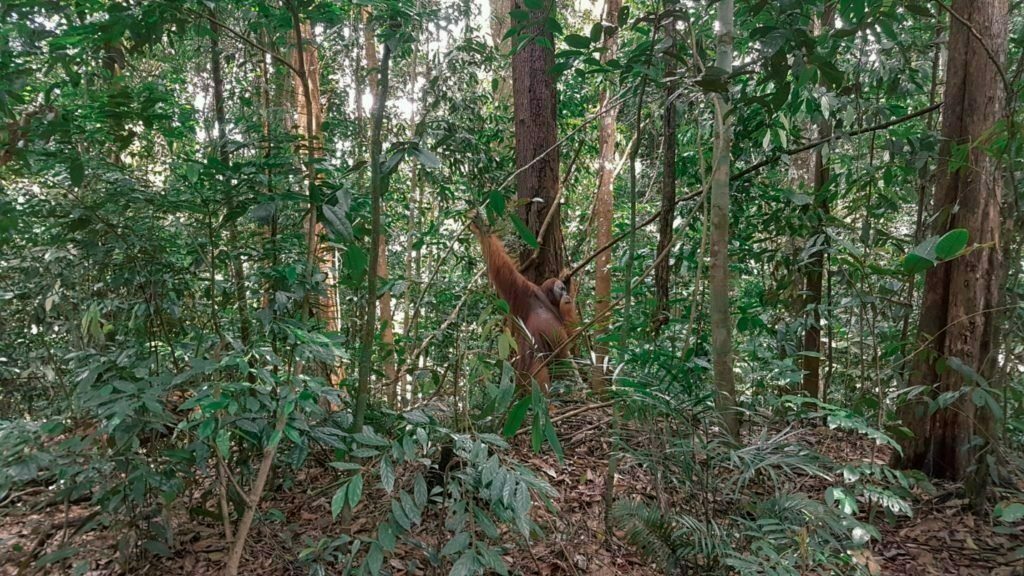
I gave my camera to the tour guide and tried to go as close as possible to see him up close. As I was posing for a picture, the Orangutan suddenly stopped and started staring at me from head to toe. I didn’t feel scared at all. In fact, I felt a sense of peacefulness take over me. It was as if we were buddies just hanging out in the jungle (keeping a safe distance apart of course!).
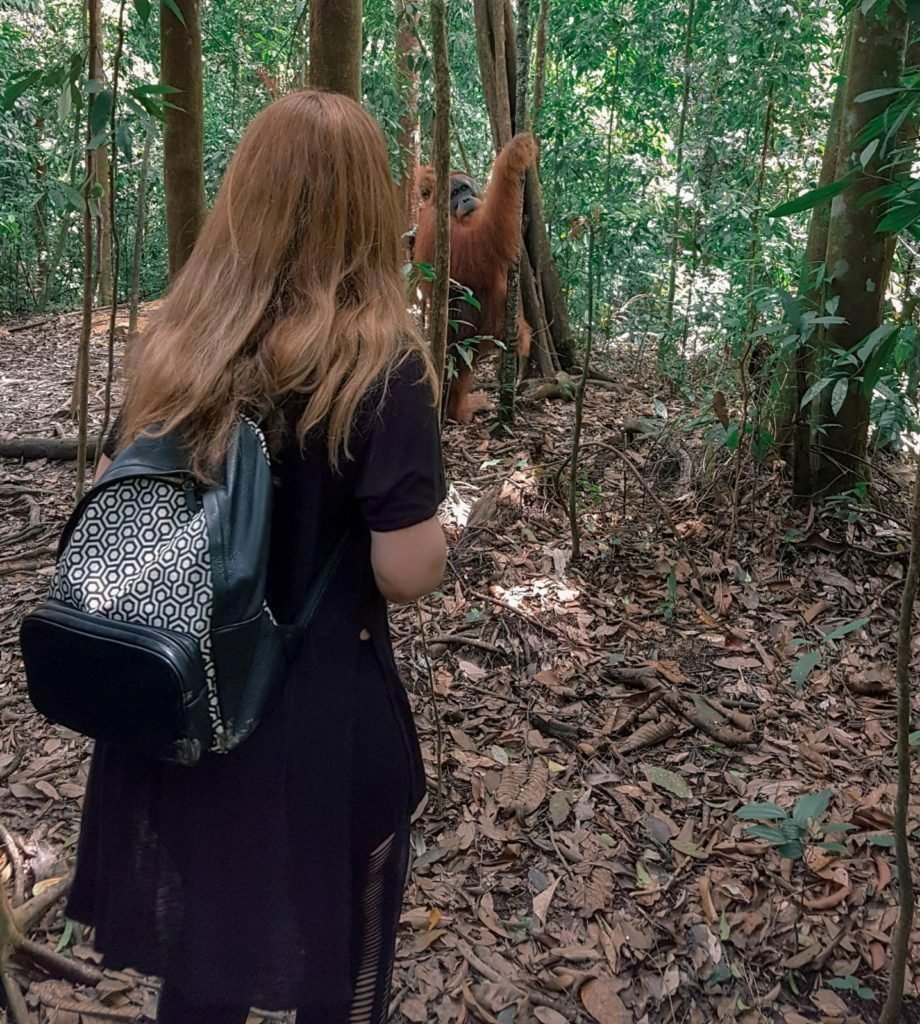
In this moment, my guide decided to tell me to be extra careful, because male Orangutans can carry 4 humans up a tree (funny guy!). In reality, my Orangutan buddy was so gentle. After chilling with us for a few minutes, he walked away and moved on with his journey. I will remember this very special encounter forever. It was definitely one of my favorite travel moments of all time.

Fun fact: you will come across several females and their babies in the forest. This is because males pay a visit just for mating reasons and then leave. It is actually much more rare to spot the big male Orangutans during your journey.
Four hours into our journey, we sat down in the jungle and the lovely guides prepared our lunch. The meal is basic but good with some rice, chicken and fresh fruits. The guides made sure to clean up every trace before we left our lunch spot.
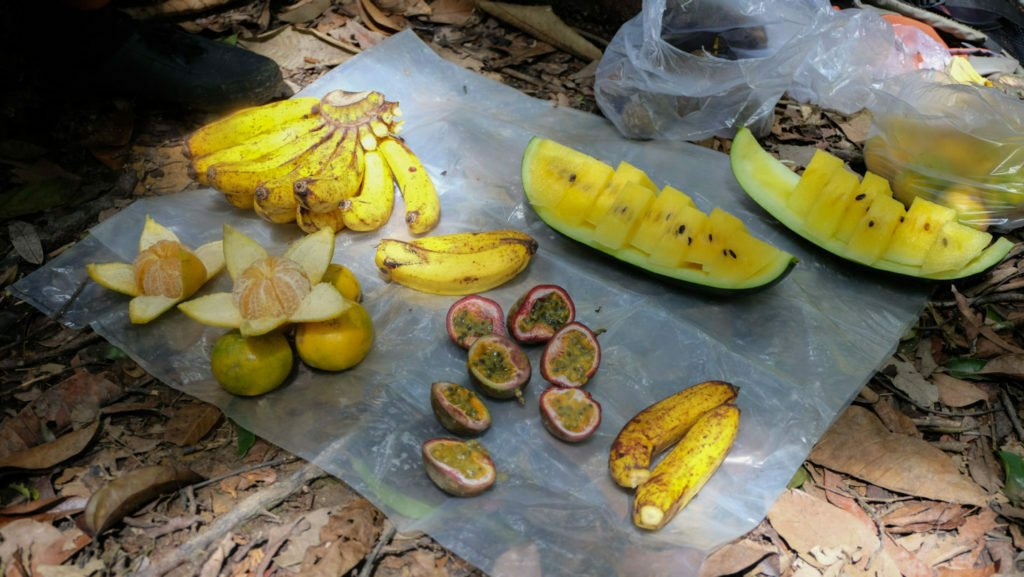
We started making our way back through a different pathway where we encountered even more females and babies. I think we saw a total of over 10 different Orangutans, which was absolutely perfect. Towards the end, we stopped by a small waterfall for a very refreshing swim.
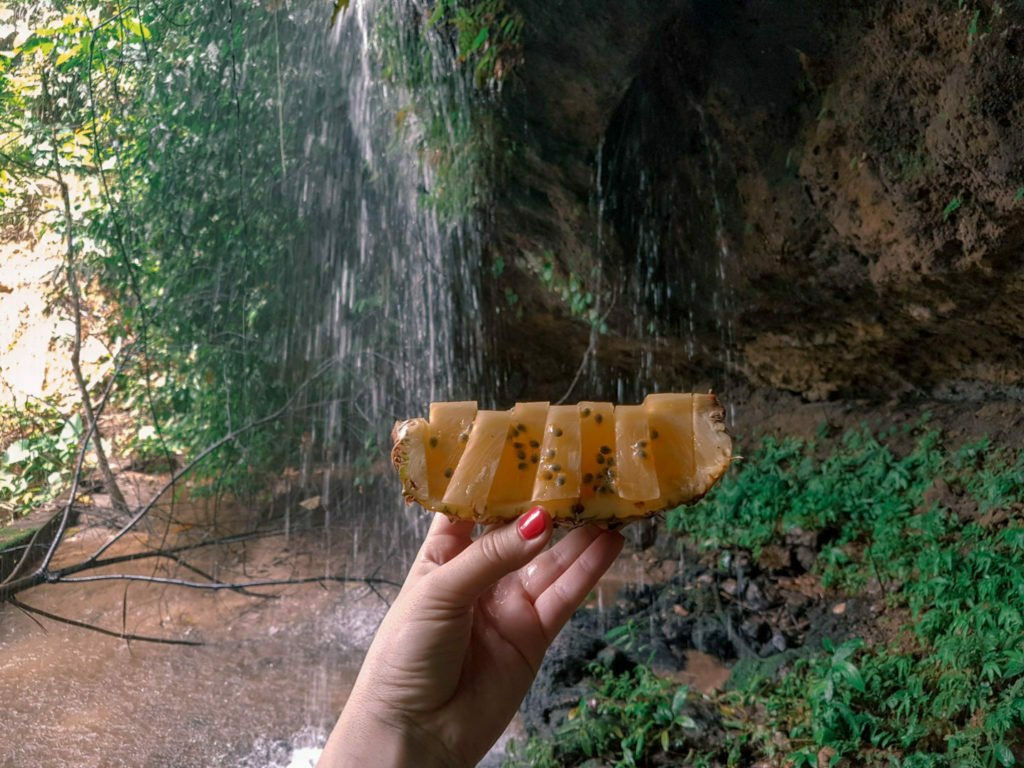
The total journey was about 8 hours. If you have a basic fitness level, you will be completely fine. There were some families with young kids and even seniors doing the trek.
The beauty of the rainforest and the close encounters with Orangutans will make you forget about the heat and humidity. The 8 hours felt more like 2 hours in my case. Just make sure to have lots of drinking water (at least 1.5 liters) and comfortable shoes.
The trek going upwards into the forest was easier than the way down. The pathway that we took going back down was a bit slippery and muddy, but the guides were so helpful and they let us walk at our pace.
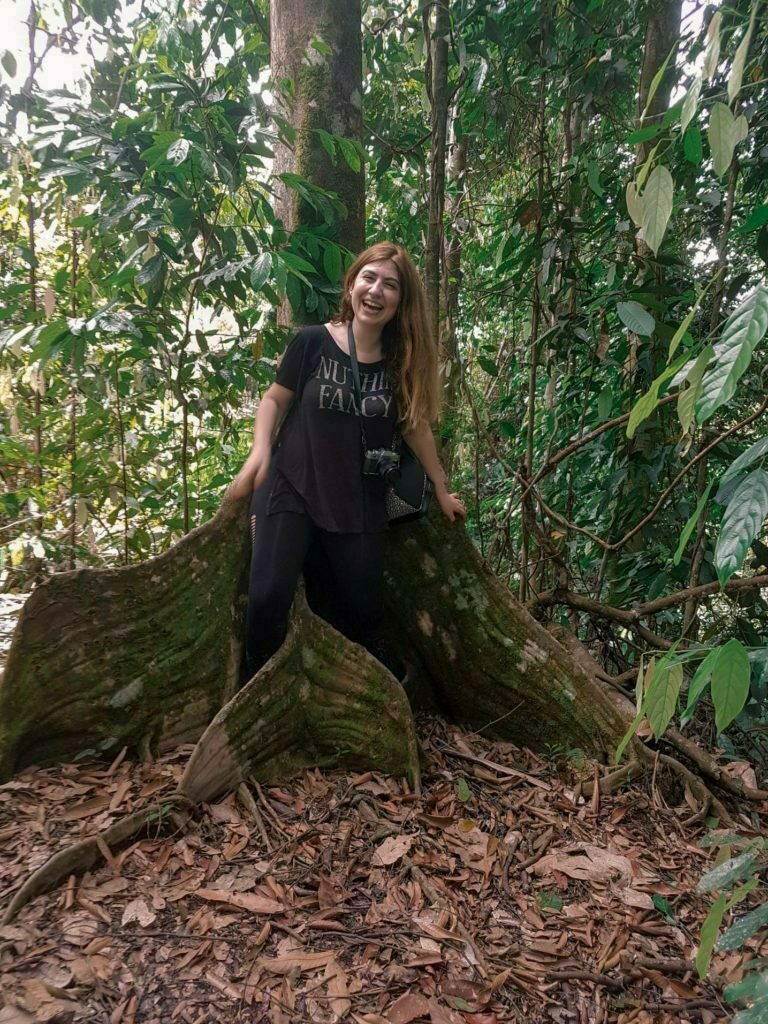
Trekking in the rainforest means that it could rain at any point in time. It’s important to protect yourself and your camera gear. You will also need a strong mosquito repellent and hand gel/wipes.
Make sure to pack: dry bag, backpack cover, hand gel, wipes, mosquito repellent, power bank, walking shoes, camera or Go Pro.
The biggest threat to Orangutans in Sumatra is losing their homes. Rainforests are being chopped down for timber or to make room for palm oil plantations. These amazing animals are declining in hundreds every single year. Another problem they face is illegal trading. Unfortunately, Orangutans are traded as pets and the babies are snatched from their mothers very early on in their lives.
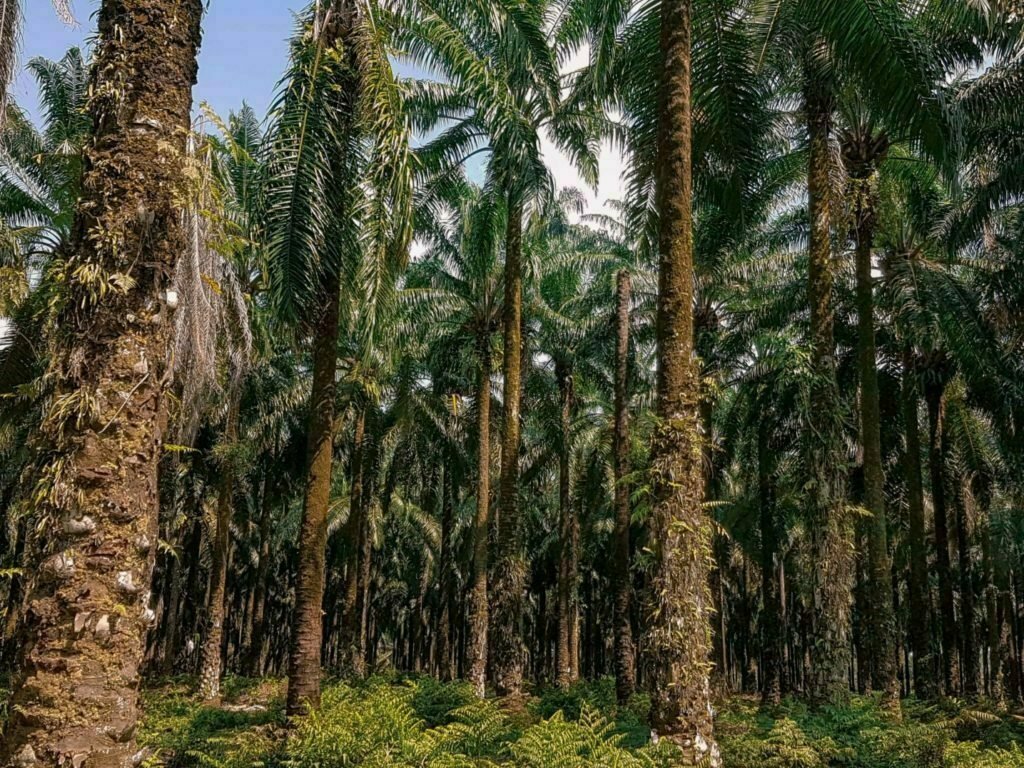
During our drive from the airport to Bukit Lawang, I was heartbroken to see so many palm oil plantations for several miles. It was quite shocking to see how much was cut down to make way for these plantations. I avoid using any products that have palm oil in them. These products are things we use regularly in our daily life.
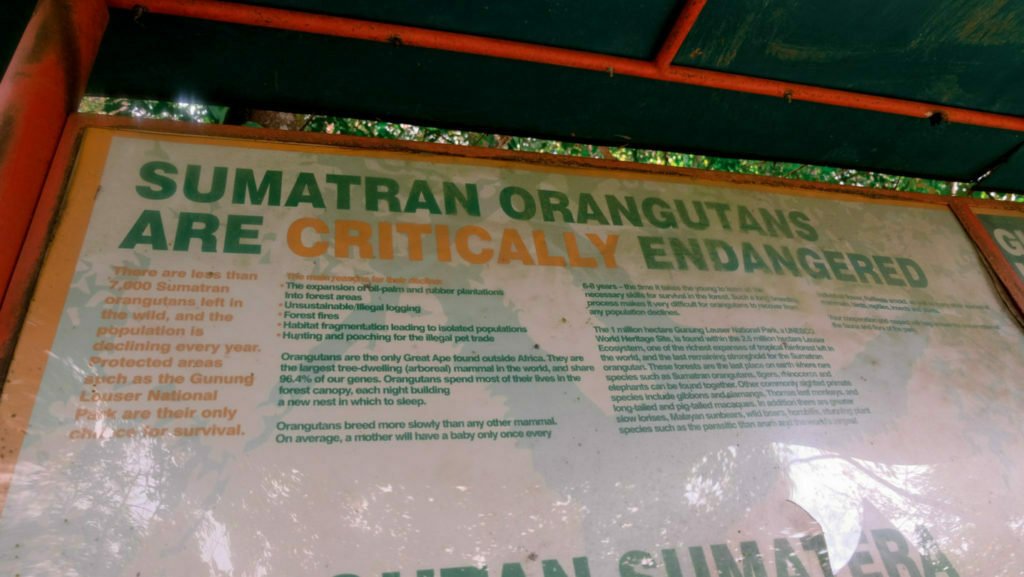
There are some great conservation efforts put into place by the Sumatran Orangutan Conservation Programme. Read more about them here .
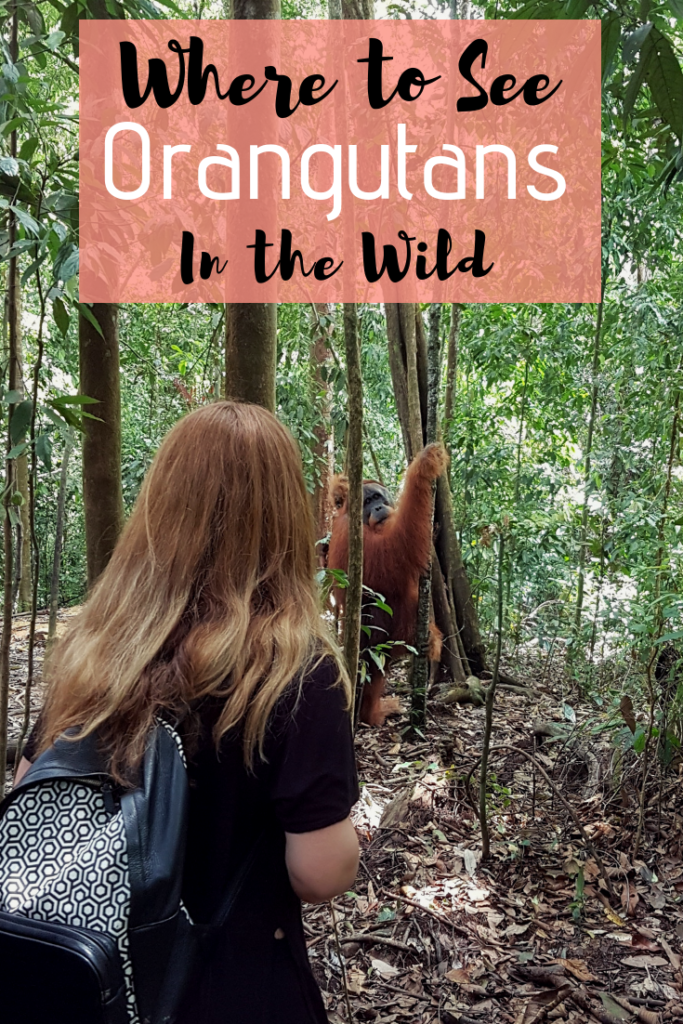
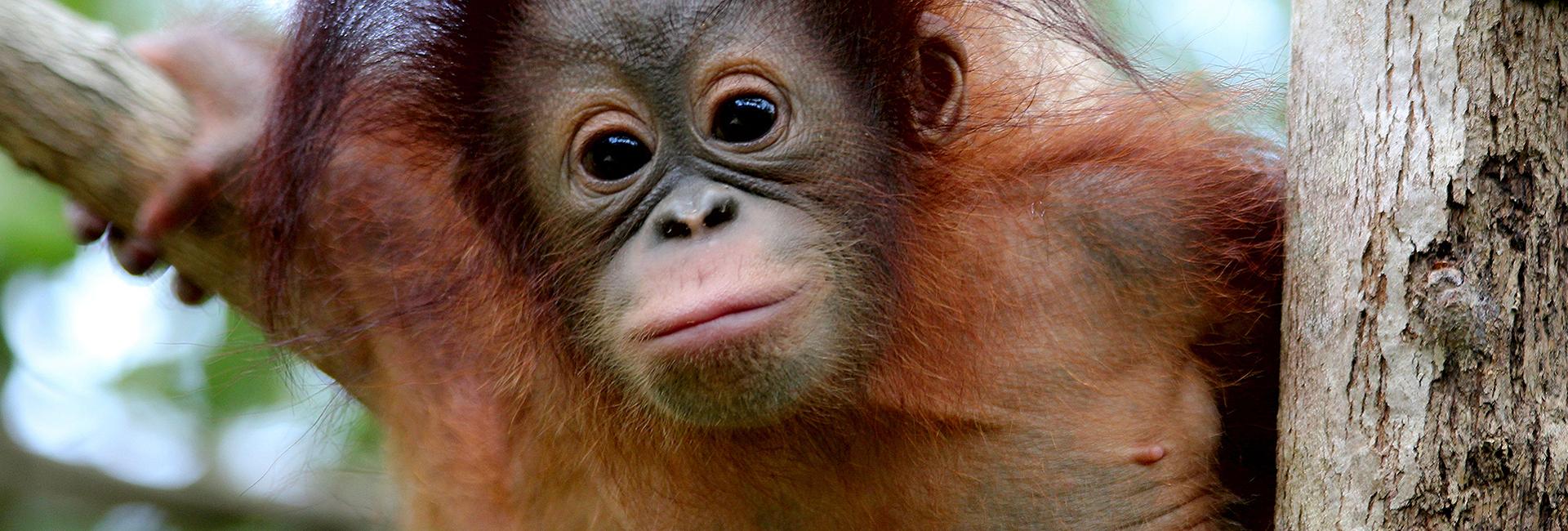
Visit The Orangutans In Borneo
Despite being one of the most instantly-recognisable and endearing animals on the planet, orangutans are in fact critically endangered. There are now only around 60,000 orangutans remaining in the wild, and these great apes need our help now more than ever.
The idea of working with orangutans is something many of us dream of, and by becoming an orangutan volunteer in Borneo, you will be making a real difference to this incredible species while also marking an extraordinary experience off your bucket list. The Great Projects are proud to offer the opportunity for you to visit the orangutans in Borneo on any one of our many orangutan projects: spend time at the Samboja Lestari Orangutan Sanctuary to volunteer with our arboreal cousins; pay a visit to the world-famous IAR Sanctuary in Indonesian Borneo; or make a difference when visiting orangutans on the award-winning Great Orangutan Project.
Volunteering with orangutans will be a worthwhile and memorable experience for any conservationist - to make a difference to our closest relative in the natural world, visit Borneo and take part in an orangutan experience with The Great Projects.
Projects Do More
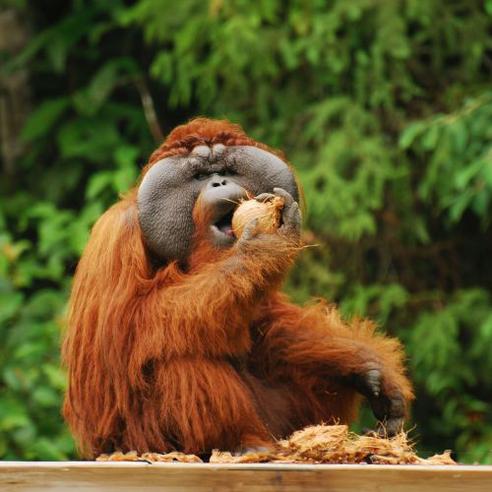
The Great Orangutan Project
7 - 28 nights from £795.00.
Volunteer with orangutans on this award-winning orangutan project at Matang Wildlife Centre in beautiful Borneo!
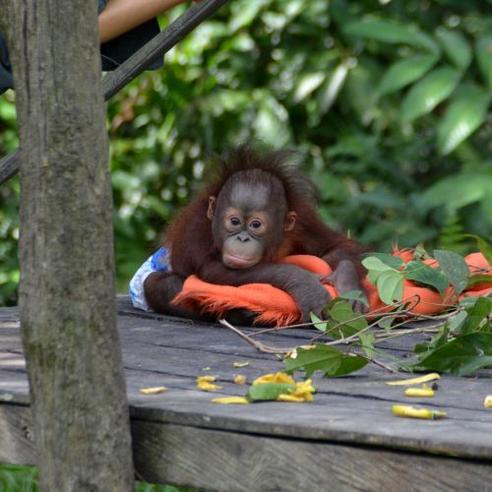
Samboja Lestari Orangutan Volunteer Project
12 - 26 nights from £1,395.00.
Work on enrichment for 112 orangutans and 72 sun bears at the world-renowned Samboja Lestari Rescue Centre
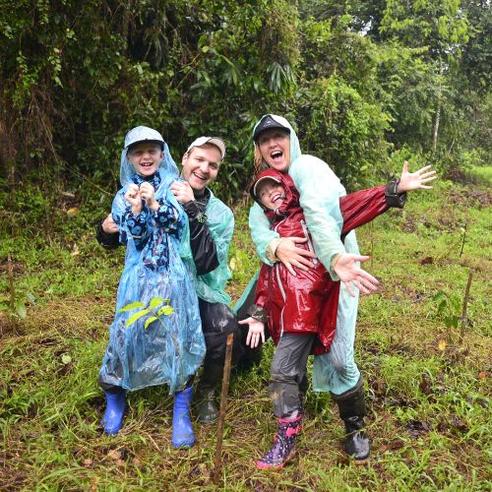
Family Volunteering in Borneo
6 nights from £845.00.
Travel with your family to Borneo, and see how you can aid orangutan conservation whilst meeting indigenous tribes-people on this exciting wildlife safari!

The Great Orangutan and Pygmy Elephant Project
11 nights from £1,395.00.
Help to restore Borneo’s rainforest and provide a safe home for wild orangutans and pygmy elephants.
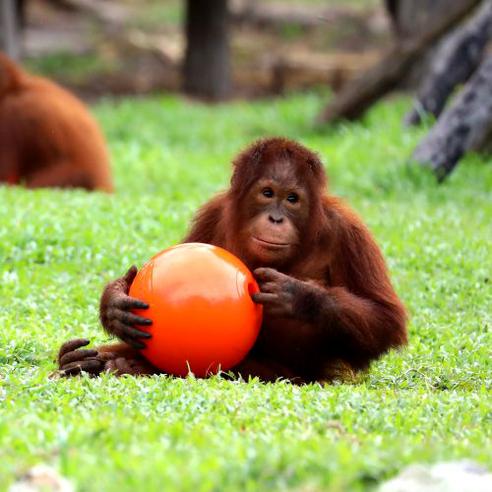
Nyaru Menteng Orangutan Sanctuary
12 - 26 nights from £1,195.00.
Help to rehabilitate the largest number of captive orangutans in the world at this world-renowned orangutan sanctuary in Borneo!
Tours See More
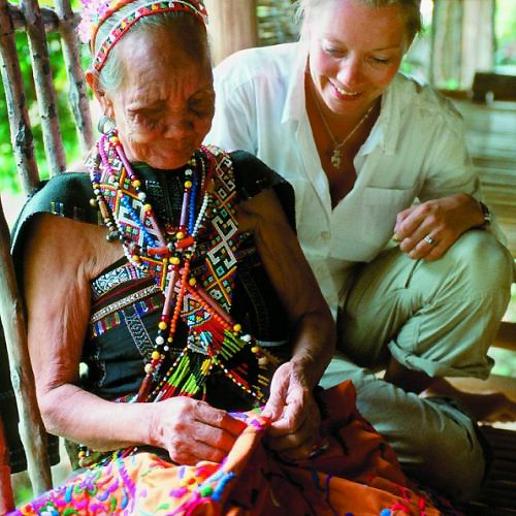
The Great Iban Longhouse Experience
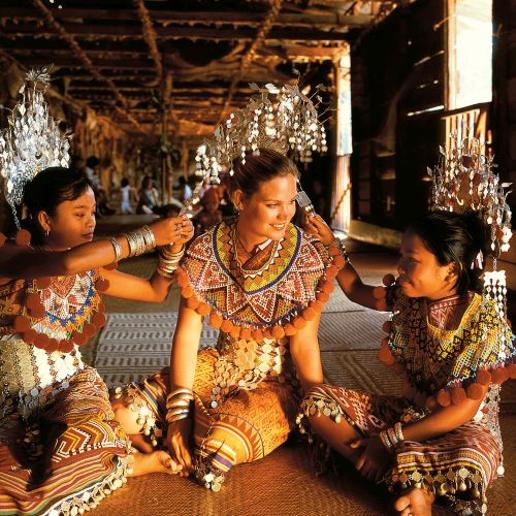
The Orangutan and Tribes Tour
Visit the orangutans in borneo information, orangutans at a glance.
Endangered Status
Critically Endangered
Number remaining in the wild
Around 60,000
Endemic Region
Borneo And Sumatra

SIGN UP TO THE NEWSLETTER

A Complete Guide to Seeing the Orangutans in Borneo
If you’ve been dreaming of seeing the orangutans in real life, then chances are Borneo is the place you’ve been imagining. And it sure sounds far-flung and hard to get to, but it’s surprisingly more accessible than you might think. A trip to Borneo can be done on a budget, but it can also be done in pure luxury. So this guide aims to cover everything you need to know about visiting Borneo – particularly Malaysian Borneo – including how to get there, where to go, what things cost and of course – where to see the orangutans in Borneo. Read on to find out more!
Where to see orangutans in Borneo?
First things first, it’s key to understand a little more about Borneo. Beautiful Borneo is the third largest island in the world, and by far the largest island in Asia. Borneo is home to three countries – Indonesia, covering the southern portion, Malaysia, covering the northern portion, and Brunei, occupying a teeny tiny 5,765km 2 (about 1% of the land mass!) and surrounded entirely by Malaysia.
Orangutans can be found in both Malaysian Borneo (split up as two Malaysian states called Sabah and Sarawak) and Indonesia (spit into the provinces of West, Central, South, East and North Kalimantan).
The only other place to see orangutans in the world is the island of Sumatra in Indonesia. So there are two species of orangutans – the Sumatran species and the Bornean species. Both have 96.4% identical DNA to humans!
And did you know that orangutans are the only great ape to be found outside of Africa? The others – gorillas, chimpanzees and bonobos are all found in Africa.
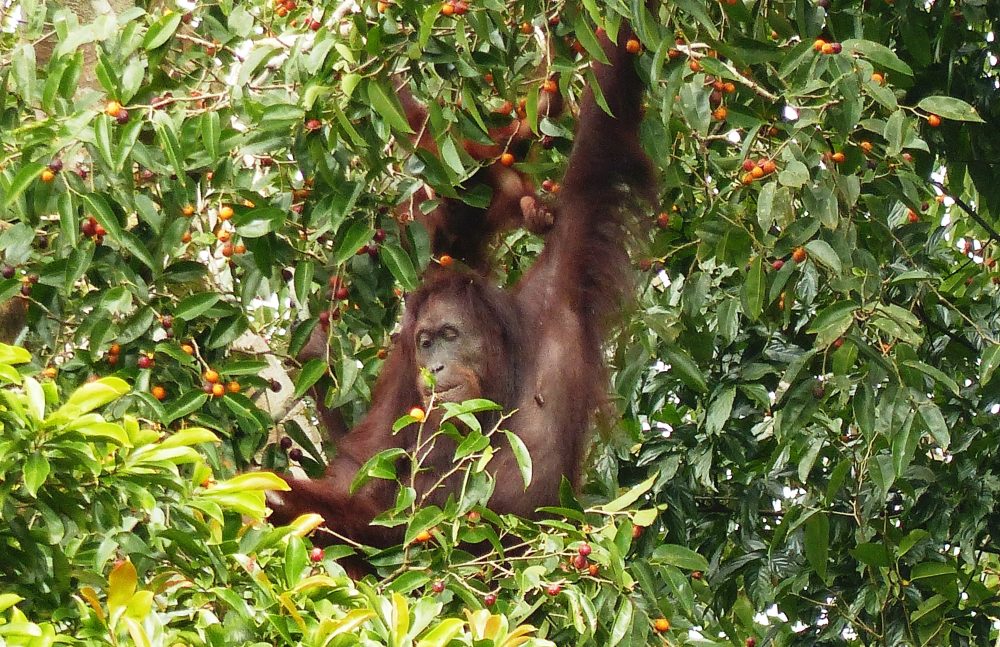
Malaysian Borneo or Indonesian Borneo?
One of the first decisions to make is deciding whether to go to the Malaysian part of Borneo, or the Indonesian part.
I did a lot of research before embarking on this trip. In the end, I opted for Sabah in the Malaysian part of Borneo in the north. There were a few reasons for this. For one I was flying into Kuala Lumpur, which had affordable and convenient connections onto Sandakan. And I’d read that animal sightings were more common as the area was smaller (covering only about 25% of the island). Tourism infrastructure is also more developed here, and I had identified some accommodation and tours that really met my expectations, and so, I was set on northern Sabah – specifically around the Kinabatangan River.
This part of Borneo is also home to Mt Kinabalu (one of the highest mountains in the world!), and also the vibrant city of Kota Kinabalu – two locations I was also very keen on seeing.
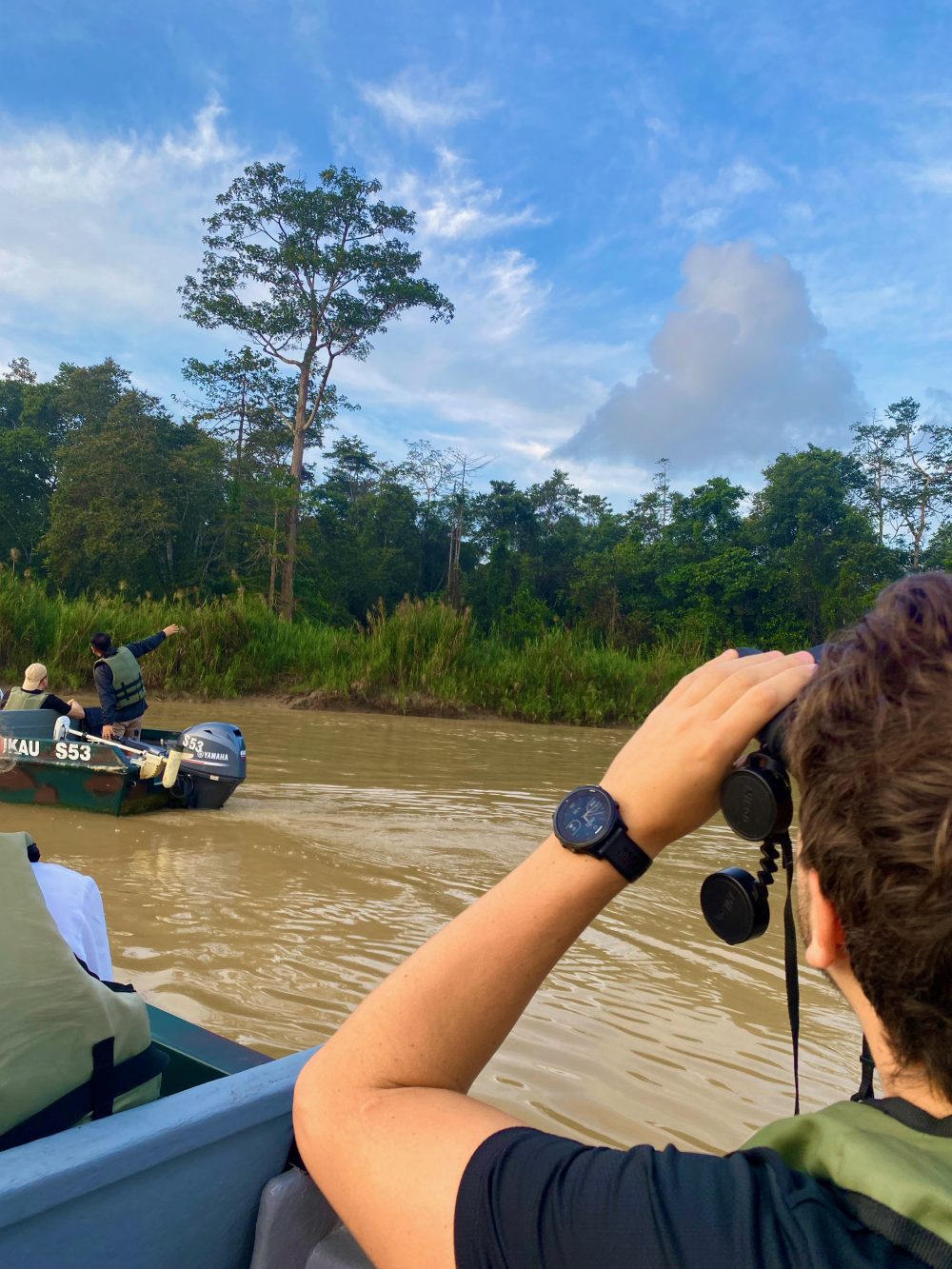
The state of Sarawak is slightly more challenging to get to – the main airport is Kuching. But Sarawak is home to 30 national parks covering its magnificent rainforest, mountains and coastline. Sarawak offers a deeper dive into indigenous tribes, traditions and cultures. I found we saw less of this in Sabah, which has a more established tourist setup compared to Sarawak.
Kalimantan Indonesia is even more far flung. It covers a whopping 76% of the island of Borneo, so it can be harder to see orangutans in the wild – especially as the tourism infrastructure is still somewhat limited here.
The Indonesian states and the Malaysian state of Sarawak both provide a complete adventure and incredible wildlife, but for the purpose of the rest of this guide, I will be focusing on Sabah.

Borneo Travel Guide: Useful Information
How to get to sabah, borneo.
The main way to arrive in Sabah is by plane. The two main entry points are either Kota Kinabalu, the capital, or Sandakan, the airport nearest the northern rainforest area.
We flew into Sandakan to begin our adventure. Then at the end of the week, we took a very quick internal hop from there to Kota Kinabalu, which is where we flew onwards to Manila .
Air Asia and Malaysian Airlines both fly to Sandakan from Kuala Lumpur multiple times a day, with the flight taking about 3 hours. This flight often costs as little as £30. You can also start your Borneo journey in Kota Kinabalu if arriving from other Asian cities such as Singapore, Taipei, Penang, Seoul or Hong Kong. Flights between Kota Kinabalu and Sandakan take about 40 mins and can be as cheap as £15 or so.
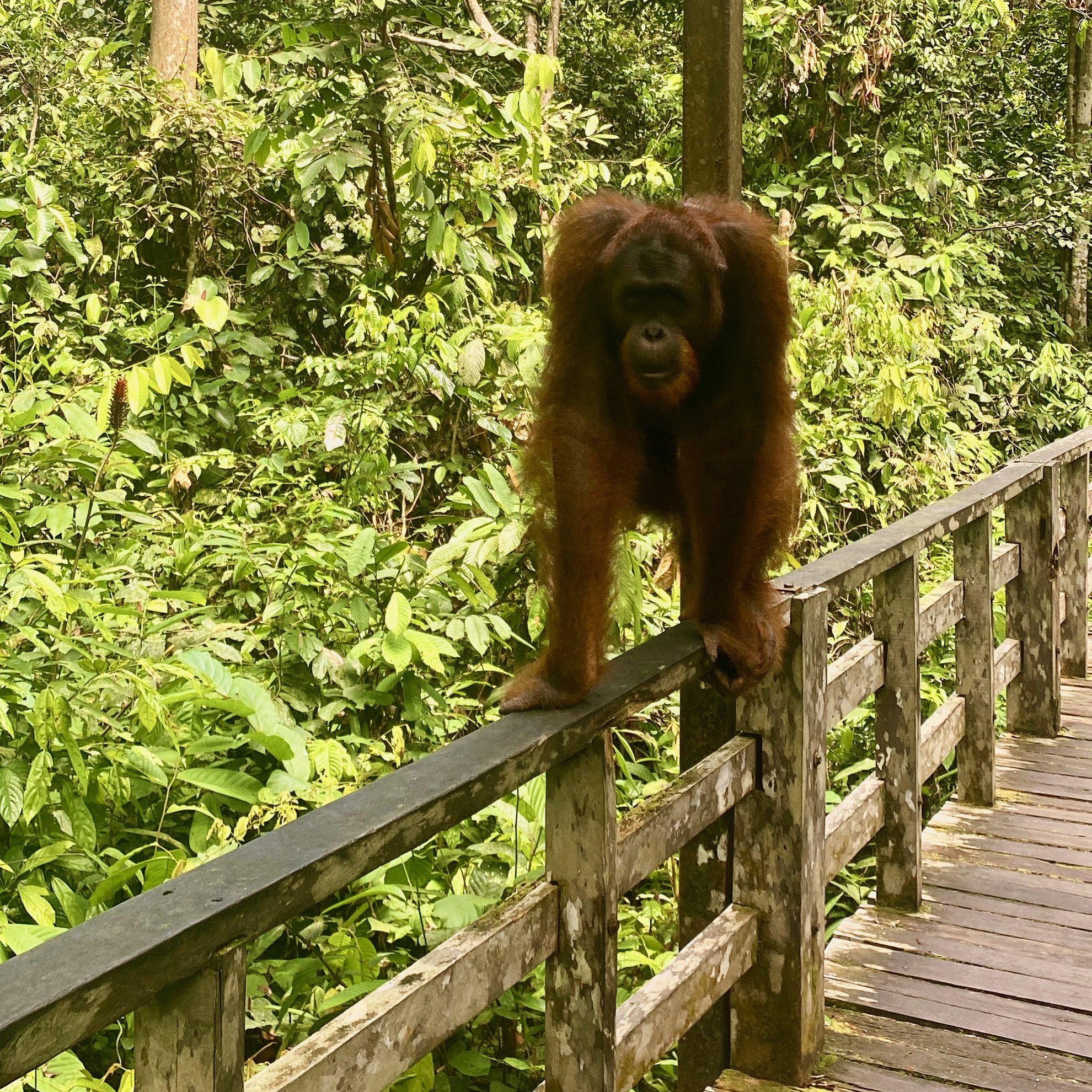
Malaysian visas, currency and budget
Visas to Malaysia are straight forward, and dozens of nationalities are eligible for visa-free entry. This includes EU countries, the UK, the UAE, Canada, the US, Australia, New Zealand, South Africa and Brazil.
The currency in Malaysia is the Ringgit. Malaysia is a little more expensive than other places in South East Asia, but a fair bit cheaper than Singapore!
I’ve written a detailed post about covering all essential information for visiting Malaysia here , which I recommend checking further information.
How to get around Sabah, Borneo
One of the game changing things about travelling South East Asia now, compared to my first visit in 2010, is the introduction of ride hailing apps. The main one in Malaysia is Grab – and my goodness, is it game changing. No standing around on roads trying to hail a local taxi and then haggling over short journeys.
Once we landed at Sandakan airport, we simply hopped in a Grab into the centre of town. We also used Grab in Kota Kinabalu from the airport to the port. It’s just like Uber and the journeys were always so inexpensive. It’s so easy to take Grab that it doesn’t really make sense to try and navigate local buses or use any other method.
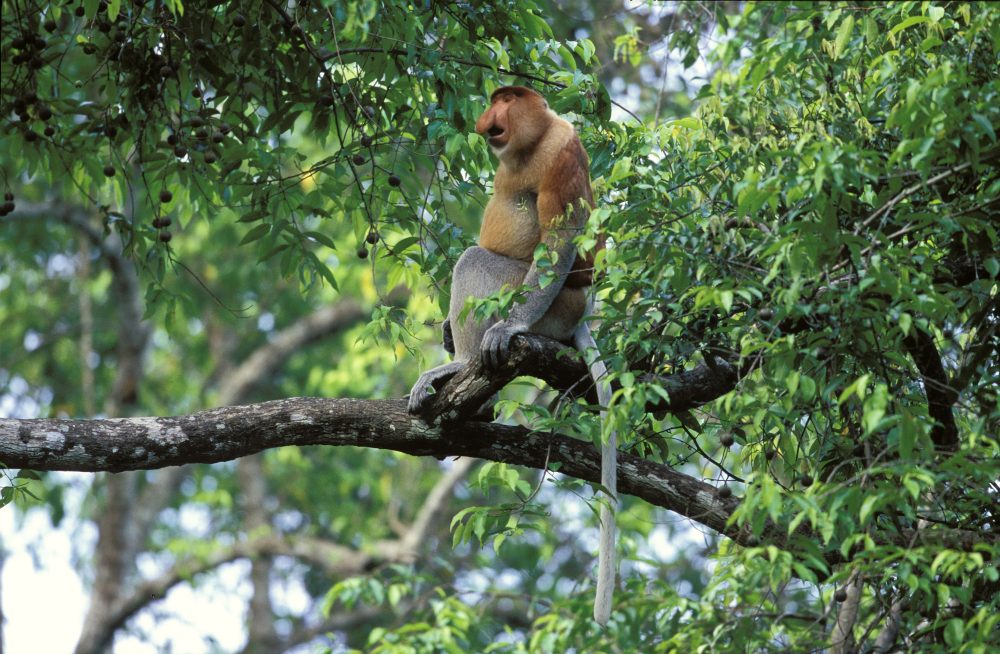
When is the best time to go to Borneo?
April to September is typically the best time to go to Borneo. Unlike the rest of South East Asia, June to August is particularly dry whereas the rest of the region faces frequent daily showers in these months.
However, November through to February is monsoonal in Borneo. When speaking to our guide, he described it as torrential and near pointless trying to visit in this time. He said these aren’t just tropical showers, but nearly all-day rain. It means most of the guides are out of work during these months, waiting for the peak season again. And similarly, this weather can make seeing the orangutans in Borneo difficult.
We went to Borneo in April and the weather was perfect. Hot and humid, with one downpour in 4 days (which was really refreshing, plus we were on a speedboat on the river!). A friend of mine went to Sandakan and the Kinabatangan River in February and said they did experience an awful lot of rain.
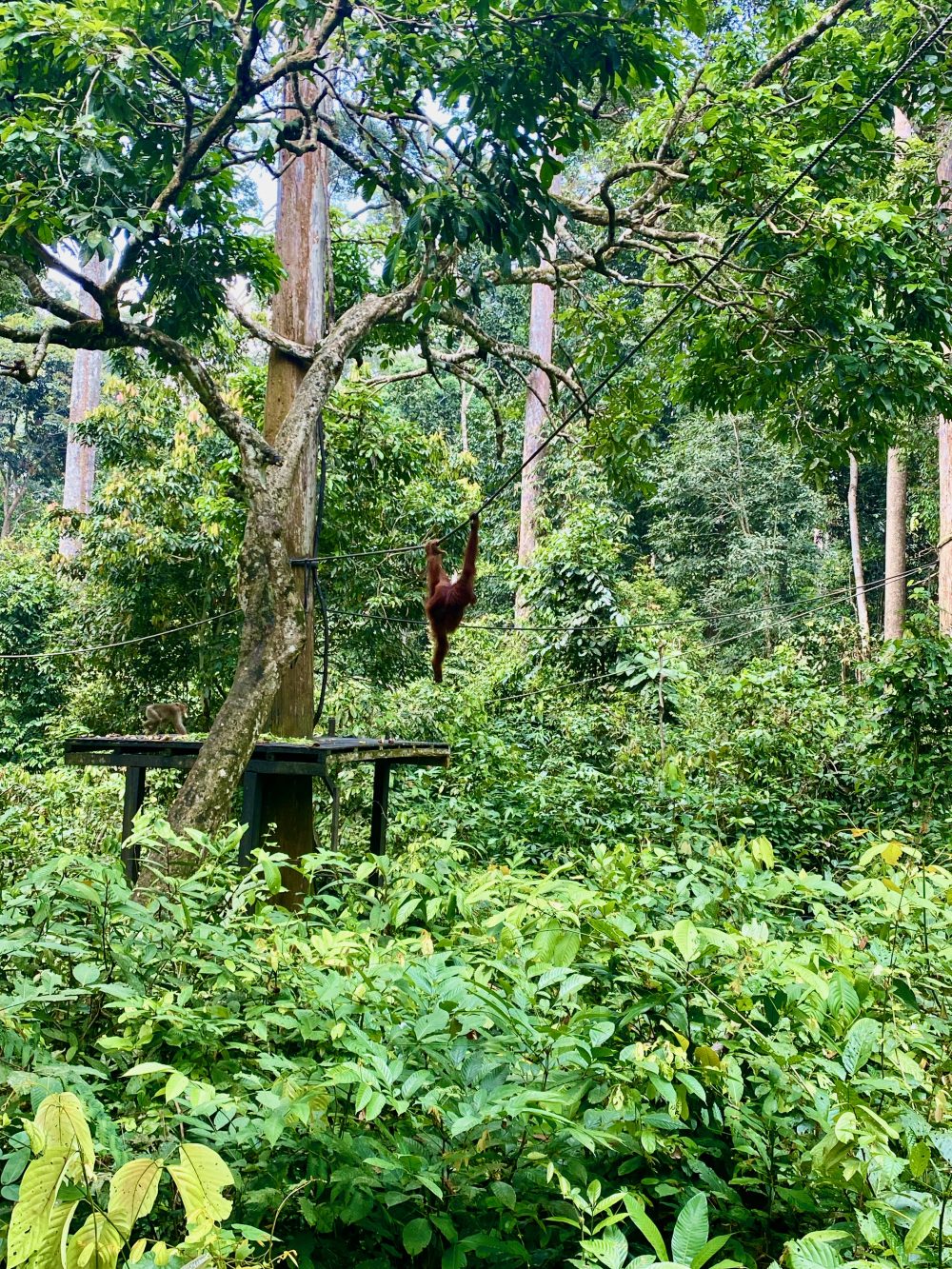
How long do I need in Borneo?
I would say you need a minimum of three days in the rainforest. I do know you can fly in and fly out from Kota Kinabalu into Sandakan in a day as part of tour, but I don’t recommend this. The adventure lies in exploring the rainforest after all!
Some people do visit Sandakan and just go to Sepilok, a small town 30 minutes away. Sepilok is home to several animal sanctuaries and centres. You need two days in Sepilok, ideally. But as you are guaranteed to see orangutans here, I see why you could in theory do just the day visit.
I would strongly recommend joining a tour and heading out along the Kinabatangan River. You need a minimum of two nights to do this. But we did a tour that took in Sepilok at the start and finish, and meant we saw all the key highlights in three full days. Amazingly, it was brilliant and we were so satisfied with our animal sightings along the river in this timeframe – and we also had plenty of downtime to relax. But, if we were to go back, I think I’d add in another lodge even deeper in the Kinabatangan River. After all, you have travelled a long way.
So, my final answer is – a minimum of five days in total – two days in Sepilok, two to three days deeper in the rainforest. And if you’re an animal fan, I’d add another 2 or 3 days onto that.
You are likely to need an additional night either side of any rainforest adventure because of flight timings and early starts.
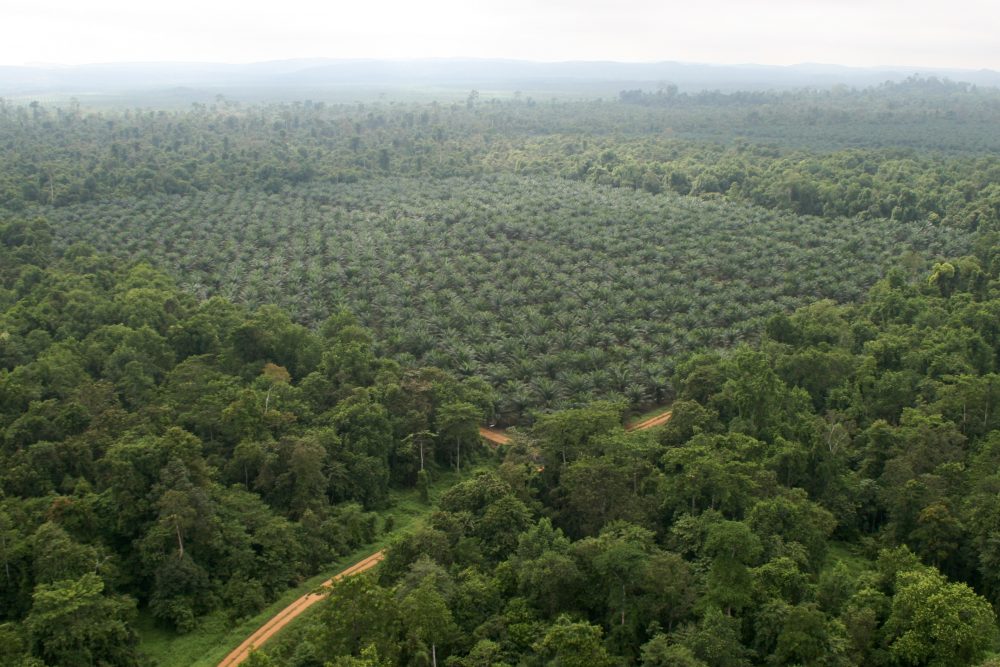
Our time in Sabah looked like this:
- Day 1: Landed in Sandakan 6pm in the evening, checked into local hotel
- Day 2: Picked up at 8am for day 1 of the tour (morning and lunch in Sepilok, speedboat along the Kinabatangan River to our lodge to arrive by 3pm, free time, evening safari and first night in the rainforest)
- Day 3: Full day in the rainforest at our lodge (morning river safari, free time, evening river safari)
- Day 4: Morning at the lodge before departure back to Sandakan. Back to Sepilok to visit the Rainforest Discovery Centre before checking into local hotel in Sandakan
- Day 5: Early departure from Sandakan airport to Kota Kinabalu, arrive 10am.
We met a couple in Sepilok’s Rainforest Discovery Centre who had visited 10 days in a row as they were passionate birders and absolutely loved the viewing areas!

What to bring on a trip to Borneo?
Bug spray, bug spray, bug spray! The mosquitos are in the millions, and the biting felt incessant, especially from about 5pm.
I would also say to bring some long, lightweight trousers and proper closed toe shoes.
Even in the dry season, there can be sudden downpours so when you head out in wildlife river cruises, the guides advise to take a hat, suntan lotion and a raincoat!
Where to visit in Sabah to see the orangutans?
So, we’ve got the logistics down, but where to see orangutans in Sabah?
As just mentioned, you are guaranteed to see orangutans in Sepilok. This small town is just 26km from Sandakan and is home to the Sepilok Orangutan Rehabilitation Centre. You will 100% see orangutans here. Nearby is the Rainforest Discovery Centre, another place where you have a high chance of seeing orangutans.
A trip along the Kinabatangan River – the second longest river in Malaysia – is another key place to spot orangutans where over 1,100 live. Yet it is significantly harder to spot them as they are rather elusive and the rainforest here is very dense.
We saw two orangutans at our lodge, far along the Kinabatangan River. However, we saw far more at the Sepilok Orangutan Rehabiliation Centre, and therefore, for close and intimate viewings, you have to go there. Plus, they are strictly arboreal (living in the trees) so you do have to be surrounded by the thick rainforest to have a chance of seeing orangutans.

Other areas in Sabah, Borneo to spot orangutans in the wild include Danum Valley, the Tabin Wildlife Reserve and Deramakot Forest Reserve. You can only visit these locations on longer trips to Sabah due to the added travel time to get there. If had had more time in Borneo, Danum Valley would have been my pick to add another 2 or 3 nights.
What other wildlife can you see in Borneo?
So of course, most people come to Borneo with the goal of seeing orangutans. But there’s actually a Borneo Big Five!
The wildlife animals in the Big Five include: the Pygmy Elephant, the Proboscis Monkey, the Rhinoceros Hornbill, the Estuarine Crocodile and of course, the Orangutan.
We were lucky enough to see all of these, except the Rhinoceros Hornbill, during our three days in Borneo. But other guests were even luckier and did see the Rhinoceros Hornbill!

On one of our afternoon river cruises along the Kinabatangan River, I saw a flash of black and then a swooping primate swinging between the trees. Our guide was seriously excited. He told us it was the Bornean Gibbon – a rare sighting and something he hadn’t seen in over 4 months!
I also loved the Proboscis Monkey. These are endemic to Borneo, which means they can’t be found anywhere else. They also really stand out due to their very large noses. In fact, their noses hang down their faces and are distinctive. It’s only the male proboscis monkeys that have this nose. And apparently, female proboscis monkeys prefer to mate with male proboscis monkeys with the larger noses…
This was actually the animal we spotted most frequently in the wild whilst cruising along the Kinabatangan River. We also saw dozens of long tailed macaques, many of which were very curious about us and caused the tall trees to swing all over the place.
Other animals to spot include the clouded leopard (extremely rare), the western tarsier, sun bear, the civet and the pangolin.
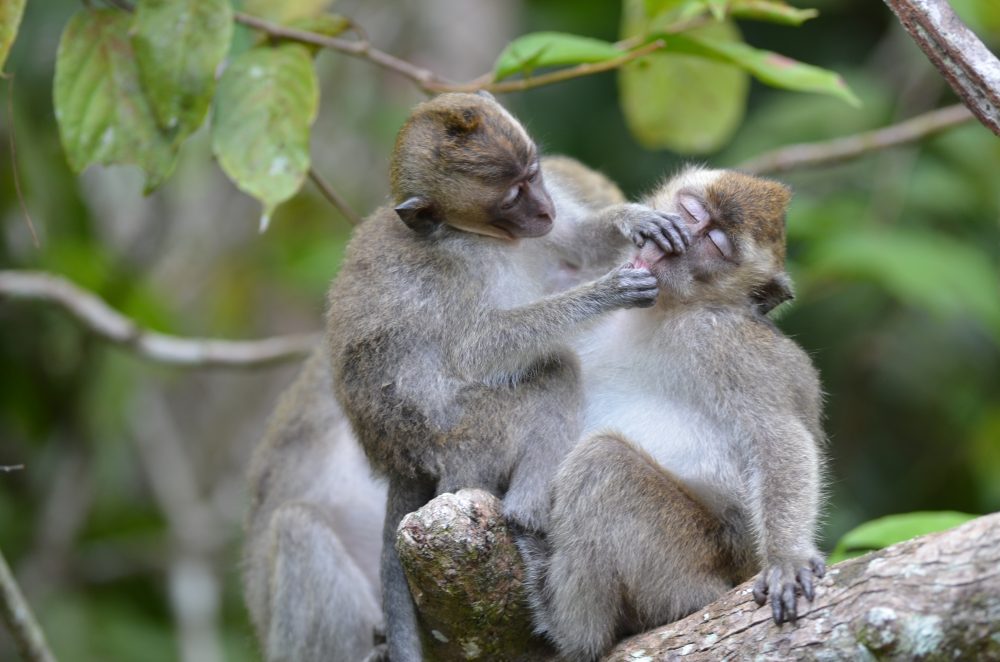
Should I explore Borneo on a tour or independently?
I would say that Sandakan to Sepilok is very easy (even just jump in a Grab). There’s plenty of accommodation options in Sepilok and the area is small and walkable. However, I don’t think you should even attempt to visit the Kinabatangan River independently. Firstly, I don’t know how you’d travel to such a remote location without using the speedboats of one of the lodges. I don’t think there are local boats to catch up the river. Secondly, to try and visit the rainforest independently means risking your safety (wild animals!). It also means not receiving the incredibly interesting and insightful information from your tour guides.
We arranged our whole rainforest adventure with Borneo Eco Tours (sometimes called BET). I couldn’t recommend this experience enough. You can book them for tours in both Sabah and Sarawak. We specifically did this tour here – Kinabatangan Wildlife Safari (by boat) 3D2N (code BB7D for booking). Whilst it wasn’t particularly physically challenging in any way, the tour was so efficiently organised. It really helped us achieve everything we wanted in Borneo.
It isn’t too cheap – MYR 2,820 per person, based on two people sharing. This is approx. £500 per person or USD$614. But it did take care of everything. From transport, accommodation, all meals, river cruises, and entry to the main sights in Sepilok. Plus of course, the excellent guides. That’s about £166 per person per day, which I felt was a fair cost for the experience.
You can book directly on their site here . Here you will be connected with one of their helpful customer service staff via email. They will help ensure you’re booking the best tour for you and advise on all other logistics – an invaluable resource.
Borneo Eco Tours own the most amazing lodge, located along the banks of the Kinabatangan River. It’s called Sukau Rainforest Lodge and is one of National Geographic’s Unique Lodges of the World.

Accommodation options in Sabah, Borneo
Sukau rainforest lodge.
As just mentioned, I personally stayed at Sukau Rainforest Lodge, which was about a 2.5hour speedboat from Sandakan, nestled along the Kinabatangan River. It was absolutely perfect, and the best luxury stay in this part of Borneo.
Your stay here is on a full board basis, so excellent buffet breakfast, lunch and dinners are included. Alcoholic drinks are an additional cost. The food was really impressive and hugely varied. We loved the Asian options and enjoyed the chance to try some more unusual dishes.
There are two room categories. The more affordable option is the superior room, tucked away behind the main social areas of the lodge. These rooms offer excellent facilities and very comfortable rooms.
The other option is a Borneo Villa, which is what we booked. We found the villa to be very luxurious and completely magical. We loved sitting by our balcony where all kinds of wildlife would swing by. Or even stomp on the roof of the villa! The Borneo Villas are tucked away down wooden boardwalks, meaning they feel really private and are completely surrounded by the rainforest.
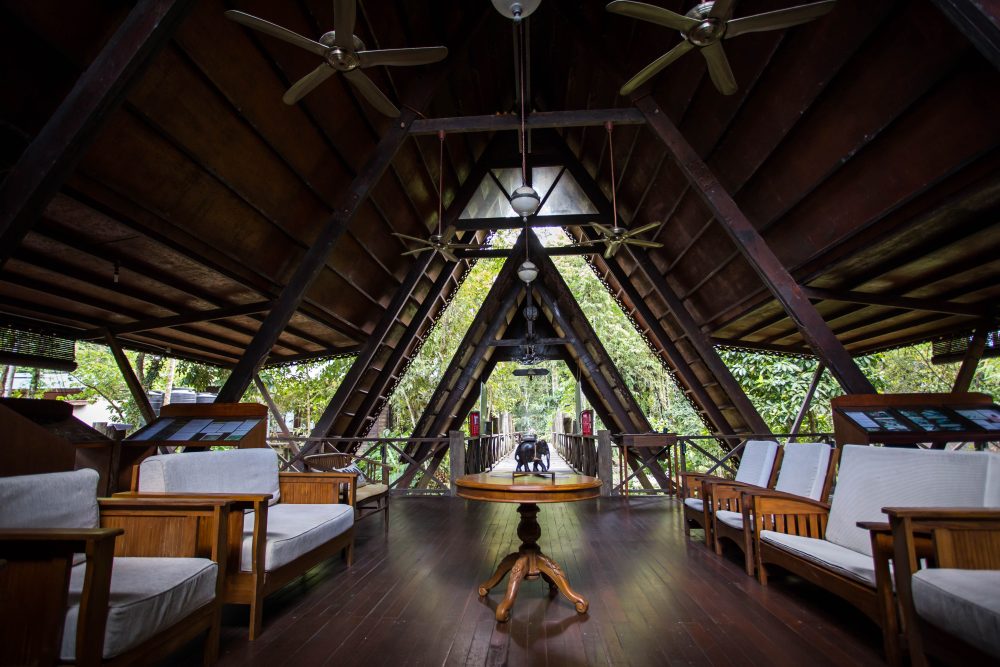
River wildlife safaris are conducted twice a day, with one at sunrise and one departing around 3pm. Each boat has a highly informative guide on board who will endeavour to spot as much wildlife as possible. There is also the option of a night cruise at a small additional charge, which goes out with a flashlight. We saw a lot of crocodiles and snakes during this cruise but no orangutans as they were fast asleep!
Also, there are a couple of delightful outdoor pools here, making for an all in all, wonderful and relaxing stay!
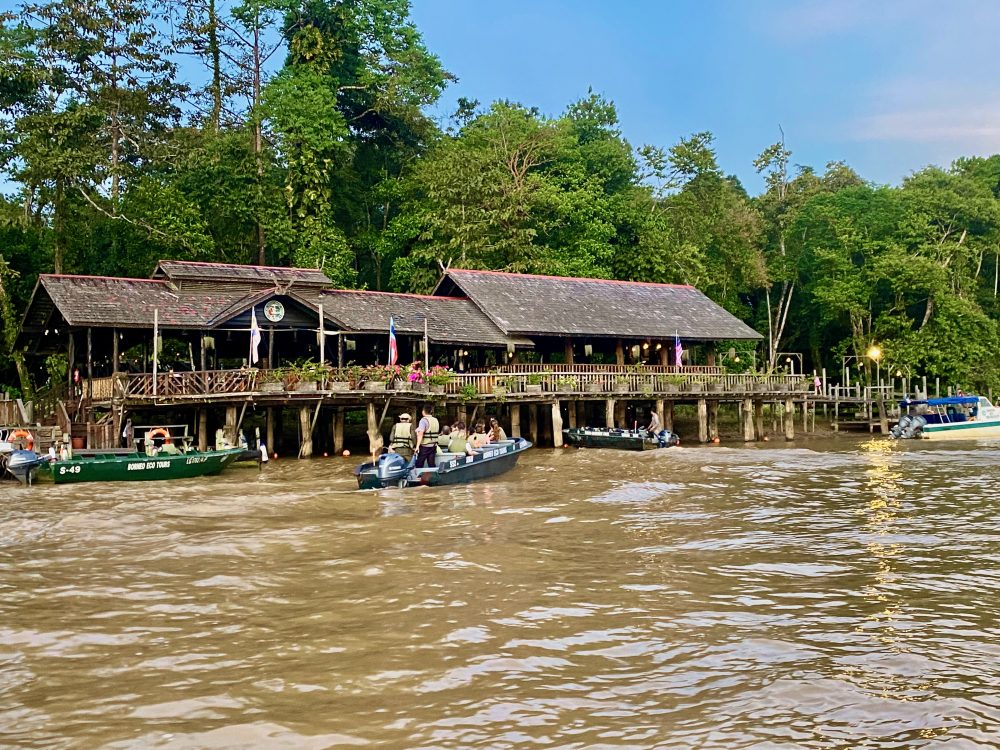
Other places to stay in Sabah, Borneo
Kinabatangan.
Along the Kinabatangan River are a few other lodges, which can be booked online without using a local tour company. I’ve listed a couple of suggestions below:
- Kinabatangan Wildlife Lodge (£50 per night)
- Borneo Natural Sukau Bilit Resort (£150 per night)
- Bilit Adventure Lodge (£252 per night)
- The Last Frontier Boutique Lodge (£308 for two nights, which is the minimum stay)
- Borneo Nature Lodge (£333 for a two day, 1 night package)
Back in Sandakan, a few suggestions include:
- The Elopura Hotel (£47 per night)
- Sabah Hotel (£48 per night)
- Hotel Sandakan (£16 per night)
We bookended our tour with a first night at the Elopura Hotel and a second night at the Sabah Hotel. The Elopura is located right in the heart of Sandakan Waterfront, so great for 1 or 2 nights if you want to experience a bit of local life. The room was great in Elopura and the hotel was heavily themed around movies, which was quite cool!
Sabah Hotel is located a little out of town, on a hill and a short taxi from restaurants etc. Sabah Hotel has a great pool area and lots of facilities, as well as several onsite restaurants, so I’d recommend staying here if you want a full day of relaxing.
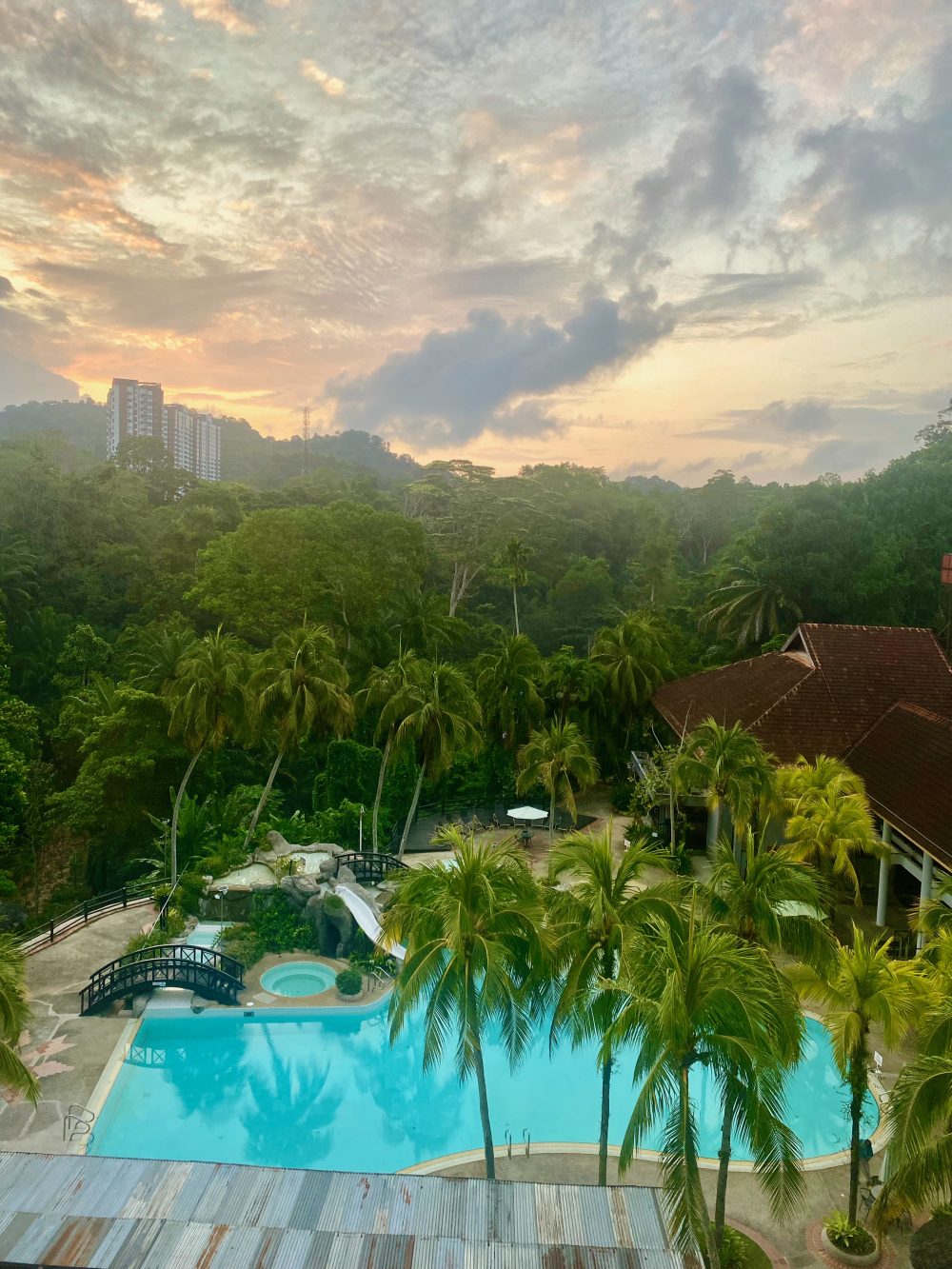
There are a lot of accommodation options in Sepilok, so perfect for exploring the various attractions here. Lots of the lodges and guesthouses are small and family run. A few options include:
- Sepilok Forest Edge Resort (£85 per night)
- Sepilok Jungle Resort (£30 per night)
- Nature Lodge Sepilok (£40 per night)
- Sepilok B&B (£27 per night)
- Paganakan Dii Tropical Retreat (£43 per night)
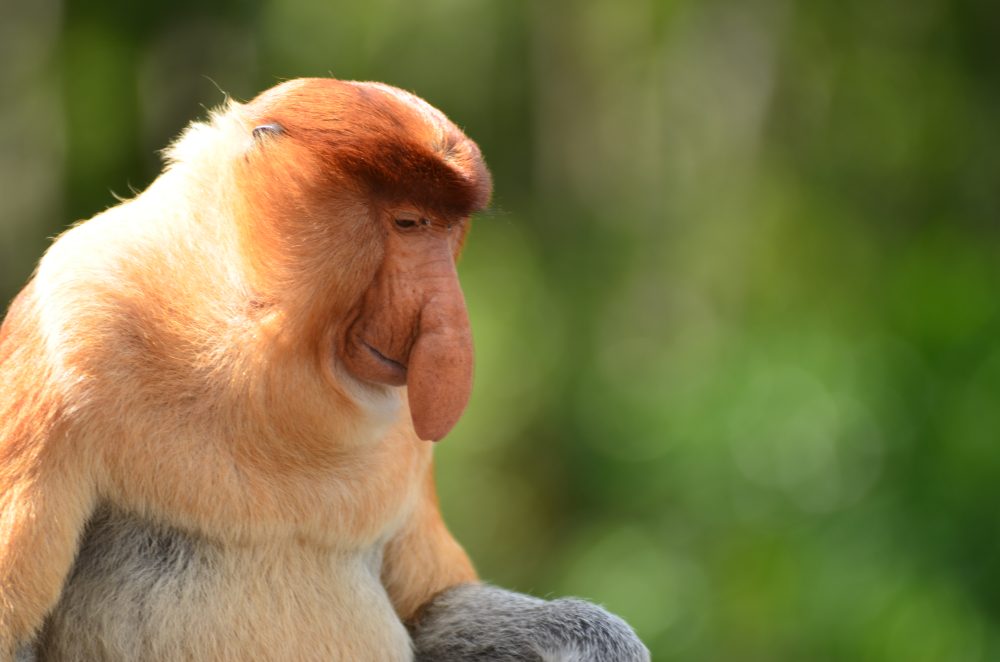
Where to See Orangutans in Borneo: A Guide
So, there’s my complete on where to see orangutans in Borneo. I really hope this blog post has helped in your research and planning for your trip to see the orangutans in the wild. It really is the most magical experience but does take a fair bit of planning to get there and to maximise your time.
As always, let me know if you have any questions.
If you’re planning a longer trip around Malaysia, or South East Asia, then make sure to check out my other posts here:
- Malaysia Travel Guide: The Best Places to Visit in Malaysia (including Borneo)
- Thailand Travel Guide: The Best Places to Visit in Thailand
- Vietnam Travel Guide: The Best Places to Visit in Vietnam
- Singapore Travel Guide: The Best Things to See and Do in Singapore
Disclaimer: This guide has no involvement from the local tourism board or a hotel .
Enjoyed my guide on where to find orangutans in Borneo? Pin it !
You may also enjoy:
China itinerary: the perfect two week …, review of bohol bee farm: the …, kitesurfing in boracay, philippines: the ultimate …, staying at the holiday inn mai …, leave a reply cancel reply.
Your email address will not be published. Required fields are marked *
Let’s connect

Best Place to See Orangutans in Sumatra 2024: Our Top Spots for Sumatran Jungle Trekking
The best place to see orangutans in Sumatra depends partly on your travel style, and majorly on how lucky you are! Although Bukit Lawang is the most famous spot for going in search of the beautiful red apes, there are many more places worth checking out on the edges of the sprawling Gunung Leuser National Park in the provinces of North Sumatra and Aceh.
Most people who travel to Sumatra come in search of the elusive and famous Sumatran orangutan. These impressive red apes inhabit the rainforests of Sumatra. They are truly some of the most amazing animals on the planet.
From remote villages to bustling tourist centres, there are a variety of options to choose from as you head out on a Sumatran orangutan trek.
Let’s take a look at some of the best places to see orangutans in Sumatra, learn a bit about our second-closest cousins, and find out how to be a responsible tourist when searching for them.
Thanks to our friend Callum Muir for the beautiful cover photo (shot during an ethical photography trek with Greenhill Guesthouse from a safe distance – with a great zoom lens!)
1. Bukit Lawang

Bukit Lawang is quite possibly the most famous tourist spot in Sumatra. It is the only place in the jungle where you are ALMOST guaranteed to see an orangutan.
Around a three-hour drive from Medan, the journey is straightforward. (Find out more in our detailed blog: How to Get to Bukit Lawang ).
Up until 2005, Bukit Lawang served as a “soft release” site for rescued orangutans. Those that had been rescued and rehabilitated were set free into the Gunung Leuser National Park and cared for by staff.
They were fed daily on feeding platforms, which tourists could visit to see the animals up close.
Many of these orangutans eventually dispersed, but a small number stayed close to humans and are semi-wild (as in living free, but still seeking out food from humans). It is these individuals that you are likely to see when you head out on a shorter trekking from Bukit Lawang.
Although it’s fantastic for tourists to be able to meet these incredible apes in their natural habitat, their behaviour is not so natural and there are a ton of associated problems.
It is illegal for guides (and visitors) to feed or interact with the animals. The good guides don’t, but there are many who do.
Why is this a problem? Because we are so closely related to orangutans, we can pass on a cold, a virus, or more serious health issues. In July 2018, a baby orangutan died ; the death was blamed on the close interaction with tourists.
One of Bukit Lawang’s semi-wild orangutans is infamous; Mina, one of the original released animals is a feisty girl with a long history of aggression towards humans.
Many of the guides are scared of her and for good reason; she sends both locals and tourists to the hospital with a bite at least once or twice a year!
Some guides use her aggressive behaviour as an excuse to feed her, saying that if they don’t, she will attack them. But our experience from trekking with truly knowledgable guides is that she learns which ones will give her nothing and leaves them alone, targeting the ones that do her bidding!
Bukit Lawang CAN be a fantastic place to view wild orangutans ethically. You can do this by choosing the right guiding company – find out how to do that in this blog all about Responsible Jungle Trekking in Bukit Lawang .
Go Jungle Trekking on the Outskirts of Bukit Lawang
Bear in mind that although many of the orangutans in Bukit Lawang are accustomed to humans (especially on the shorter treks and popular trails), there are some excellent guiding companies committed to taking guests off the beaten path and away from those main trails.
With the right guides/businesses, you can head just a little bit away from “central” Bukit Lawang and experience some untouched places and authentically wild orangutans.
The places/businesses below offer you a chance to experience truly untouched jungle away from the main Bukit Lawang trails (but still in the general area).
All three have guesthouses away from other settlements, so you can feel immersed in the rainforest. And all 3 are very eco-conscious and committed to conservation and caring for the environment and the community.
- Kuta Langis Ecolodge
- Simolap Wild Adventures
- Batu Kapal Guesthouse
Aside from the jungle trekking, Bukit Lawang is a busy village full of accommodations, restaurants, shops and bars. Most places have WiFi, there is Western and local food on offer, and you’re likely to meet many other travellers.
If Bukit Lawang doesn’t sound like your cup of tea, read on to learn about some other amazing places to see orangutans in Sumatra.
Looking for the best accommodation for your Sumatra trip? We recommend using booking.com – click below to find the perfect place for you.
2. Batu Katak

We have the inside scoop on a great little village on the edge of the Gunung Leuser, only around 30 minutes by car or motorbike from Bukit Lawang.
Batu Katak has none of Bukit Lawang’s hustle and bustle, restaurants, nightlife or development. What it does have is a charming, authentic village with a smattering of simple (but comfortable) guesthouses and an abundance of wildlife.
Spend a night or two here and go trekking, either into the karst forest – which is chock full of wildlife – or the national park.
Although orangutans are not guaranteed, you have a pretty good chance of seeing them. In fact, we’ve been to Batu Katak a number of times and seen wild orangutans every single time. It’s also prime habitat for the gorgeous Siamang gibbon and Sumatran tiger.
If you come at the right time, you can also see the world’s largest bloom – the Rafflesia – an amazing plant that is difficult to find anywhere else.
If you’re interested in spending time here to get a different perspective than Bukit Lawang , check out our Ultimate Guide to Batu Katak .
Visit Batu Katak With Us!
3. batu rong ring.

The virtually undiscovered village of Batu Rong Ring is another gem in North Sumatra. This is a very new tourist destination that is still growing, so it’s pristine and ripe for exploring.
Halfway between Bukit Lawang and Tangkahan in North Sumatra, there is very little tourist infrastructure. This is a true, authentic village and jungle. The local guides are dedicated to sustainably growing, protecting and promoting their slice of paradise.
You have a decent chance of seeing orangutans here, depending on your luck, as well as hornbills, gibbons, leaf monkeys and a range of other native wildlife.
There are some great caves to explore, along with waterfalls and untouched jungle.
Don’t expect souvenir shops, WiFi or Western-style restaurants: instead, prepare for some peaceful time amidst nature.
At present, there is only one provider that we know of offering accommodation in trekking in the rainforest near Batu Rong Ring.
Local Jasson and his wife Marta run the incredible Sumatra Jungle Huts. Head over to their Instagram profile to have a look and connect with them.
4. Tangkahan

Although not as famous as Bukit Lawang, Tangkahan has been a growing ecotourism destination in North Sumatra for the last 15 years. The big draw there are the elephants at the rescue centre; however, there’s a lot more to Tangkahan than just elephants.
Trekking here is a joy. Again, wild animals are unpredictable and we can’t guarantee that you’ll see anything at all! But if you’re lucky, you’ll see orangutans as well as a bunch of other fascinating creatures – from giant ants and monitor lizards to macaques and hornbills.
Your chances will increase if you visit during fruit season, which is around August-September.
This picturesque village is located beside a pristine river on the edge of the jungle. Accommodations range from simple budget guesthouses to private villas and even a new eco-glamping option!
There may not be WiFi, but there are super friendly locals, plenty of restaurants offering local and Western food, and views to die for.
For more information on Tangkahan, read our Insider’s Guide to Tangkahan .
Need a local Tangkahan guide to help you spot wild Sumatran orangutans? Email us for info and recommendations.
Visit Tangkahan With Us!

Ketambe also lies on the edge of the Gunung Leuser National Park, but is found further north than our other locations, in the southern region of the Aceh province.
It’s a bit of a hike from Medan; expect a good eight-hour journey by car or minibus. If you are heading there via bus, you will have to split your journey up into sections.
Because it’s so far from Medan, it might pay to include your trip to Ketambe with further exploration of Aceh.
Ketambe is a small, remote village with basic facilities. There are a handful of guesthouses to choose from. Most rooms will have a western toilet but don’t expect air conditioning or hot showers.
While we have yet to visit this pristine jungle village, we have heard nothing but great things about it and have some good friends working here as guides.
Some guides will tell you the chance of seeing a wild orangutan sits at around 90%. However, this is a rather bold claim and we’d hate to disappoint, so take your expectations down a notch and let’s say there’s a 50-60 % chance of bumping into a red ape if you are doing a single-day trek.
Like all the orangutan trekking spots — barring Bukit Lawang — the orangutans are never fed and will not approach humans. However, they are quite used to seeing people so won’t hide in the tree tops, giving you a good chance to observe them in their exquisite natural habitat.
Remember, the longer your trek, the higher the chances get. My friend who is based in Ketambe estimates around an 80% chance if you are on a two-day or longer trek.
For more information on how to get to Ketambe from either Medan or Banda Aceh, pop across and visit our friends at Sumatra Jungle. You can also find info on where to stay and book a trek with jungle guide Safar.

Kedah is situated in the Aceh province, not so far from Ketambe. Lying at the northern border of the GLNP, this a remote area and a great place to go in search of the red ape. You may also see gibbons, hornbills and a host of other amazing flora and fauna.
Kedah is around three hours north of Ketambe.
This is another place we have yet to head to, so can’t give personal recommendations as yet. Latest intel suggests that there is still only one guesthouse in Kedah, Rainforest Lodge , run by a lovely local fellow named Mr Jali.
About one hour’s hike from the village, the lodge provides basic rooms, and food, and will hook you up with a trek to suit you.
Reviewers rave about the lack of tourists, the abundance of wildlife, and the authentic kindness and experience shown by Mr Jali and his team.
From the sounds of it, there is a regular population of orangutans living only a short distance from the guesthouse and the chances of running into one are high.

Sumatran Orangutan Facts

- Orangutans share 97 percent of the same DNA as humans and are our second closest relatives after chimpanzees.
- Mostly solitary, males and females come together to mate and hang out, then go their separate ways. Mums raise the babies on their own.
- Orangutans are exceptionally strong — about seven times as strong as humans.
- They live entirely in the trees and it is unnatural for them to come to the ground.
- While Sumatran orangutans eat only leaves, vines, bark, flowers, fruit and insects, Bornean orangutans have been known to chow down on other primates: namely, the Slow Loris.
- When it’s time to sleep, orangutans build giant, comfy nests high up in the trees. They often have separate nests for day and night time. Some even get fancy and add roofs and umbrellas.
- Male orangutans can weight up to 120 kilograms, while females are about half the size at 45kgs.
- Bornean and Sumatran orangutans are different species with different characteristics. Sumatran orangutans are brighter orange with a narrower face. The boys have longer goatees and often slightly smaller cheek pads.
Sumatran Orangutan Sanctuaries

Currently, there are no places in Sumatra where you can get up and close with orangutans in a “sanctuary” setting – thankfully.
Any place that allows the public to get close enough to a wild animal to handle it is not a true sanctuary.
The Sumatran Orangutan Conservation Programme is a fantastic organisation that operates a rescue and rehabilitation quarantine centre just out of Medan. Here, they have dozens of orphaned baby orangutans.
Although it is not open to the public, Carly has had the privilege of visiting and working at this centre several times in her previous role as a great ape keeper.
They do an amazing job and are constantly overloaded by orphans coming in. These infants are taught how to survive in the jungle and will eventually be released back into protected areas away from villages and tourists.
Because humans can easily pass on illnesses and diseases to these endangered primates, the centre does not permit visitors. They also require minimal human contact to avoid them becoming overly conditioned to people. Fear of humans is an essential skill to help them survive in the wild.
The SOCP has also recently opened the Orangutan Haven .
This amazing facility provides a permanent, comfortable home for the adult orangutans who can’t be released into the wild for a variety of reasons (disabilities, sight impairments, infectious diseases etc).
Some parts of Orangutan Haven are open to visitors, but the areas where people can view the orangutans will not be open until later in 2024, as the beautiful individuals who have moved into these enclosures need time to adjust to life outside of cages.
Sumatran Orangutan Conservation

There are only an estimated 7,500 of this species left, making these gentle and reclusive apes critically endangered.
Sumatran orangutans (and their cousins in Borneo) have been pushed to the brink of extinction by the decimation of their habitat. This is mainly due to the epic scale of palm oil plantations throughout Sumatra, but rubber and other agriculture are also to blame.
The pet trade also plays a role, with baby orangutans sold and traded on the black market.
Orangutans only birth and raise one baby at a time (with the very rare exception). Baby stays with mum for at least five years, so it is difficult for this species to recover from rapid population drops.
There are many organisations working hard to save orangutans and their habitats, both within Sumatra and from further afield. To follow and support their work, check out some of our friends at these organisations:
- The Sumatran Orangutan Conservation Program
- The Orangutan Project
A Note on Responsible Ecotourism
Please always choose a responsible guide when you go in search of orangutans. Never encourage your guide to take you up close to these beautiful animals, as tempting as it may be.
Remember, you are in their home and you must respect them. Humans can pass on a multitude of illnesses to primates, some of which may prove to be fatal.
If you stop for a snack during your trek, take your rubbish with you; even if it’s organic. If you’ve been munching on some fruit and leave the skins or leftovers in the jungle “for the animals,” you may be leaving more than you bargained for in the way of germs and bacteria.
There’s nothing quite as spectacular as watching an orangutan gracefully and silently moving through the rainforest canopy from below. Keep your distance and appreciate these people of the forest as nature intended them to be.
FIND THIS BLOG HELPFUL?
We create all our content for free, to help travellers like you have the time of their lives in this amazing place. If you’d like to support us to keep creating Sumatra content, you can make a small, one-time donation at the secure link below. Terima kasih! (Thank you!)
Buy Me a Coffee
These blogs are awesome too - have a read!

How Much Does it Cost to Travel in Sumatra, Indonesia?

Sumatra Travel Tips: 11 Things to Know BEFORE You Go

Sumatra Indonesia Tourist Visa 2024 – What You Need to Know

Batu Katak: The Epic Guide to North Sumatra’s Hidden Gem 2024
This post has 5 comments.
Pingback: North Sumatra: Jungle Trek, Wild Orangutans & How To Get To Bukit Lawang
Pingback: Tangkahan - The Epic Guide to Sumatran Jungle Paradise | We are Sumatra
Pingback: The Ultimate Guide to Travelling Sumatra | We are Sumatra
Pingback: We are Sumatra | The Epic, Ultimate Guide to Visiting Tangkahan, Sumatra
Pingback: Saving Sun Bears in Sumatra | We are Sumatra
Share your thoughts with us Cancel reply
Our site is a work of love and will always be in progress. Sumatra is an enormous island and we haven’t even come close to scratching the surface, but we are determined to delve deep and keep learning, growing and exploring.
This blog is Copyright © 2024 by Exploring Sumatra. All rights reserved.
Want to know when we post new blogs?
Don't miss out subscribe now.


The Top 5 National Parks For Seeing Wild Orangutans
Where can you see orangutans in the wild, orangutans in the wild are a wonder to behold..
While you may have been to your local zoo to see orangutans playing on a rope course, seeing them in the wild in Indonesia is something really special. There are two species of orangutans in the world, and you can find both in Southeast Asia. Bornean orangutans live on the island of Borneo and their slightly longer-haired, paler cousins, the Sumatran Orangutan, on the island of Sumatra.
There are a variety of tours, national parks and rehabilitation and conservation centres that will get you closer to this remarkable species in Borneo. Here are our favourite places to spot orangutans in the wild, without interrupting their way of life.

Image: Mother and baby orangutans crossing river, Borneo in Indonesia
But wait something to consider before you choose your, orangutan destination….
As orangutan numbers decrease more and more, it’s important to choose an experience that doesn’t cause harm.
Making sure you’re a part of a legitimate ecotourism experience means that not only will you get to experience nature and culture with little environmental impact, but your local guide will teach and engage you in discussions about the local environmental issues. In Borneo, orangutans have been declared critically endangered – and their numbers are shrinking faster than we can save them.
We’ve recommended these five national parks because they all provide fantastic options to explore the natural home of the Bornean orangutan, without upsetting their remaining habitat.
How to steer clear of harmful tourist traps
There are places in South East Asia where you can get up close and personal to orangutans without stepping foot in the jungle. While some are legitimate rehabilitation centres, others are posing as sanctuaries where the orangutans have been illegally traded or hunted. Some ways to spot them are:
- The use of leashes or cages
- Visitors feeding or touching the animals
- Trainers being rough with the animals
- The animals being prompted to do tricks
- Animals who look unhappy, mistreated or frantic
The Top 5 National Parks To See Wild Orangutans
In indonesia.
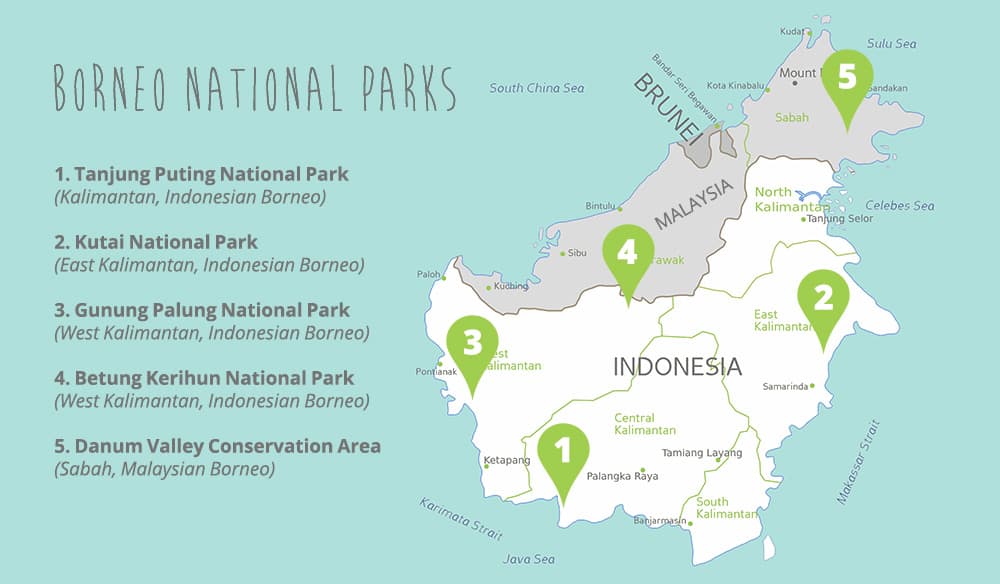
Image: Map of top 5 national parks to see orangutans in Borneo
Tanjung puting national park, central kalimantan, indonesian borneo.
Tanjung Puting National Park has been called one of the natural wonders of the world. A vast and dense rainforest that spans over four thousand square kilometres, Tanjung Puting is full of wild orangutans who love the tree tops and swampy mangroves. The best way to get a great view of wild orangutans is to travel down the Sekonyer River on a Klotok. A Klotok is a type of river houseboat, used by locals to transport goods up and down the river, and also by tourists as a great way to get around.
The easiest way to get to Tanjung Putting National Park is via Klotok. It’s a good idea to make sure your tour booking includes or can arrange an airport or hotel transfer, as well as transport to and from the park. Between travelling on a Klotok, bonding with a local tour guide and spotting the elusive Bornean orangutan throughout your trip, Tanjung Puting National Park has it all.
The best part? Tanjung Puting is also home to the well-known research facility Camp Leaky , where you can meet wildlife researchers, get up close with orangutans in rehabilitation and other creatures of the jungle.
Make your way through Tanjung Puting with us, at Orangutan Trekking Tours . Our ecotours help the Green Team buy back areas of the forest to protect them from illegal palm oil farmers and poachers, and they’re a fantastic way to explore the rainforest and all its inhabitants.
Image: Arbain, OTT leader following an orangutan in Tanjung Puting NP
Kutai national park, east kalimantan, indonesian borneo.
Kutai National Park is located in East Kalimantan on Indonesian Borneo and is home to around two thousand orangutans. Unfortunately, a large part of this forest has been devastated by deforestation and fires in the past , which has left only 30% of the original forest behind. This means that the forest is no longer the green wonderland it was, but it is on its way to recovery and still worth a visit.
There are two main access points for tourists to the park. Along the road between Sangatta and Bontang you’ll find Sangkima, with a number of old national park buildings still standing. It provides fantastic photo opportunities of the orangutans, otters and monitors lizards from the easily accessible loop platform. Sangkima has a walking trail and boardwalk that will take you to one of the largest trees of the forest. This area, due to its easy accessibility, is under growing pressure from tourism.
Prevab is a more remote section of the park that was preserved, and the forest here is in fairly good condition. It is accessed via a 25 minute boat ride on the Sangatta river . It’s here that you will be able to see orangutans as well as an array of exotic flora and fauna, such as sun bears, flat-headed cat and long-tailed macaque. Trekking through the Kutai National Park requires both a permit and a local guide .

Image: Trekkers on a boardwalk in Kutai NP
Gunung palung national park , west kalimantan, indonesian borneo.
Gunung Palung National Park is estimated to be home to around two thousand orangutans The forest in Gunung Palung National Park is quite dense and less visited by tourists, which has helped the growth and protection of its diverse habitats, including mangroves, swamps and lowland forests. The park was given official National Park status in 1990, but it has a history of mismanagement. Until recently, tourism to this area was taken away from the control of the locals and exploited by a company who made travelling to this area far more expensive than it should be. Luckily, this struggle is beginning to end and tours operated by local villagers are now taking place again.
One of the unique things about tours through Gunung Palung National Park is the absence of the tourism industry. There are no real pathways or roads, and the primary place of accommodation is camp Lubuk Baji, a wooden building that sits on stilts and has been likened to a tree house . The orangutans that call Gunung Palung home aren’t used to seeing people, which makes the furry apes of this park wilder and harder to find. But this means it’s twice as rewarding when you do see them swinging through the trees!
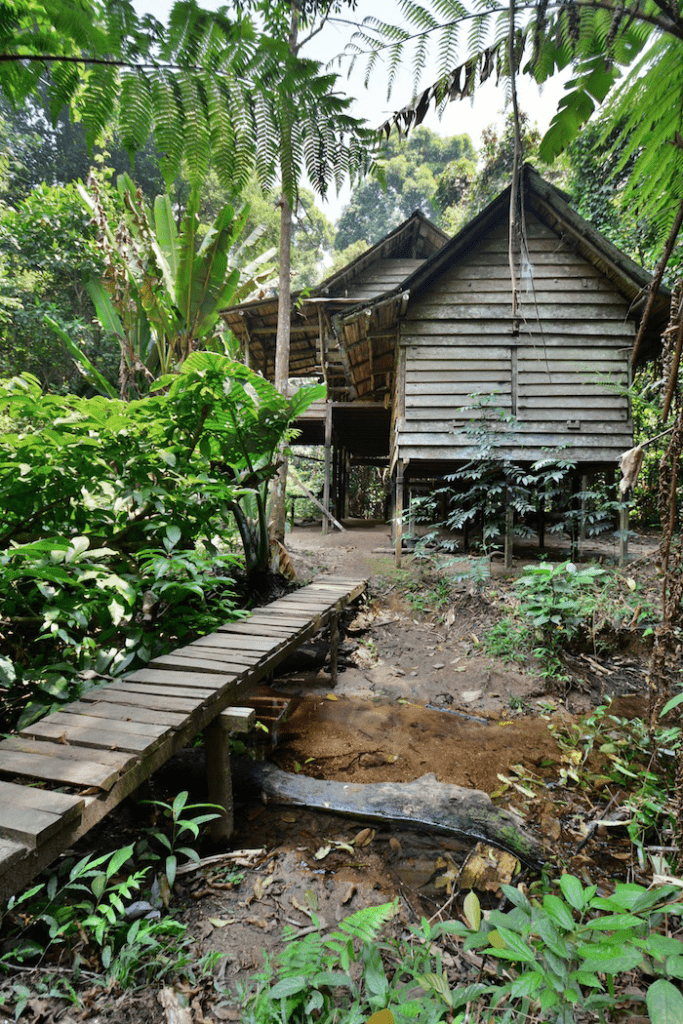
Image: Lubuk Baji Camp, West Kalimantan, Indonesian Borneo Credit: Leave Your Daily Hell
Betung kerihun national park, west kalimantan, indonesian borneo.
Betung Kerihun National Park runs along the Malaysian Borneo border, Sarawak. It has four main waterways that run through from the other side of the border. Throughout the park are small villages of locals, some only accessible by long boat. The locals live in houses suspended on the river banks above potential flood levels, called ‘Long Houses’. The tours through Betung Kerihun National Park are primarily run by the Nanga Potan people who supply long boats, insight into their culture and opportunities to see wild orangutans in this region. It is a key area for conservation in Indonesia.
A great way to experience this part of Borneo is by bike. Between some of the villages, there are narrow pathways which can take either motorcycles or bicycles. While this experience is seasonal, it provides a great ground-floor view of the forest, and a bit of a workout for the willing tourist. Bornean Orangutans are not afraid to come down from the trees, and you might just have a face-to-face encounter with one of these amazing creatures as you cycle through the forest.
GIF: Orangutan Rowing Longboat at Camp Leaky, Borneo
Danum valley conservation area, sabah, malaysian borneo.
This park is technically not in Indonesian Borneo, but we’re giving it a special mention due to its eco-friendly, conservationist ethics.
Located on the Malaysian side of Borneo Danum Valley Conservation Area , this is the most accessible of the National Parks that we’ve mentioned. There are many walking trails through the park, including a suspended walkway. A popular choice for accommodation is the Borneo Rainforest Lodge which sits alongside the Danum River. There is no roughing it here, with premium accommodation, including optional spa packages, so you can see the rainforest in style.
There are a couple of wild orangutans who call the surrounding trees home , although it is not guaranteed; you may not have to leave the lodge to see wild orangutans here. The lodge has strict guidelines for guests when leaving . These are put in place to minimise tourism’s effect on the surrounding forest and wildlife and are common among eco-tourism accommodation providers.
So, how can you help?
Do your research and choose travel and tour companies that promote true eco-tourism. Avoid places that fit the description of a harmful tourist trap and avoid contributing to the ongoing struggle of this ecologically diverse island. Follow the rules set out by lodges and tour guides.
Your eco-conscious travel will help support the local people who are working to make a difference, and not just financially. By talking and sharing images with the locals who run these tours, we generate the right kind of conversation about the endangered Bornean orangutan.

Image: Rules Sign at Camp Leaky, Kalimantan, Indonesia Borneo
We would love to explore tanjung puting national park.
Orangutan Trekking Tours have plenty of options for rekking through the Bornean rainforest, and you can check them out here .
If you have any questions about our treks, let’s chat! Get in touch with us.
Share This Story, Choose Your Platform!
Related posts.
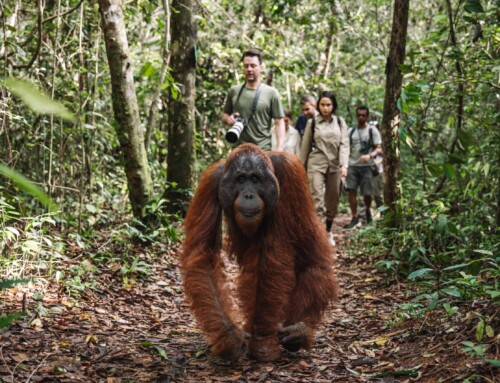
5 days in the jungle
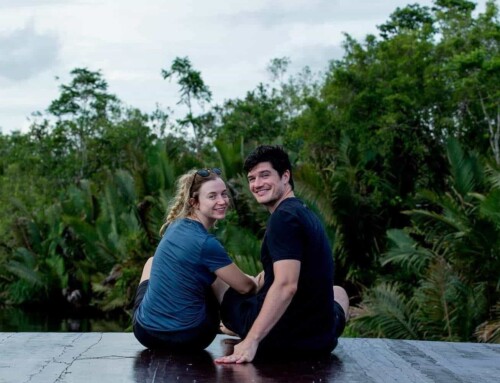
Why Borneo Should Be on Your Bucket List for Wildlife Adventures
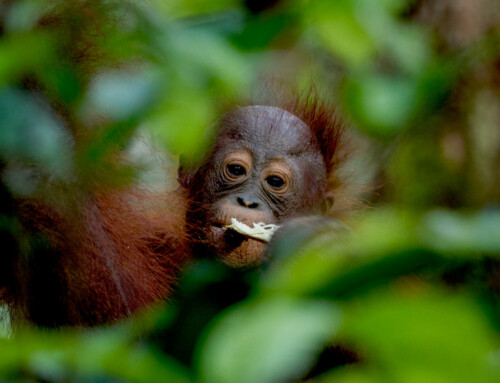
Can COVID19 affect Orangutans?
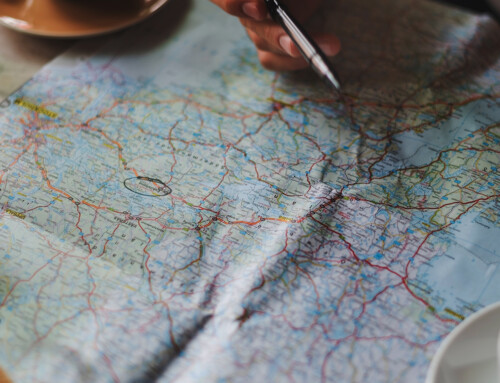
Here’s Why We’ve Got One of the Best Photography Tours in the World
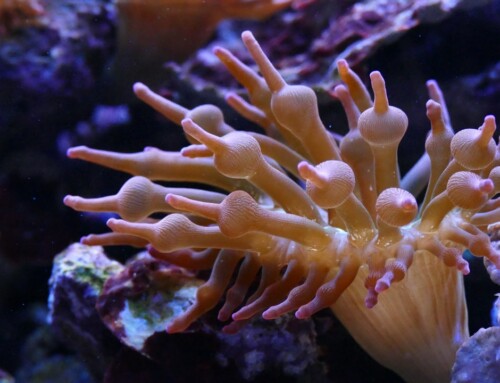
7 Unique Holiday Ideas for the Conscious Traveller
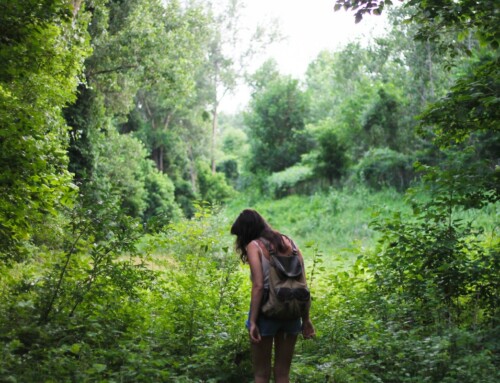
Oceans and Orangutans: Backpacking in Borneo

How to See Orangutans in Borneo Independently
- January 27, 2024
- Last updated: February 4, 2024
- Asia , Destinations , Responsible Travel , Wildlife
Home » Travel Blog » How to See Orangutans in Borneo Independently
If you choose to travel to Malaysia , you might want to put a ‘see orangutans in Borneo’ note on the top of your itinerary. And if you are a traveller who counts each penny and you expect it’s going to be a cheap deal in Borneo, as in many other Southeast Asia countries, then you might be shocked by the prices you’ll find here to pay for activities that include seeing orangutans.
To get a better picture, a basic 2-day, 1-night package booked through a travel agency will usually include a visit to the Sepilok Orangutan Rehabilitation Center, the drive to Sukau (where you stay overnight, the start of a river cruise or a jungle trek), a 3-hour boat trip on the Kinabatangan River in the early afternoon and one later in the evening.
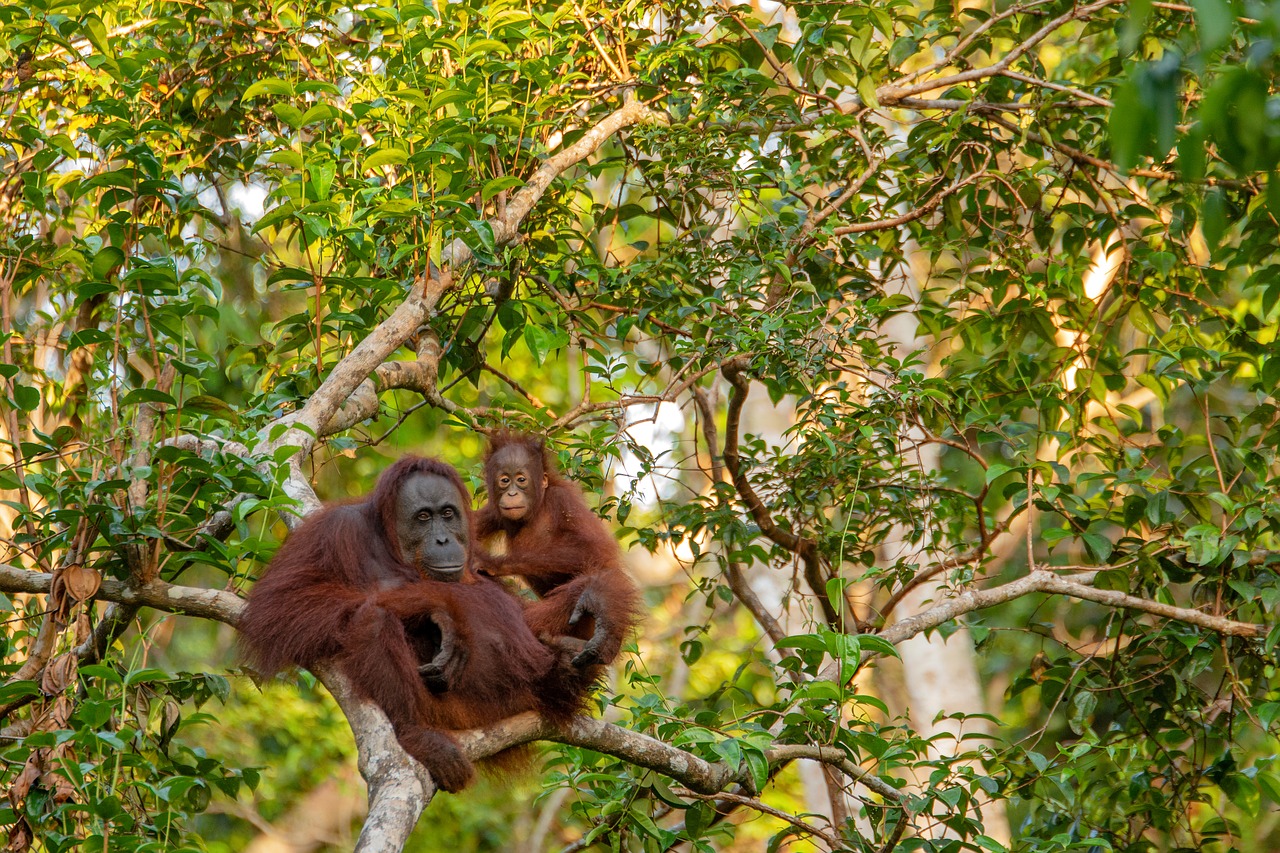
The next day you go for another 2.5-hour boat trip on the way back to Sandakan. Add some meals during the trip and you’ll pay MYR 1092/$343 per person (excluding the entrance fee (MYR 30/$9) and a camera fee (MYR 10/$3) at Sepilok).
Now if there are two of you and you’d pay double, i.e. $686, that would be one flight ticket from Asia to Europe, or three months rent in Chiang Mai in Thailand . And that’s only one full day of activities, if you imagine that you need only about 6 hours for the transfer to and from each place.
See orangutans in Borneo independently and save money
But what if we told you that you could spend less than one third per person when you do all of those activities independently? Absolutely! You can see wild orangutans by yourself and go for a river cruise in Kinabatangan without booking overpriced tours. How can you do it? The short answer: use local transportation, buy your own food and privately contact a lodge where you want to stay overnight.
So, how much are you going to spend in total if you decide to see orangutans in Borneo and wildlife along the Kinabatangan River independently?
Join some of the tours in Borneo:
- Borneo Full Day Try Dive (2 Dives) for Beginners
- Full-Day Snorkeling Adventure from Kota Kinabalu
- Borneo 3-Dive Scuba Diving Day Trip in Kota Kinabalu
This is what we spent:
Transport Sandakan-Sepilok-Sandakan: MYR 10/$3 Entrance to Sepilok: MYR 30/$9 Camera fee: MYR 10/$3 Transport Sandakan-Sukau-Sandakan: MYR 80/$25 One river cruise: MYR 50 /$16 Morning Jungle Trekking: MYR 15/$4.70 Twin bed room: MYR 75/$23 Our own food: MYR 26/$8
Total: MYR 296/$93/per person Saved: MYR 796/$184/per person
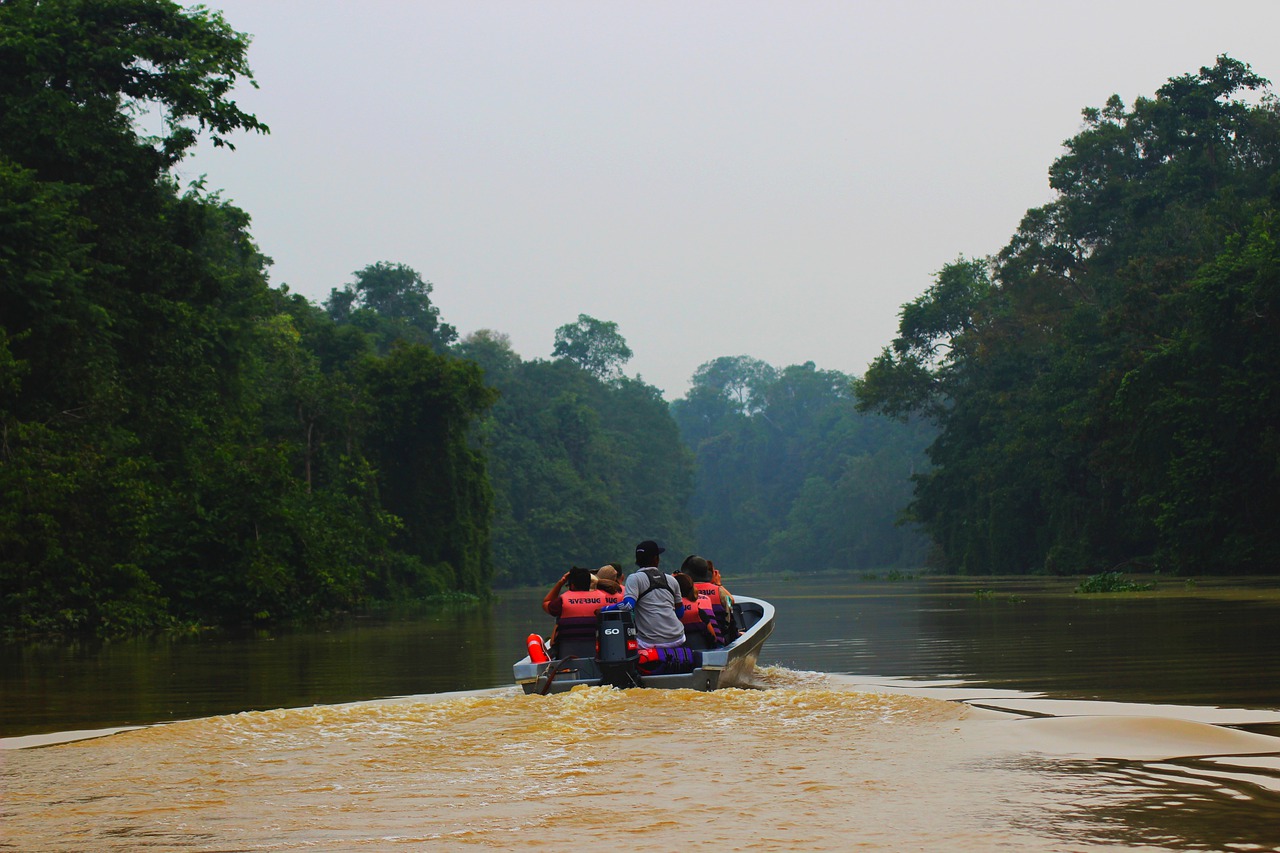
We went only for one river cruise since we had been already on a day cruise in Kota Kinabalu , where we also did a short night cruise to see fireflies. Honestly, once you do a two-hour river cruise during the day, you’ll see enough to be satisfied with your trip to the Kinabatangan River. And even if you like to observe wildlife near the river and you decide to pay for an extra cruise, you’ll only add MYR 50/$11 for a day cruise and MYR 60/$14 for a night one.
In case you are not interested in visiting Sepilok Orangutan Sanctuary near Sandakan, which we recommend visiting anyway, you can do a 2-day, 1-night trip to Sukau, go for two river cruises (day and night) or one river cruise and one jungle trek. If you do it independently, you’ll pay MYR 246/$77.
If you still need more comfort when organizing a day in the wild for yourself, another option that is cheaper than a tour operator, but still more expensive if you go your own way is to arrange a tour at your guesthouse in Sandakan.
The one we stayed in offered a 2D1N trip to Sukau (without Sepilok Orangutan Sanctuary) for MYR 360/$113/pax.
Some travel agencies go really high with the prices and you can pay for a one-day trip to Sepilok Center and an hour-long boat trip on Kinabatangan in average MYR 792/$248.
In case you would like to book a 3-day, 2-night trip, get ready to put MYR 1,522/ $ 478 on the table.
Join one of the local tours in Malaysia:
- Private Guided Island Tour of Langkawi
- Langkawi UNESCO Global Geopark Mangrove Cruise
- From Kuala Lumpur: Cameron Highlands Private Full Day Tour
- Best of Kuala Lumpur Tour with Petronas Towers & Batu Caves
- Kuala Lumpur Food Tour: 10 Tastings
How to get to Sepilok from Kota Kinabalu
Although tour operators encourage their clients to take a flight from Kota Kinabalu to Sandakan where they pick you up, to travel by bus is a good option, too. It’s very comfortable with A/C, and much cheaper. Plus, planet Earth will say a big “thank you!” for travelling overland. You will need to take a bus from Kota Kinabalu (bus station on Jalan Padang street near hotel Shangri-la) to the long-distance bus terminal in Inanam.
A one-way ticket costs MYR 1.50/$0.47 and it takes about 15 minutes to get to Inanam. Local buses in Asia depart when they are full, so be ready to wait 20 minutes for a bus.
From Inanam bus terminal you’ll take a bus to Sandakan. The route costs MYR 43/$13.50 and takes about six hours. In case you are prone to motion sickness, get your pill ready. You’ll need it.
From Sandakan, you’ll take the bus #14 from the main Bus Terminal in front of Nak Hotel. The ticket costs MYR 5/$1.16 and it takes about an hour to arrive at the Sepilok Orangutan Rehabilition Center. The last bus from the sanctuary back to Sandakan leaves at 4pm, so make sure you catch it.
The center is open daily from 9am-12pm & 2pm-4pm. On Friday it’s open from 9am-11am & 2pm-4pm.
Plan your trip to Asia:
- Free Things to Do in Singapore: Tips From A Frequent Visitor
- Where to Stay in Singapore: The Ultimate Guide
- 8 Things To Do in Kuala Lumpur
- Things to do in Penang, Malaysia: a List of Highlights For Your Island Trip
- Things to Do In Koh Lanta, Thailand: Ultimate Guide
- Bangkok Tips: How to Survive Your First Time In the Capital of Thailand
- Where to Stay in Bangkok: The Best Hotels and Neighborhoods
How to get to Sukau from Sandakan
Take a local bus from Genting Mas Supermarket on the Jalan Pryer street. A one-way ticket costs MYR 30/$7, the drive takes about 2.5-3 hours and buses to Sukau leave between 10 am and noon. If you are lucky enough as we were, you can ask at your guesthouse that organizes a tour to Sukau if you can pay only for the lift. .
What to expect from Sepilok Orangutan Center
In Sepilok Orangutan Rehabilitation Center they rehabilitate and train about 60-80 orphaned orangutans to survive in the wild, nature and they releasinge them once they are independent enough.
The sanctuary is located within a rainforest of 10,610 acres and you can explore part of it by having a walk on nature trails within the reserve. Apart from semi-wild orangutans, you can also see nocturnal animals here if you go for a night-guided walk. Walks and trails vary from 250 m up to 5 km. The only downside is that they close at 2 pm, so in case you want to come for the afternoon feeding and do a bit of trekking in the forest or canopy walking, arrive far enough in advance.
To make sure you see the orangutans here in Sepilok, we recommend coming for the feeding time that is twice per day, at 10 am and 3 pm, without relying on seeing them in the jungle. We chose the afternoon feeding session and it was a good decision, because there were only a few people around.
The whole procedure of feeding is quite exciting, when you see orangutans arriving shortly before the clock strikes three. Rangers come with baskets full of bananas and sugar cane and the feast begins. The orangutans eat and hang around on the mangrove trees for about 20 minutes, and then they start to disappear slowly in the forest.
You might ask if it’s always guaranteed to see these ‘men of the forest’ at feeding time and we can only mention a remark of a ranger who works there and who said there he had been working there for 20 years, and it never happened that they (the orangutans) hadn’t come for at least five minutes to take some food.
During our visit to Sepilok, we saw five adults and one baby orangutan plus a few macaques that arrived to pick some leftovers.
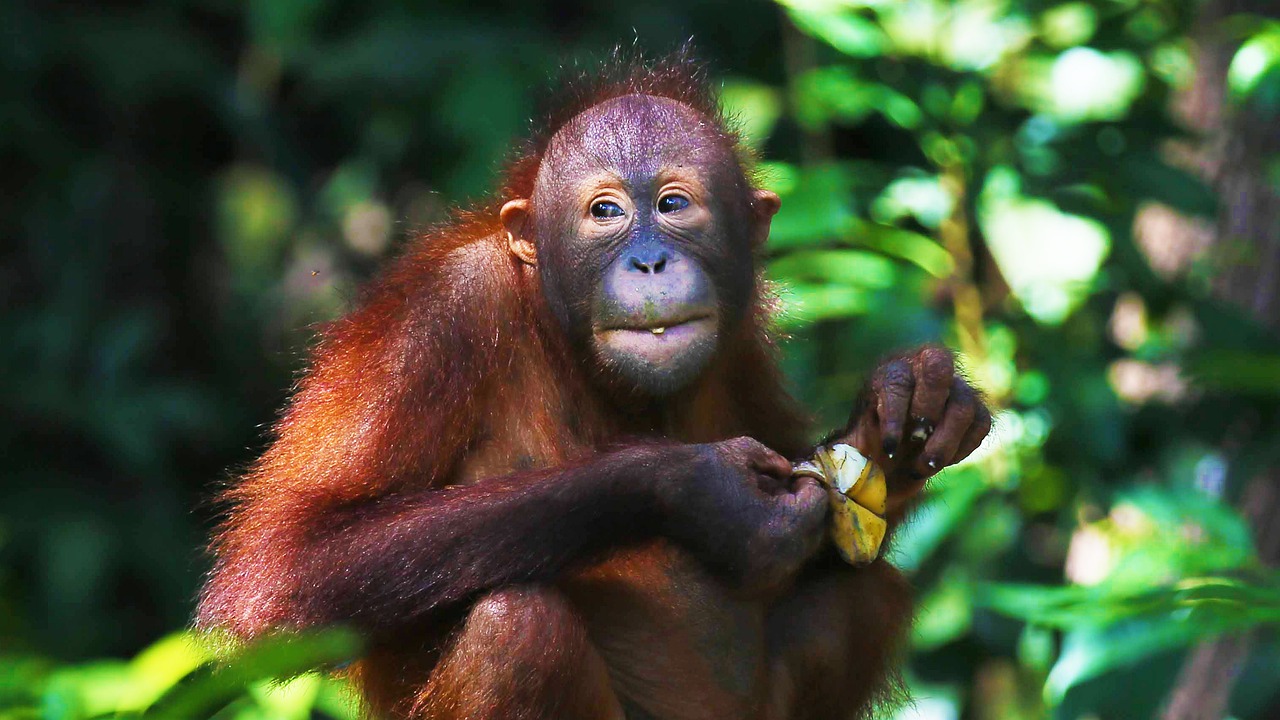
We were also extremely lucky to meet a ranger with two young ‘lady orangutans’ that he was walking with on the path in the forest. We basically saw them face-to-face, that is, when they weren’t hiding behind the ranger.
When you decide to take a river cruise on the Kinabatangan River, you’ll see the proboscis monkeys, red-leaf monkeys, lots of hornbills and a crocodile or two. For those of you who have never seen a crocodile in reallife , we suggest sitting in the middle of the boat, not on the edge, so you don’t panic if you spot him just 2 m away from you.
Happiness is always a coincidence
When we went to Sukau, our big wish was to see a wild elephant near the river. The staff at our guesthouse told us it’s not the season to spot them and we believed them, although a friend of our friends saw them in lower Kinabatangan a few days before us.
Anyway, the alarming situation with deforestation in Borneo also plays its role and we truly wish it does not end up in a total disaster for the animals and their habitat. So, the fact that you encounter an elephant on the Kinabatangan in the future will be a sign the situation is stable or improving.
We didn’t see wild elephants in Sukau, but we went for an early morning guided trek and came back with a big smile on our faces and an exciting feeling in our hearts, which were beating fast. We had just seen a wild male orangutan only a few meters from the path we were walking on. Apparently we were not very welcome in his territory as he started to throw a huge 2 m-long log from above the tree on us, but we learnt a lot about their behavior and habitat that day.
Muse, our guide, confirmed we were extremely lucky to see a wild orangutan so close to the road and we could be only grateful for that precious moment.
What to bring with you f or a river cruise:
• sunglasses • sunscreen • mosquito repellent (especially for the late afternoon and night cruise) • a hat
For jungle trekking:
• leech repellent or special socks • outfit in natural colours. Leave your bright red pants or shiny, blue t-shirt at home. You don’t want to make an enemy in the wild jungle, right? • comfortable, sturdy shoes (although it’s possible to run up and down the hill with flip-flops, as our guide did).
For both trips, take a bottle of water with you and a binocular, in case you travel with one. Otherwise the guides on river cruises provide a couple of them for the tourists, too.
Pack & travel:
- The Best Carry On Travel Backpack: A Practical Guide
- Best Hiking Backpack: A Practical Guide
- Best Backpacking Tent: The Ultimate Guide
- Best Camera for Travel Photography
- Best Camera Lenses for Travel Photography: Tips For Your Next Trip
- Best Rain Jacket for Any Travel Needs
- Best Walking Shoes for Men: Top Picks
- Best Walking Shoes For Women
Where to stay in Borneo
Before your arrival to Borneo, check out and book accommodation in Kota Kinabalu.
In Sandakan, we recommend to stay at the Rose Guesthouse and in Sukau you might like to check Sukau Backpackers B&B .
Safe travels and good luck with seeing orangutans in Borneo in the wild!
Like it? Pin it!
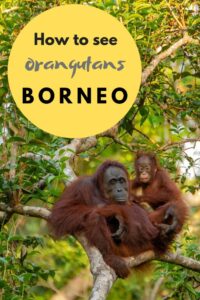
Ivana Greslikova
- Published: January 27, 2024
You may also like...
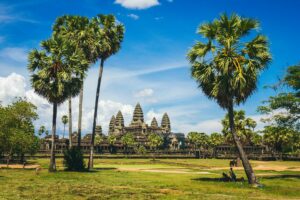
The Ultimate Asia Bucket List
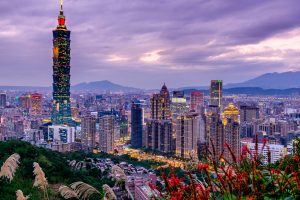
Things to Do in Taipei, Taiwan: Tips on Attractions, Food and Best Hotels
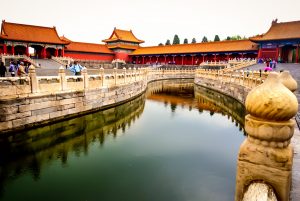
10 Things To Do in Beijing, China
38 thoughts on “how to see orangutans in borneo independently”.
What incredible experience! I love orangutans like every other animals and everything that involves watching them and learning about them can only make me happy. It’s incredible that they rehabilitate and train orphaned orangutans to survive in the wild, such a good cause, thanks for sharing 🙂
Thank you for reading, Franca. Yes, definitely, they do a good job at the Sepilok and I wish we could spent more time there 🙂
Wonderful post and photos Ivana and Gianni. A few years ago, I saw orangutans in Sumatra, but would love to visit Borneo too – looks beautiful.
Thanks for reading, Mark. We’ve heard great things about wildlife in Sumatra, too. Yes, Borneo is indeed a wonderful place for ecotourism, hope you can make it there one day. ps: and once you are in Kota Kinabalu, you will love this city. Durian is at each corner there 🙂
I love to travel independently and to see wildlife (it might be great for others to join a tour, I won’t judge them at all). So glad I found your article, so far I always wondered whether I would be able to see the Orangutans in Borneo without joining a tour group. I read an article (somewhere) that palm oil use is responsible for large-scale deforestation. Ever since I heard about it I check product labels for palm oil and search for alternatives. There is an awful lot of products containing palm oil. Thanks for the lovely post, I want to go there straight away. Safe travels 🙂
Hi Dorothée, thanks for commenting. Yes, palm oil plantations are a big threat for Borneo, as we could witness ourselves. Luckily a few NGOs have started to take action there. Have a good time on the road also yourself 🙂
Good information. I’ve had Sabah on my list for a long time and we’ll eventually get there. A bit shocking about the prices but I would do like you and go independently – with our new life on the road our motto is slow travel and you just save so much money by not having to take flights or take expensive tours. Did you notice a huge difference in lodging/food expenses on Borneo vs the mainland? Hey, look forward to seeing you guys in Prague! Let us know when you’re arriving so we can schedule something. Frank (bbqboy)
Hi Frank, sure, slow travel mode is a wonderful way to explore the world. We cannot really compare the prices with the mainland, since we travelled only to Kota Kinabalu, Sandakan and Sukau, but we noticed it’s definitely pricey compared to Thailand, let’s say. Check our post about Kota Kinabalu so you can get an idea about different standards you’ll pay for in KK.
Definitely, we’ll stay in touch once we arrive to the Czech 😉
In Borneo is very easy to hitch-hike, so if you want to save much more money and have a lot of fun, this is perfect place, where to do so! Also you will dont need to pay accommodation, as they are very hospitable and will invite ou home. It is the same in Malaysian, Indonesian and Brunei part of the island. 😉
Cool, thanks for the tip, Hogy !
Wow! Ivana and Gianni, this is a great post and powerful photos. I’d love to see orangutans (and Borneo) from the perspective you have.
Thanks a lot, Maria. Hopefully you can experience Borneo and its marvels one day.
Hi, lovely post. Orangutans are definitely cutest, and I’d love to see them by myself. They always look so sad. Thank you for detailed guide….
Yes, Dejan- Bavaro, they are indeed sweet and so wise 🙂 Hope you’ll have a chance to encounter them one day in the wild or in a sanctuary.
Some activities are priceless :-). And how could you go to Borneo and not see the orangutans? (We saw them on a cruise as a day trip excursion)
Agree, the best way is to see them in their natural habitat 🙂
This sounds like a much better alternative than a package tour! I’m very jealous- I’d love to get to Borneo. Beautiful photos!
Thanks so much for reading and commenting, Katie! Yes, the choice to go independently was indeed an amazing experience. And cheaper, too 🙂
Hey, found your post on Pinterest and enjoying reading your hints and tips. I’m planning a trip there and very interested to see the Kinbangan river. I have been told that Kota Kinbangan is where the tours pick up from. Do you think it is possible to arrive there by public bus in the morning and pick up a cruise for the same day? Thank you for your help and beautiful pictures!
Thanks for reaching us out! Maybe you mean Kinabatangan river? If yes, then you’ll need to travel to Sandakan town and from there you either take a local bus or book a tour at any guesthouse. Then there is Kota Kinabalu city, from where you can take a trip to Klias river, which is also cool as you will most probably get a chance to see the fireflies at night. You can read more about this here: https://nomadisbeautiful.com/travel-blogs/kota-kinabalu-a-city-of-seafood-beaches-and-durian/
Hope this helps 🙂 Happy travels!
This is great information and I have bookmarked the page. I was confused about how to do a Kinabatangan trip without insane prices. Thanks!
I can hear you, Laura! The prices for the tour packages are insane there, but it was really easy to do it independently. Happy travels!
Great and informative post, thanks for sharing! I was looking for something like this for our independent holiday this summer! Cheers, Dora
Glad to hear that, Dora! The prices for trips to Borneo, particularly those that include wildlife, might get very high, so we’re happy to help out independent travellers 🙂 Have fun!
Thanks for sharing, some wonderful photographs of these wonderful creatures, plus some useful tips. Hoping I’ll be seeing them or myself next month
Thank you, Iain, best of luck with your orangutan adventures then! We’ll be happy to hear how did it go 🙂
thats exact what i need. thanks for the tips. so you did jungle tracking and river tour during one day?
Hi Konstantinas,
We did the boat tour in the afternoon (straight after we got there) and jungle tracking in the morning after, but you can do both in one day. All depends what time you arrive there. Cheers!
Great post 🙂 Really helped us out. Just wondering about your transportation from Sandakan to Sukau and back. Did you get a private van or take a public mini bus? You paid 80 for 2 people for return trip … thats 20 ringgits, per person per way … what a deal! We were just quoted 50 per person per way in some kind of private van that takes 2.5 hours. Any help would be appreciated. Thanks!
Hi Jonathan, thanks for stopping by!
You might have missed out the part about transport, there is a whole paragraph in the article “How to get to Sukau from Sandakan”.
“Take a local bus from Genting Mas Supermarket on the Jalan Pryer street. A one-way ticket costs MYR 30/$7, the drive takes about 2.5-3 hours and buses to Sukau leave between 10 am and noon. If you are lucky enough as we were, you can ask at your guesthouse that organizes a tour to Sukau if you can pay only for the lift.”
So yes, we went with a private car from our guest house named Rose Guesthouse, the link of the place is at the end of the post in the section “Where to stay”.
Cheers and have a great time in Borneo! .
Are there many cheap lodging options in sukau? I’m worried abou tnot being able to find one if the backpacker hostel place you mentioned is booked….. Thanks!
Hi Sam, I’m afraid there aren’t many budget options in Sukau. At least they weren’t in 2014, when we visited the place. I’d suggest contacting them in advance and check the availability, so you don’t end up paying for a luxury bungalow. Cheers!
Hi Ivana, I’m heading to Sepilok in July and hope to travel to Sakau independently for 2 days/1 night. I understand the public bus takes 2-3 hours and arrives in the afternoon. Did you book onto a boat tour when you arrived or did you book it in advance? I’m worried that if I get there in the late afternoon I’ll miss all the cruises! Also, how do you suggest to return to Sandakan from Sakau as the only information I can find is a public bus leaving at 06.30am! Thank you in advance!
Hi Coral, We arranged the boat tour after we arrived to Sukau, directly at the Sukau Backpackers B’n’B. There was one boat trip in the afternoon, and one early in the morning. They might try to convince you to buy a full package and go for as many tours as possible, but pick just those activities that you want and pay for only for them, not for the whole package. We arrived in Sukau around noon, and there was a boat tour around 2pm or 4pm if I remember well… Regarding returning to Sukau, I am not sure whether there is another bus back to Sandakan, I’m sorry. We arranged the pick up with the owner of Rose Guesthouse in Sandakan I mentioned in the article. She basically brought us to Sukau from Sandakan by car, and picked us up to bring us to Sandakan. You might try to contact them, and ask if they still do such a thing if you book a room at their place. It’s very simple guest house, but OK for a night or two. Take care and enjoy Borneo!
Thank you so much for your reply, it is really appreciated!
Hello Ivana, Thank you for sharing your experiences with us. I’ll be visiting Borneo in July and hopefully spot an orangutan!
wow! what a long post! information here helps me to get the best information about Sepilok.
We did a very similar trip but spent a BIT more money. We did the sanctuary via minibus, but did an inclusive tri with the Sukau Backpacker’s B&B (where you also stayed). We customized it and didn’t include lunch/dinner which saved us some money. We had a crazy mosquito problem in the B&B cabin but otherwise it was a great experience – we even saw a tarsier at night! If anyone’s interested, we kept it under $60 per day for two people — check out our site for a breakdown.
Comments are closed.
SHARE WITH YOUR FRIENDS!
This post may contain affiliate links. Please visit our Privacy Policy for more info.
Useful links
AFFILIATE DISCLOSURE
Nomad is Beautiful is a participant in the Amazon Services LLC Associates Program, an affiliate advertising program designed to provide a means for us to earn fees by linking to Amazon.com and affiliated sites.
2024 © All rights reserved - Nomad Is Beautiful
Web by Nimble.help (EN) | (SK) | Graphic design & Logo: Gabriela Holcer
- Travel Guides Plan your adventure
- Destinations Our favourite places
- Tours Book a trip
- Travel Companies Independent specialists
- Travel Guides
- Destinations
- Travel Companies
The Best Time To See Orangutans in Borneo
When to see orangutans in borneo and sumatra.
Tamara Thiessen
- In this guide
- Indonesian Borneo
- Events & festivals
Quick guide: Best times to see orangutans in Borneo
Best months: May-June
Peak tourism season: July & August
Best weather: March-July
Worst weather: January
Sitting astride the equator, Borneo has a warm, tropical climate. Although it is broadly possible to separate Borneo’s climate into the usual two seasons for the region — wet and dry — weather conditions are often very localised and extremely difficult to predict.
Even in the dry season, it is better to prepare for the odd downpour rather than assuming it will stay dry.
Unusually for South East Asia, the dry season in Borneo runs from March to October, and the heaviest rainfall is in December and January, although the far north is at its driest in February and March. Kinabalu National Park is considerably cooler than its surrounding lowlands so make sure to pack layers to keep warm, especially in the evening.
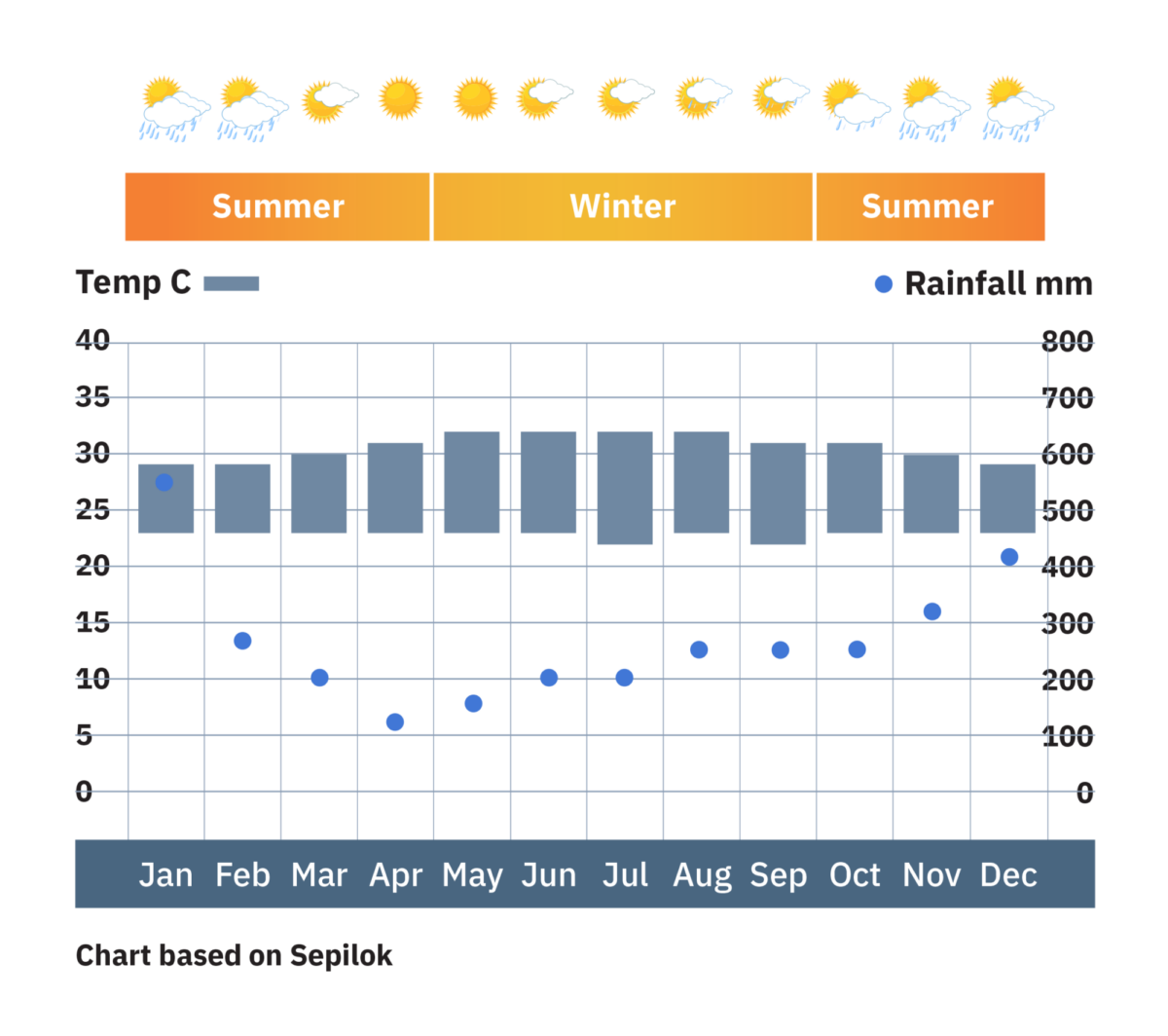
Climate and seasons for Sepilok
Featured Trips
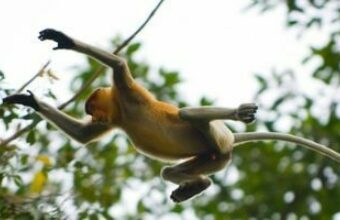
Borneo Adventure Tours
Guided wildlife tours to the rainforests of borneo.
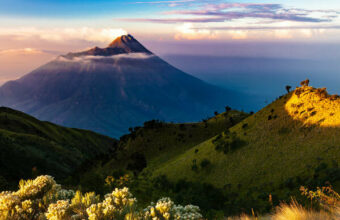
Indonesia Wildlife Cruise
In search of orangutans and dragons, when to see orangutans in borneo, weather, seasons and conditions.
Orangutans are non-migratory and generally speaking you can see wild orangutans at any time of year. Your main consideration will be the weather conditions and flight prices.
Orangutan behaviour
While visiting rehabilitation centres guarantees you will see some orangutans, the real appeal for many visitors is to spot them in the wild.
Centres like Sepilok operate feeding platforms in the reserves where they put out food daily for their released orangutans to return to. This is a great way to see semi-wild orangutans, although it is not guaranteed. During the fruiting season, June to August, there is an abundance of available food in the forests meaning orangutans are less likely to return to the platforms.
Although, this means they will be more active in the wild as they forage for food, with optimal viewing being throughout April to August.
The climate in Borneo
January is best avoided in Borneo, as heavy rains fall over the majority of the country and most wildlife will hide away in the dense jungle. February brings drier weather in the north of the country, so head to Gaya Island or plan a trek up Kinabalu, taking advantage of the low season offers. March and April offer more dry weather, as well as the start of whale shark season for divers, which runs until May.
June, July and August are peak season on the island, with the best weather conditions but the biggest crowds and highest prices. The wildlife is very active at this point in the year – the summer months are a perfect time to see the famous orangutans and turtles native to Borneo. It is also the best time of year for diving, with excellent visibility of up to 40m on calm days. Baby turtles hatch on Turtle Island in August.
September marks the end of high season and while the weather is not as reliable, the crowds thin and there is still a good chance of sunshine in the majority of the island. Head away from the coast and travel inland to the Danum Valley and Kinabatangan River. October is similar to September but brings more frequent rain, which really takes hold in November and December. This is Borneo’s low season and can be a good time to take advantage of cheaper prices.
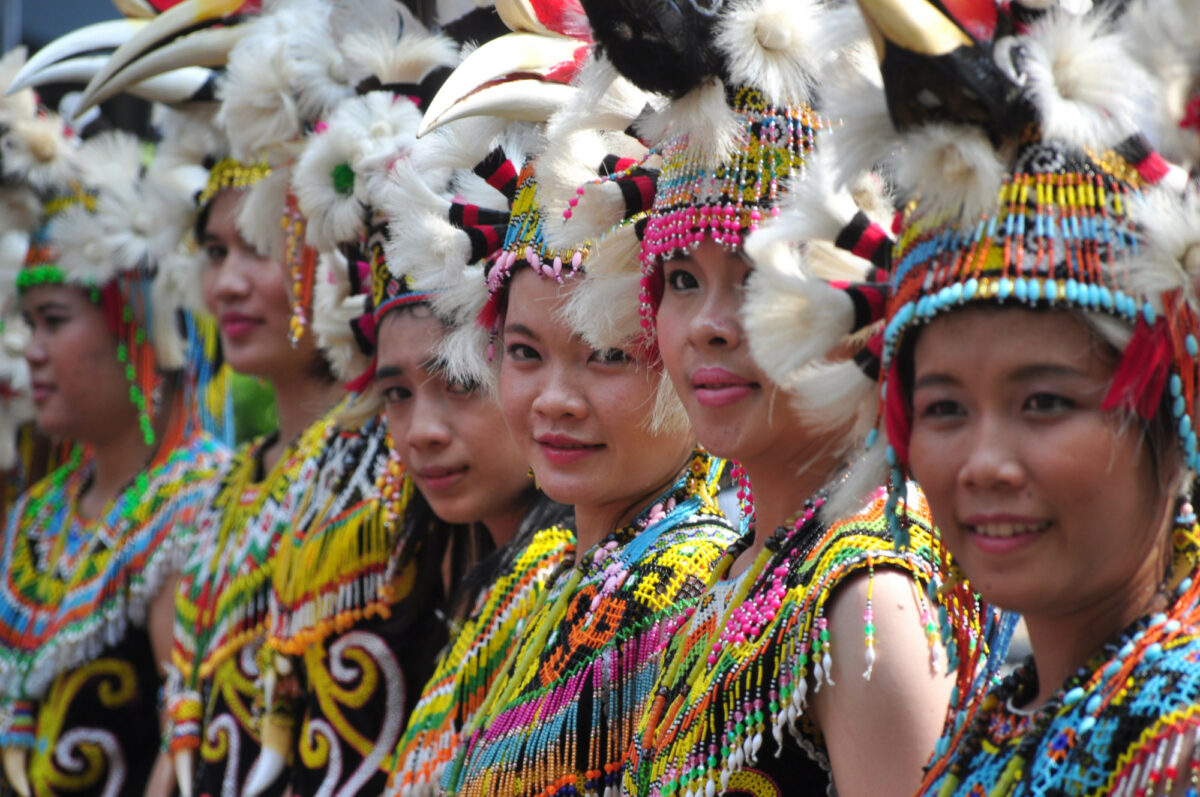
Gaway Dayak Festival in Kalimantan
Events and festivals
The heavy rains mean that the beginning of the year is quiet on the festival front, although Chinese New Year is celebrated at the end of January or start of February.
The majority of Borneo’s festivals fall in the dry season. May brings the Miri Jazz Festival to northern Sarawak, where world-famous musicians entertain the crowds, whatever the weather. The festival only allows a very small number of tickets to be purchased at the gate, so make sure to buy yours online before you go to save disappointment.
The end of May is Borneo’s Harvest Festival called Gawai Dayak. It is a national holiday in Sarawak. Beginning at sundown on May 31st, the celebrations include wearing traditional dress, sharing of food, music and even a ritual sacrifice of a chicken.
The middle of the dry season is also the high point for festival season. Head to Kuching for the Rainforest Music festival in July, where musicians from all over the world perform at this three-day festival – one of the biggest in Asia. Despite the dry season date, it is likely to be as muddy as anything Glastonbury can offer. If the mud puts you off, instead head for Sibiu, where the Borneo Cultural Festival draws 20,000 visitors each July to marvel at Borneo’s indigenous music, art and culture.
As the festival season draws to a close, don’t miss the Borneo International Kite Festival in Bintulu where teams fly complex kites over Bintulu airfield. Held in September, this festival includes cultural performances and authentic Malaysian food, making for some excellent photography opportunities. For something more cultural, visit Tenggarong in East Kalimantan for Erau, one of Indonesia’s oldest festivals. Held since the 16th century, Erau celebrates the region’s Dayak people with music, traditional dance and sporting events.
Central Asia
About the author.
Journalist-travel writer and photographer, Tamara Thiessen is an expert on Borneo with her 4th edition Bradt Travel Guide to the island due in 2020. France-Australia based, she works for newspapers, travel & leisure publications and in-flight magazines worldwide and is the author of several books
Featured tours

Orangutan Tour in Tanjung Puting National Park
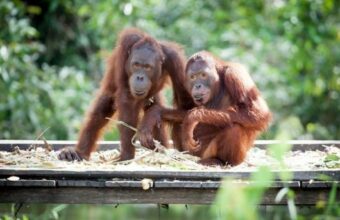
Katingan River & Sebangau National Park
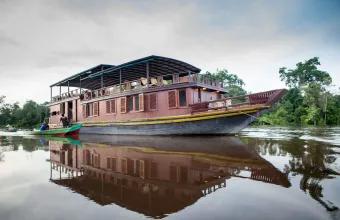
Orangutan & Dayak Village Cruise
Featured tours view all.

Why Horizon Guides?

Impartial travel guides
Our guides are written by the leading experts in their destinations. We never take payment for positive coverage so you can count on us for impartial travel advice.

Expert itineraries
Suggested itineraries and routes to help you scratch beneath the surface, avoid the tourist traps, and plan an authentic, responsible and enjoyable journey.

Specialist advice
Get friendly, expert travel advice and custom itineraries from some of the world's best tour operators, with no spam, pressure or commitment to book.
Our guides are 100% impartial and are written by independent, professional travel journalists. We make money by charging carefully-screened travel companies to list their business on our website. Our advertisers have no influence on our editorial content and we never accept payment for positive coverage.
Read more about how we work and what we believe in here .
- Travel guides
- Work with us
Sitemap , Privacy Copyright © 2024 Horizon Guides

Orangutan Adventure Tours
The Orangutan Project offers a range of wondrous tour options to suit all tastes and budgets. To enquire about one of our tours please contact us . "Looking for a holiday that will become the experience of a lifetime? Why not come with me on an orangutan adventure, connect with the most intelligent fellow beings on the planet, meet the people working on the ground to save them, and help become part of the solution!" – Leif Cocks
Orangutan Odysseys Tours
There really is nothing like giving back. In our specially crafted expeditions you will visit the habitat of the great orangutan and at the same time help protect the environment for generations to come. Since 2009 Orangutan Odysseys has raised vital funds for The Orangutan Project to support vital conservation projects across Indonesia and Malaysia.
Orangutan Odysseys combines adventure and educational tours in Indonesia and parts of Malaysia to support conservation efforts for the survival of orangutans and the protection of their habitat. Tourism is urgently needed to bring awareness and resources to these regions. Our mission is to provide unforgettable real-life experiences while supporting local nonprofits engaged in keeping orangutans and their habitat safe.

When you travel with Orangutan Odysseys, a portion of the proceeds goes directly to orangutan care centres in the areas you visit. It’s the adventure of a lifetime that also makes a difference.Whether you’re taking boat tours up remote rivers or treks into mist-covered mountains, we offer unforgettable experiences that respect the environment and are mindful of the local human and non human inhabitants. Orangutan Odysseys offers one-of-a-kind expeditions to help save our endangered great apes.
For information on the full range of tours to Borneo and Sumatra available through Orangutan Odysseys visit:
Orangutan Odysseys
Country selection
We've detected you are coming from a location outside of Australia .
Please choose one of the following:

For wildlife, adventure & culture lovers
Borneo orangutan survival.
Visit the Borneo Orangutan Survival sanctuary. An experience of a lifetime, to get up close with these beautiful primates and find out how they are prepared to return to their natural habitat.
At Samboja, you can visit the Borneo Orangutan Survival (BOS) sanctuary. An experience of a lifetime, to get up close with these beautiful primates. The BOS Foundation is currently taking care of around 750 orangutans in a conservation area of some 80 km2. The orangutans have been rescued from areas of conflict, where they lost their natural habitat. You can witness the orangutans in the conservation area at several orangutan islands at feeding times.
In the sanctuary, you can also learn how the orphaned orangutans are equipped with the skills they need to survive once they are old enough to be reintroduced in the forest. In fact, they go to orangutan school and learn the skills of building nests, selecting foods, and recognizing predators. Some of the orangutans will not return to the forest due to illness or injury. They stay in the sanctuary and get long term care.

When visiting the orangutan sanctuary you can select from several tour options including visits to sunbear sanctuary, bukit bangkirai and boating activities on the Black River. You can stay overnight at the sanctuary in the beautiful Samboja lodge.

BOS offers some programs to visitors to get close to the orangutan as well as to get fresh air in the forest. Among others are feeding time orangutan, adoption baby orangutan and forest school, being volunteer to help caring the environment and provide food for orangutan as well as tracking to the forest, bird watching and planting adoption trees to support forest restoration program. From this place, you will know that unlike other great apes in Africa, orangutan spends far more in the trees and does not live in group. Orangutans are renowned for their intelligence; some have been discovered using tools, and they have been observed using leaves to make rain hats and as waterproof covers for their nests.
BOS also manage sun bear sanctuary. Around 50 sun bears are currently under their care. The sun bear, which is native to the tropical rainforest in Borneo, is the smallest species of bears in the world. They are threatened and displaced from their natural habitat by human activity. You can observe these unique bears from special viewing platforms and learn about their life, habitat and behaviour.
What to see and do?

Tree planting and research

Cut the weeds with a machete and find the best places to plant different varieties of native trees. A fulfilling and educational activity to restore the habitat of Borneo’s wildlife.
Fishing Semayang lake

Join the local fishermen and go fishing on Semayang lake in the estuary of Makam river. Enjoy the sunset at one of the largest lakes in the country.
Swimming swamp buffaloes

Witness hundreds of Borneo swamp buffalo on their morning swim in the river. It is a spectacular daily routine and part of the buffalo farming in the Mahakam upriver area.
Bird watching

In the rainforest of Kutai Kartanegara you have beautiful possibilities for bird watching. For example in the wetland areas of Black River in Samboja or the nature reserve of Muara Kaman, upstream the Mahakam.
Spot the rare river dolphin

Ride a boat in the beautiful Borneo nature reserve of Muara Kaman and go on the look out for the rare river dolphin. In the meantime, enjoy proboscis, long tail monkeys and exotic birds ashore.
Boating black river

In the immediate vicinity of Bukit Bangkirai, you can experience the Borneo jungle by boating the rainforest river of Sungai Hitam. This is the so-called Black River, one of the wetland areas in East Kalimantan.
Biking trails

When you prefer to go by bike instead of by foot, you can rent an all terrain bike (ATB) and explore the rainforest through some exciting biking tracks.
Jungle trekking

To add to your Borneo adventure, you can go for jungle trekking at Bukit Bangkirai. There are various nature trails available which lead you to the heart of Borneo jungle.
Canopy walk

At Bukit Bangkirai, you can enjoy the tropical rainforest of Borneo through a canopy bridge at a height of 30 metres from the ground!
Sunbear sanctuary

Visit one of the most threatened bear species in the world. You can experience the sunbear, which is native to the tropical rainforest in Borneo, from special viewing platforms.

Pin It on Pinterest

- Protecting Apes
- Animal Welfare
- Apes as Pets
- Animal Rescue
- Animal Charities
- Meet the Orangutans
- Orangutans In Memoriam
- About Orangutans
- Meet the Chimpanzees
- Chimpanzees In Memoriam
- About Chimpanzees
- Enrichment & Sponsorships
- Adopt an Ape
- Monthly Giving
- Great Ape Society
- Legacy & Planned Giving
- Donate with Cryptocurrancy
- Other Ways to Give
- The Sanctuary
- Our Organization
- Education and Outreach
- News & Events
- Internships
Meet our Founding Orangutan, Pongo
Center for great apes.
The Center for Great Apes' mission is to provide a permanent sanctuary for orangutans and chimpanzees who have been rescued or retired from the entertainment industry, from research, or from the exotic pet trade.
The Center for Great Apes is a 501(c)(3) accredited organization
Meet the apes.
Orangutans and chimpanzees are endangered species and the Center for Great Apes is the only accredited orangutan sanctuary in the nation. We invite you to meet the apes, learn their stories and find out how you can help us in our vital mission.
We Need Your Help
As the only accredited orangutan sanctuary in the country and one of a handful of accredited chimpanzee sanctuaries, the Center for Great Apes has been rescuing great apes for 30 years. The Center for Great Apes does not receive funding from the federal or state governments. We are supported by donations from generous people like you, who care about the future of our orangutans and chimpanzees (both endangered species).
Affiliations

P.O. Box 488 Wauchula, FL 33873 Phone: 863 767-8903 Fax: 863 767-8904 Email: [email protected]
The Sanctuary FAQs History Our Team Leadership E-Newsletter
Meet the Apes
Chimpanzees Orangutans Donate Adopt an Ape Great Ape Protection
You Can Help
Donate Adopt an Ape Volunteer Education Outreach Visit Our Online Store
Center for Orangutan and Chimpanzee Conservation, Inc. dba Center for Great Apes is a 501(c)(3) nonprofit organization, FEID 65-0444725.
© 2020 Center for Great Apes. All Rights Reserved.
Advertisement
18 Tropical Rainforest Animals You Should Know
- Share Content on Facebook
- Share Content on LinkedIn
- Share Content on Flipboard
- Share Content on Reddit
- Share Content via Email
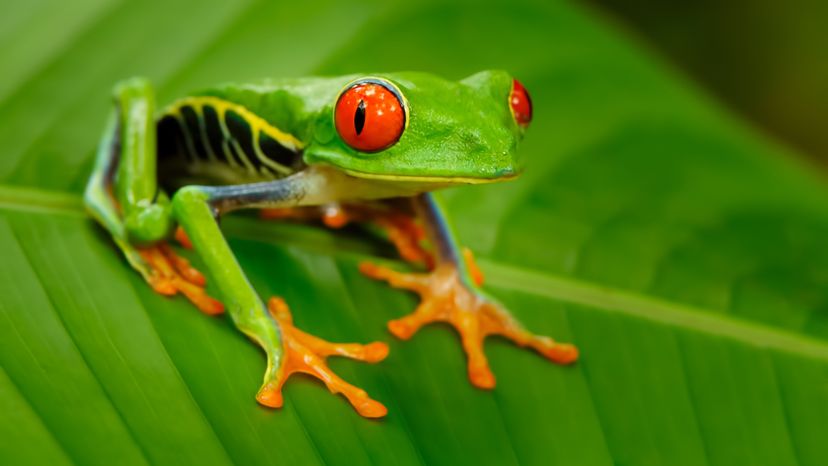
A rainforest is simply a forest that receives a lot of rain. But when you think "rainforest," the image that comes to mind is probably a tropical rainforest: one located near the equator, between the Tropic of Capricorn and the Tropic of Cancer .
The combination of year-round sunlight, warmth and rainfall is what creates the biodiversity of amazing rainforest animals found in the tropical rainforests of Africa, Asia and Central and South America. From the forest floor to the canopy layer, these regions are full of colorful and curious creatures.
6 Famous Rainforest Species in Central and South America
4 iconic rainforest animals in asia, 5 incredible african rainforest animals, 3 most endangered rainforest animals in the world.
Central and South America are home to the most tropical rainforests of any region. The Amazon rainforest alone is the largest tropical rainforest in the world, covering about 40 percent of Brazil and stretching into parts of Bolivia, Colombia, Ecuador, French Guiana, Guyana, Peru, Suriname and Venezuela.
Here are some of the region's best-known residents.
6. Red-eyed Tree Frog
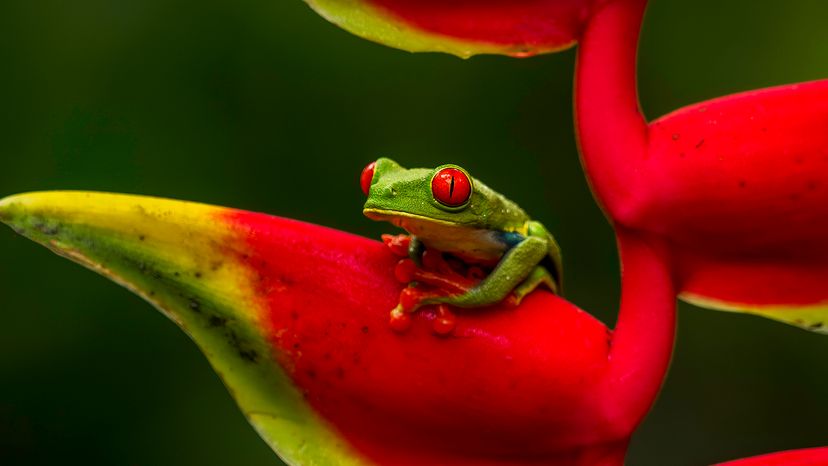
With its bright green body and red eyes and feet, the red-eyed tree frog ( Agalychnis callidryas ) might be what comes to mind when you think "frog." Frogs use their big eyes to spot their prey from all angles.
Red-eyed tree frogs live primarily in Central America.
5. Poison Dart Frog
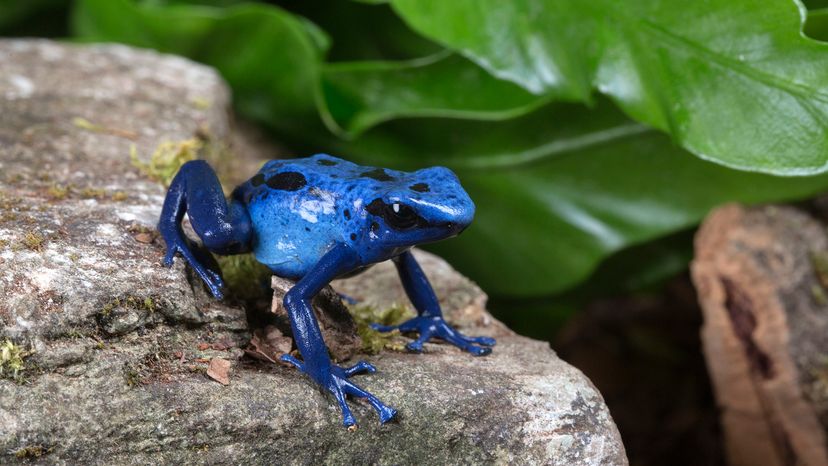
Poison dart frogs (about 180 species in the Dendrobatidae family) get their name from the fact that their poisonous skin secretions were traditionally used to coat the tips of arrows and darts. (They're also known simply as poison frogs .)
Interestingly, all frog species are technically poisonous to the touch, but members of the Dendrobatidae family are the only ones whose secretions are powerful enough for a human to notice. Poison dart frogs can be found in both Central and South America.
4. Blue Morpho Butterfly
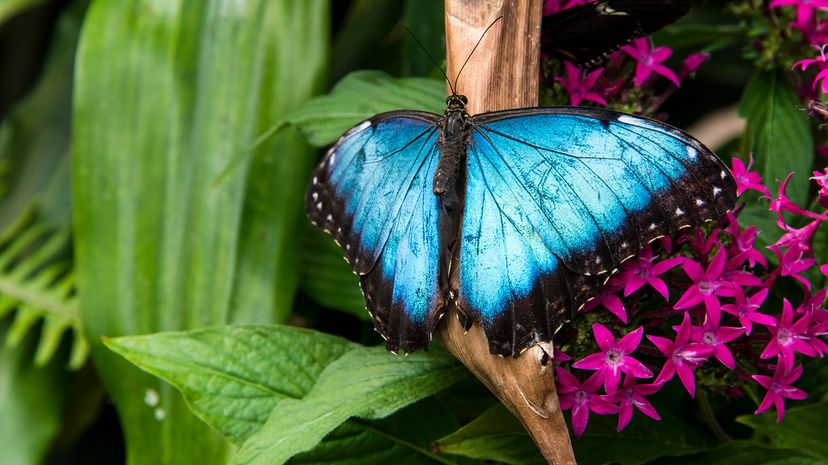
With their brightly colored iridescent wings, blue morpho butterflies (Morpho peleides and related species) are some of the most popular insects in butterfly houses at museums and zoos around the world.
But if you want to see morphos in their natural habitat, you'll have to visit the rainforests of Central and South America.
3. Emerald Tree Boa
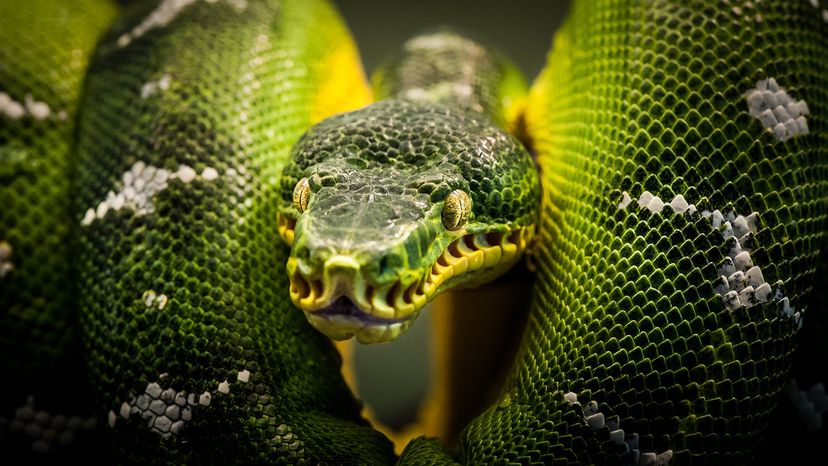
Emerald tree boas ( Corallus caninus ) are red-orange at birth; it takes at least six months for these magnificent snakes to mature and turn that bright green hue that gives them their common name.
The scientific name "caninus" apparently comes from the fact that they look like dogs in profile. Whoever came up with that one must have known some pretty unique-looking dogs.
The emerald tree boa is arboreal, meaning it spends almost its entire life in trees. It lives in the Amazon rainforest.
2. Scarlet Macaw
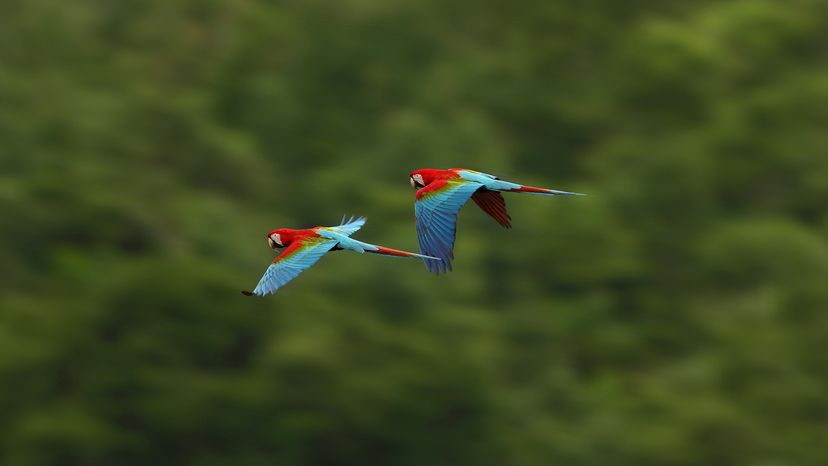
Unlike most of the animals on this list, "macaws can make wonderful pets in the right household," according to Gregory Rich, D.V.M., an avian and exotic pet veterinarian. "Macaws are playful and seem to enjoy being trained to perform tricks like waving hello or using a skateboard," Dr. Rich told HowStuffWorks .
While riding a skateboard wouldn't be particularly useful in the tropical rainforests of Central and South America, macaws' other skills — like their ability to make and imitate a variety of sounds — are crucial for life in the canopy layer.
Scarlet macaws ( Ara macao ), with their red bodies and rainbow plumage, are perhaps the best-known species of macaw (there are 17 in total).
1. Capybara
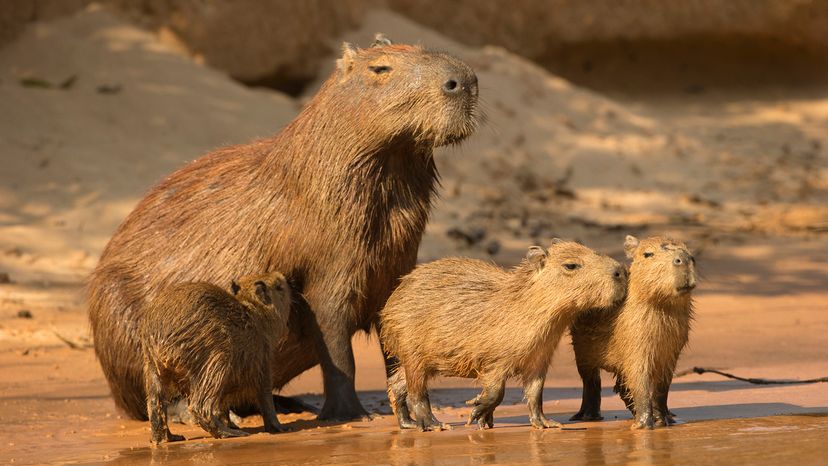
The capybara ( Hydrochoerus hydrochaeris ) is the world's largest rodent. But don't let the word "rodent" scare you away — capybaras are famously cute (they look somewhat like hairy pigs).
An adult capybara is about the size of a large dog, and they're found throughout Central and South America.
In Asia, tropical rainforests are located primarily in South and Southeast Asia, with Indonesia accounting for most of the region's tropical rainforests.
4. Bengal Tiger
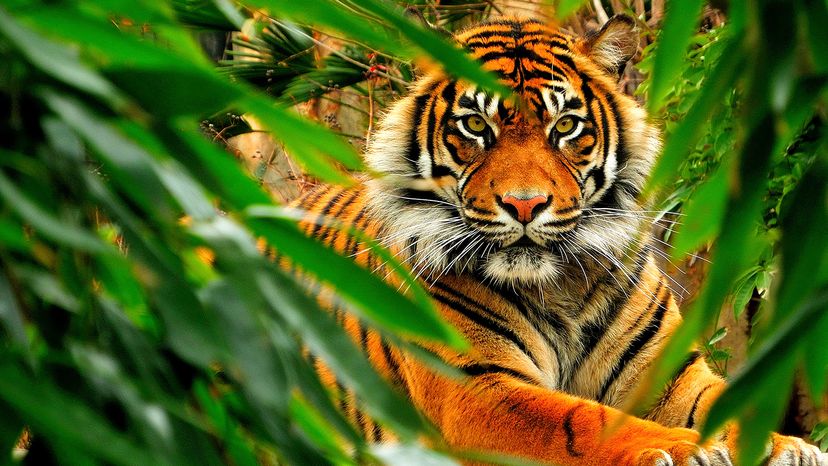
The Bengal tiger ( Panthera tigris tigris ) is the world's second-largest tiger , after the Siberian tiger. When you think "tiger," the Bengal is probably what comes to mind. This tiger subspecies has a distinctive orange coat with black stripes and white accents.
Bengal tigers occupy wetlands and rainforests of Bangladesh, Bhutan, India and Nepal.
3. Asian Elephant
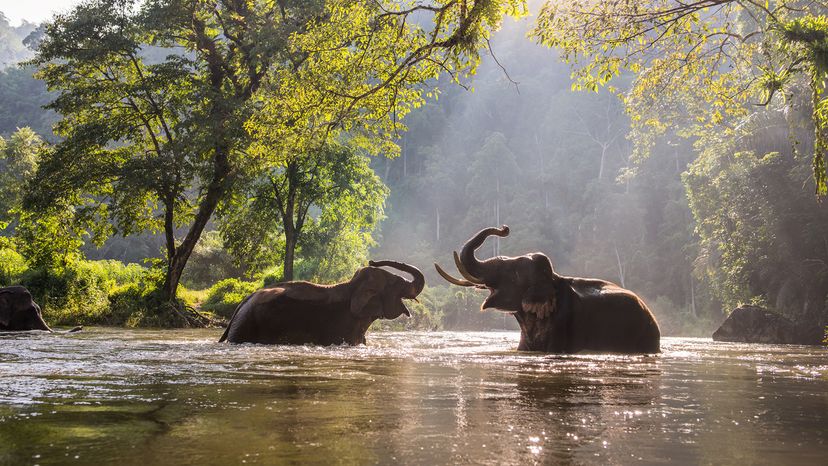
The Asian elephant ( Elephas maximus ) is found throughout South and Southeast Asia. This large land mammal — the continent's biggest — has adapted to live in a variety of environments, from grasslands to rainforest.
2. Red Panda
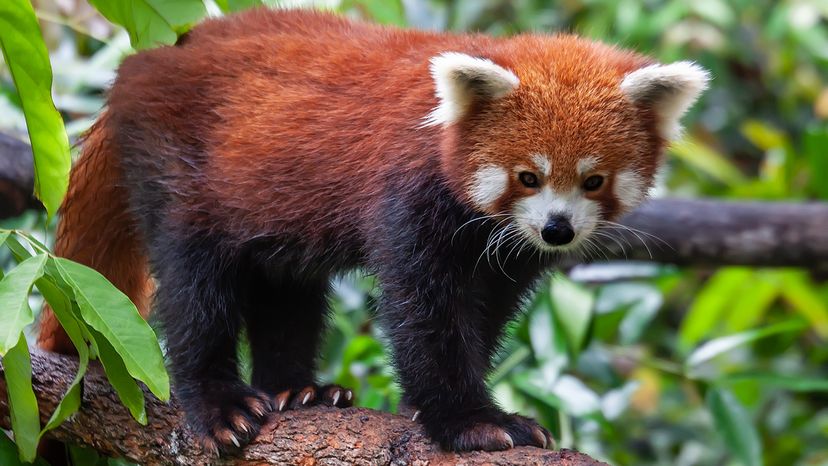
"People think [the] red panda is [a] lesser form of giant panda because of its name," Saroj Shrestha, program coordinator for the Red Panda Network in Nepal told HowStuffWorks. In fact, red pandas ( Ailurus fulgens ) aren't closely related to giant pandas ( Ailuropoda melanoleuca ).
While the giant panda is endemic to China's lowland forests, the smaller red panda inhabits rainforests in Bhutan, China, India, Myanmar and Nepal.
1. Flying Lizard
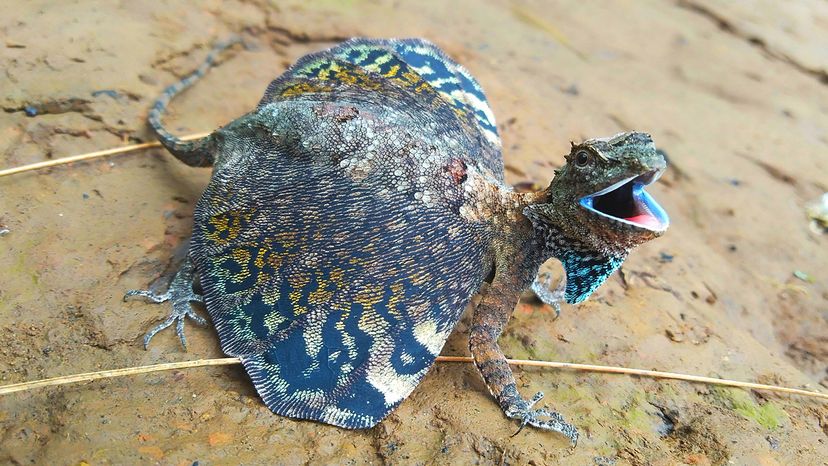
What would make a lizard grow wings and fly? For flying lizards (any of about 40 species in the genus Draco ), the ability to glide between tree tops (they don't technically "fly") provided an evolutionary advantage for life in the tropical rainforests of Southeast Asia.
Their "wings" are actually scaly membranes located between their front and back legs. Like a butterfly, a flying lizard's wings are often much more colorful than its body.
Africa is more than just the Sahara Desert. The Congo Basin in East-Central Africa is home to most of the continent's tropical forests and some of its most famous animal species.
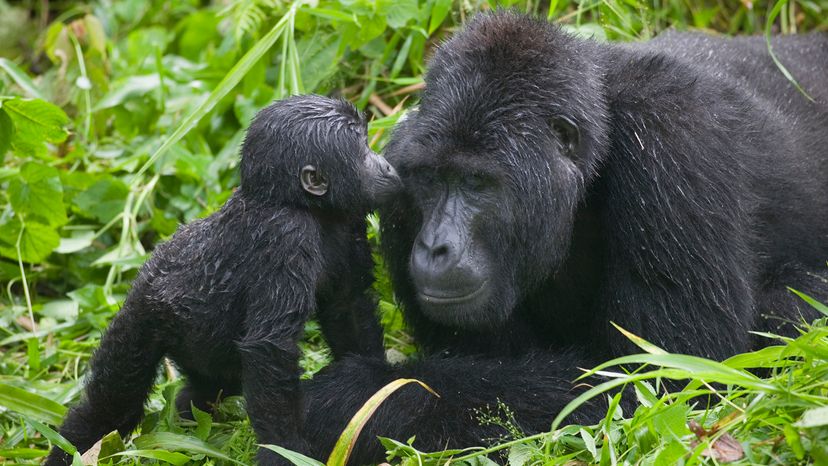
There are two gorilla species: the Eastern gorilla ( Gorilla beringei ) and the Western gorilla ( Gorilla gorilla ), both of which live in African rainforests. These endangered primates are some of our closest living relatives (after chimpanzees and bonobos).
4. African Leopard
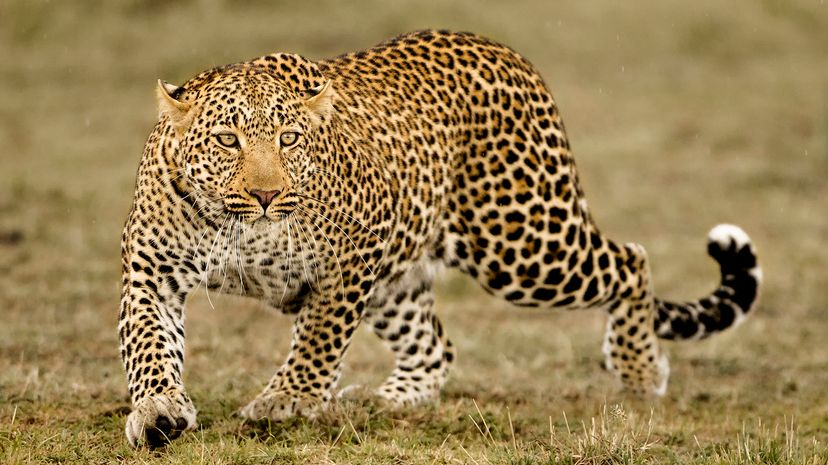
The African leopard ( Panthera pardus pardus ) is the most numerous leopard subspecies, with around 700,000 individuals occupying Sub-Saharan Africa. The African leopard is suited to a wide range of habitats, including tropical rainforests.
3. Chimpanzee

The chimpanzee ( Pan troglodytes ) is tied with the bonobo ( Pan paniscus ) as the primate most closely related to humans. (We share 98.7 percent of our DNA with this member of the great ape family.)
Chimpanzees are found throughout Central and West Africa and are adapted to many climates, but many groups are found in tropical rainforests.
2. Green Mamba
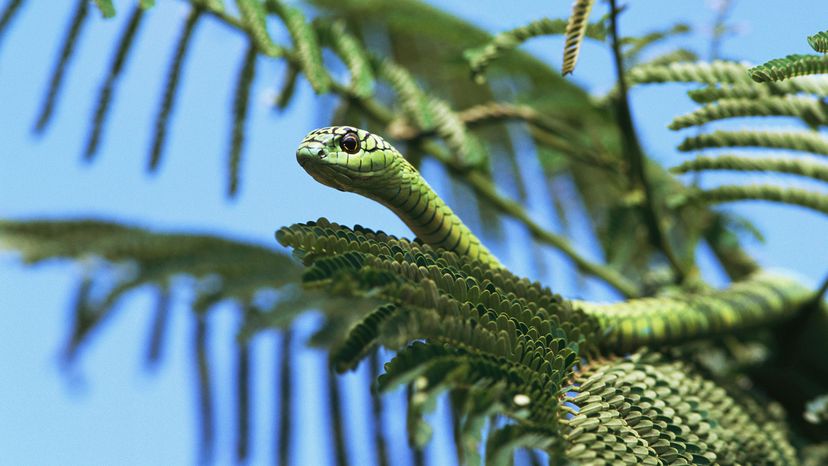
The black mamba ( Dendroaspis polylepis ), one of the world's deadliest snakes , gives other mambas a bad rap. But the tree-dwelling green mambas (three species of Dendroaspis ) have not been known to attack humans. (They are venomous, though, so don't mess around with a green mamba, either.)
Both black and green mambas are native to Africa, but black mambas live in rocky Savannah environments while green mambas prefer rainforest habitats.
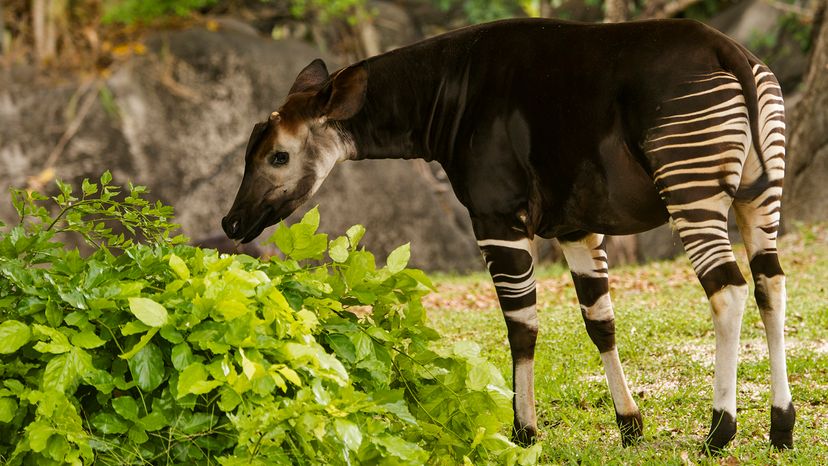
"The okapi was once referred to as being as 'mythical as a unicorn,' a striped, donkey-like beast of the rainforest," Rick Schwartz, a global ambassador for California's San Diego Zoo , told HowStuffWorks. But the okapi isn't legendary, it's just good at hiding.
Although it looks more like a zebra, the okapi's closest relative is actually the giraffe.
It's hard to say which rainforest animals are the "most" endangered species. But these three critically endangered species just might be some of the rarest and most vulnerable animals on Earth.
3. Sumatran Orangutan
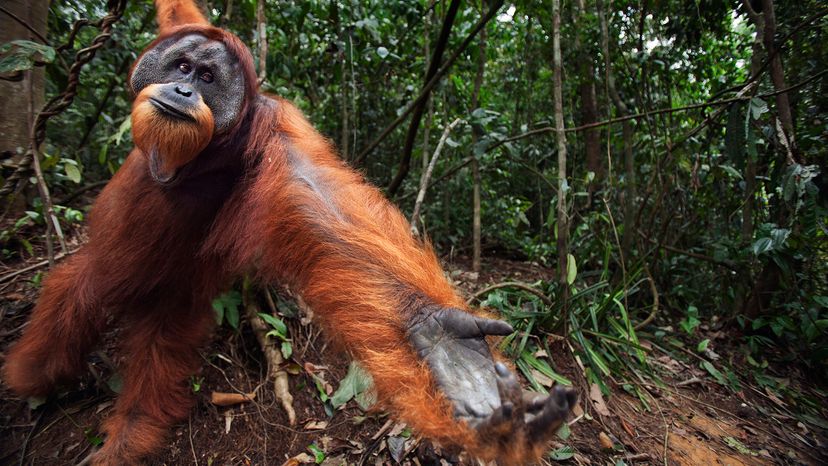
The Sumatran orangutan ( Pongo abelii ) lives in the rainforests of Sumatra, where it has developed long arms ideal for swinging between trees in the rainforest canopy. Sadly, these special apes are critically endangered due to the conversion of their habitat into palm oil plantations.
2. African Forest Elephant
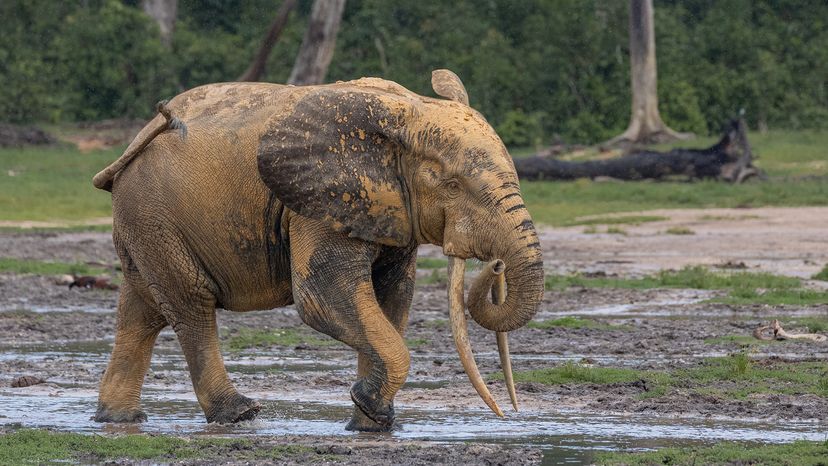
In the early 21st century, researchers discovered that the African forest elephant ( Loxodonta cyclotis ) was genetically distinct from the African savanna elephant ( Loxodonta africana ). These famously elusive elephants can be found in tropical rainforests from Senegal to the Democratic Republic of the Congo.
1. Spider Monkey
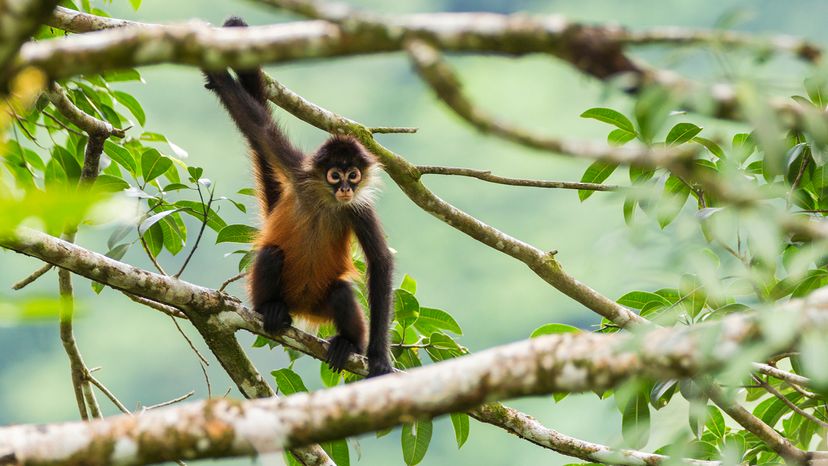
Spider monkeys (genus Ateles ) are nimble primates who spend the majority of their lives in the rainforest canopy. Found in both Central and South America, spider monkeys are some of the world's most endangered primates.
"The main threat is habitat destruction," Filippo Aureli, research professor at Universidad Veracruzana, told HowStuffWorks. "In some areas, they are also threatened by the illegal pet trade." (Here's why monkeys should never be pets .)
Please copy/paste the following text to properly cite this HowStuffWorks.com article:

IMAGES
VIDEO
COMMENTS
Borneo and Sumatra aren't only the best places to see orangutans - they are the only places you can see them in the wild. Both Sumatra and the Indonesian region of Kalimantan, in Borneo, are somewhat more intrepid destinations, while the Malaysian provinces of Sabah and Sarawak are easier to get around, with several sanctuaries to increase your ...
Most visitors, to Borneo in particular, will be sure to pay a visit to one of its superb orangutan sanctuaries. These centers provide medical attention and rehab for orangutans, which are subsequently able to live in semi wild conditions in tracts of private forest. As there are daily feeding sessions, when the animals have the option to ...
Orangutans usually have a single baby, and twins are rare. Gestation is seven-and-a-half to eight-and-a-half months. From birth, orangutan infants cling to their mothers as they maneuver through the trees. The orangutan has the longest period of dependence on the mother of any other land-dwelling animal, including humans.
The cost of Sumatra orangutan trekking tours in Bukit Lawang can vary depending on the length of the trek. On average, this is what trekking tours to see Sumatra Orangutans cost: A half-day (3 hrs) trek can cost around 700,000 IDR / 45 USD. 1 Day Trek (6-7 hrs trekking) can cost 900,000 IDR / 59 USD.
The Borneo Orangutan Survival Foundation has a rehabilitation centre at Nyaru Menteng, 28km north of Palangkaraya, which can only be visited with a permit acquired in advance. Home to over 300 orphaned and displaced orangutans, the visitor centre here is open on Saturdays and Sundays, from 9 am-5pm.
February, 1 2024. Orangutan Foundation International (OFI) is greatly saddened by the passing of Norman Lear, a legendary television and film producer and writer, as well as longtime friend of OFI. Norman was 101 years old when he died at home on December 5, 2023. We extend our deepest sympathies to his family and loved ones.
Orangutans are only found naturally on Borneo and Sumatra, yet each year, thousands make the pilgrimage on orangutan vacations to see the dwindling numbers that remain. The lure of seeing something so unique and intelligent is powerful, and each visit to a sanctuary, rehabilitation center or remaining tract of virgin rainforest supports the ...
View Map. Address. KM 20, Borneo Highland Road, 93250 Kuching, Sarawak, Malaysia. Phone +60 82-618 325. Web Visit website. The Semenggoh Wildlife Rehabilitation Centre, just 12 miles from Kuching, is the best place to find orangutans in Sarawak.
There are actually two places left in the world where you can see Orangutans in the wild: Sumatra and Borneo. The Sumatran Orangutans are more rare vs. the Bornean Orangutans. The best place to see them in their natural habitat is in Bukit Lawang in North Sumatra, Indonesia.
FAQs. The best place to see orangutans is in the wild, on their native islands of Borneo and Sumatra. In Borneo, orangutans are found in the two Malaysian states of Sabah and Sarawak, and in Kalimantan on the Indonesian side of the island. There is also a population on the nearby Indonesian island of Sumatra.
The Great Projects are proud to offer the opportunity for you to visit the orangutans in Borneo on any one of our many orangutan projects: spend time at the Samboja Lestari Orangutan Sanctuary to volunteer with our arboreal cousins; pay a visit to the world-famous IAR Sanctuary in Indonesian Borneo; or make a difference when visiting orangutans ...
A trip along the Kinabatangan River - the second longest river in Malaysia - is another key place to spot orangutans where over 1,100 live. Yet it is significantly harder to spot them as they are rather elusive and the rainforest here is very dense. We saw two orangutans at our lodge, far along the Kinabatangan River.
Bukit Lawang is quite possibly the most famous tourist spot in Sumatra. It is the only place in the jungle where you are ALMOST guaranteed to see an orangutan. Around a three-hour drive from Medan, the journey is straightforward. (Find out more in our detailed blog: How to Get to Bukit Lawang ). Up until 2005, Bukit Lawang served as a "soft ...
Most visitors, to Borneo in particular, will be sure to pay a visit to one of its superb orangutan sanctuaries. These centres provide medical attention and rehab for orangutans, which are subsequently able to live in semi wild conditions in tracts of private forest. As there are daily feeding sessions, when the animals have the option to ...
A vast and dense rainforest that spans over four thousand square kilometres, Tanjung Puting is full of wild orangutans who love the tree tops and swampy mangroves. The best way to get a great view of wild orangutans is to travel down the Sekonyer River on a Klotok. A Klotok is a type of river houseboat, used by locals to transport goods up and ...
To get a better picture, a basic 2-day, 1-night package booked through a travel agency will usually include a visit to the Sepilok Orangutan Rehabilitation Center, the drive to Sukau (where you stay overnight, the start of a river cruise or a jungle trek), a 3-hour boat trip on the Kinabatangan River in the early afternoon and one later in the ...
Quick guide: Best times to see orangutans in Borneo. Best months: May-June. Peak tourism season: July & August. Best weather: March-July. Worst weather: January. Sitting astride the equator, Borneo has a warm, tropical climate. Although it is broadly possible to separate Borneo's climate into the usual two seasons for the region — wet and ...
When you travel with Orangutan Odysseys, a portion of the proceeds goes directly to orangutan care centres in the areas you visit. It's the adventure of a lifetime that also makes a difference.Whether you're taking boat tours up remote rivers or treks into mist-covered mountains, we offer unforgettable experiences that respect the environment and are mindful of the local human and non ...
the facts. At Samboja, you can visit the Borneo Orangutan Survival (BOS) sanctuary. An experience of a lifetime, to get up close with these beautiful primates. The BOS Foundation is currently taking care of around 750 orangutans in a conservation area of some 80 km2. The orangutans have been rescued from areas of conflict, where they lost their ...
The Center for Great Apes' mission is to provide a permanent sanctuary for orangutans and chimpanzees who have been rescued or retired from the entertainment industry, from research, or from the exotic pet trade. ... Visit Our Online Store. Follow Us. Center for Orangutan and Chimpanzee Conservation, Inc. dba Center for Great Apes is a 501(c)(3 ...
Orangutans are only found naturally on Borneo and Sumatra, yet each year, thousands make the pilgrimage on orangutan holidays to see the dwindling numbers that remain. The lure of seeing something so unique and intelligent is powerful, and each visit to a sanctuary, rehabilitation centre or remaining tract of virgin rainforest supports the ...
There are three popular centres you can visit: Sepilok Orangutan Rehabilitation Centre is a 40-minute drive from Sandakan in Sabah. It is the largest rehabilitation centre in the world and has 43 km of protected rainforest for 60-80 orangutans to live in and hopefully leave once they're ready to fend for themselves in the world;
This red-eyed tree frog in Costa Rica is just one of the many different animals you can find in rainforests around the world. Dan Mihai / Getty Images. A rainforest is simply a forest that receives a lot of rain. But when you think "rainforest," the image that comes to mind is probably a tropical rainforest: one located near the equator, between the Tropic of Capricorn and the Tropic of Cancer ...